| Shortcuts to different P.O. sections : | (not on this page) | ||||||||||
| Sending Forms | Telegram Delivery Problems | Receipts | Envelopes | Time Signals |
Imperial Cables. |
Imperial Wireless |
Imperial & International |
Cable & Wireless |
Miscellaneous. | Delivery Forms. | Telephones. |
| Private Telegraph Companies (Post 1870) on this page : | Other | Shortcuts to different Non-P.O. sections (not on this page) : | |||||||||||
| Anglo-American | Direct Spanish | Great Northern | Griffiths | Indo-European | International Marine Radio | Marconi | Western | Reuter's | Army Telegraph Forms | Private Telegraph Forms | Railway | Eastern | Other Countries |
My Note: Whilst, with a lot of help, I have made a good start covering the Stationery of the Private Telegraph Companies,
I have big gaps in other areas. If I am missing your area of interest, then if you can supply images, I am prepared to illustrate them here, giving due credit of course.
Edward Coombes has helped a lot with the unstamped forms, so that is now looking good, and Jim Hammond has added Griffiths and Indo-European.
More recently, David Huggins (son of Alan Huggins) has allowed the use of images of the stamped 'Kings' forms.
To help find things from just the L&H TP numbers, I provide this index.
The references below are for Queen Victoria. For other numbers, see under Kings.
| TP1 - TP4ab | TP4b - TP4da | TP5 | TP6 - TP8b | TP9 - TP10b | TP11aa - TP14b | TP15aa - TP16bb | TCP1 | TP35 - TP42d | TP55 - TP58bb | TP61a - TP61bb |
| Shortcuts to different QUEEN VICTORIA sections | |||||
| Stamped Telegraph Form A. | Stamped A1 Forms | Postal Telegraph Cards | Stamped A1 |
Stamped A |
Stamped A |
Essays were prepared in 1868 for stamps to prepay telegraph charges.
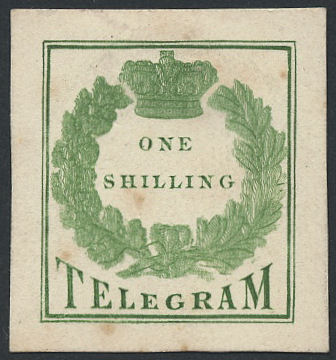
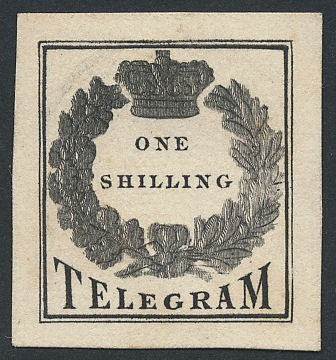
This type is known in green and black and a similar type with the Queens head at the centre facing right in the same colours is also known.
These were not adopted. Instead it was decided to adapt the octagonal design used for postage stamps and stationery.
Illustrations from Langmead & Huggins' book (Colour Plate 7), courtesy of the
Great Britain Philatelic Society.
Telegraph forms using 1s embossed stamps were available 5th February 1870. The date plugs on this indicate the date of printing.
The 6d became available from October 1885 after the rate was reduced. The 10d for international use,
was initially printed in blue (April 1889) to distinguish it from postal use, but reverted to brown in 1892.
An example is shown below.
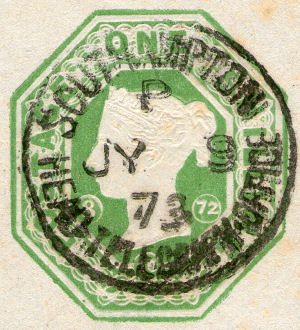
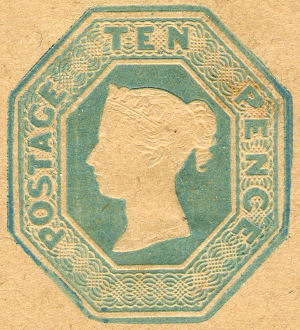
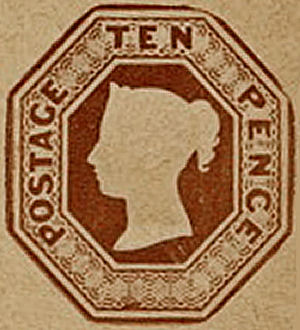
The 6d started with date plugs, but later the date plugs were replaced by 'florets' (with 5 or 9 dots) and later still disappeared entirely.
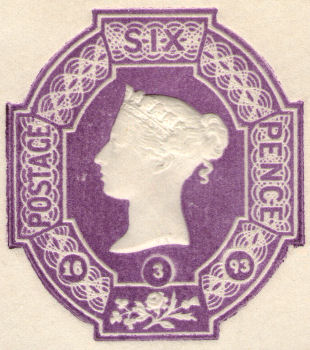
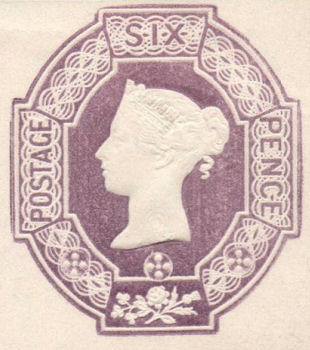
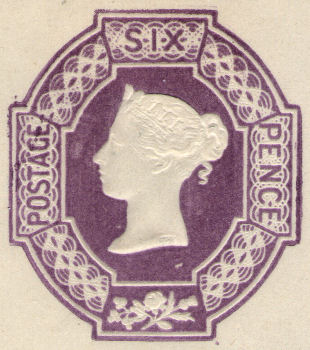
|
This has date plugs of 6 / 10 / 85 |
|
|
| TP4b | Imprint ‘Millington & Hutton, Manufacturing Stationers, London’ in parentheses and in two lines at bottom right. |
| TP4c | Imprint ‘Millington & Hutton, Wholesale Stationers, London’ in one line at bottom right. |
| TP4d | Imprint ‘Millington & Hutton, Manufacturing and Wholsale Stationers, London’ in one line at bottom centre. |
| TP4da | As TP4d, but with red PRIORITY below stamp. |
Printing Dates TP1/2 (19.10.69 — 4.3.70); TP3 (28.9.71 — 11.11.71); TP4aa (6.6.72 — 9.10.72); TP4ab ?TP4b (23.10.72 — 27.11.72); TP4c (7.5.73 — 21.4.74); TP4d (26.11.73 — 8.8.74)
Similar forms to the last (L & H designation TP4), but the backs are blank.
On these, the embossed stamp is in the box below , with the text having the word "extra" removed.
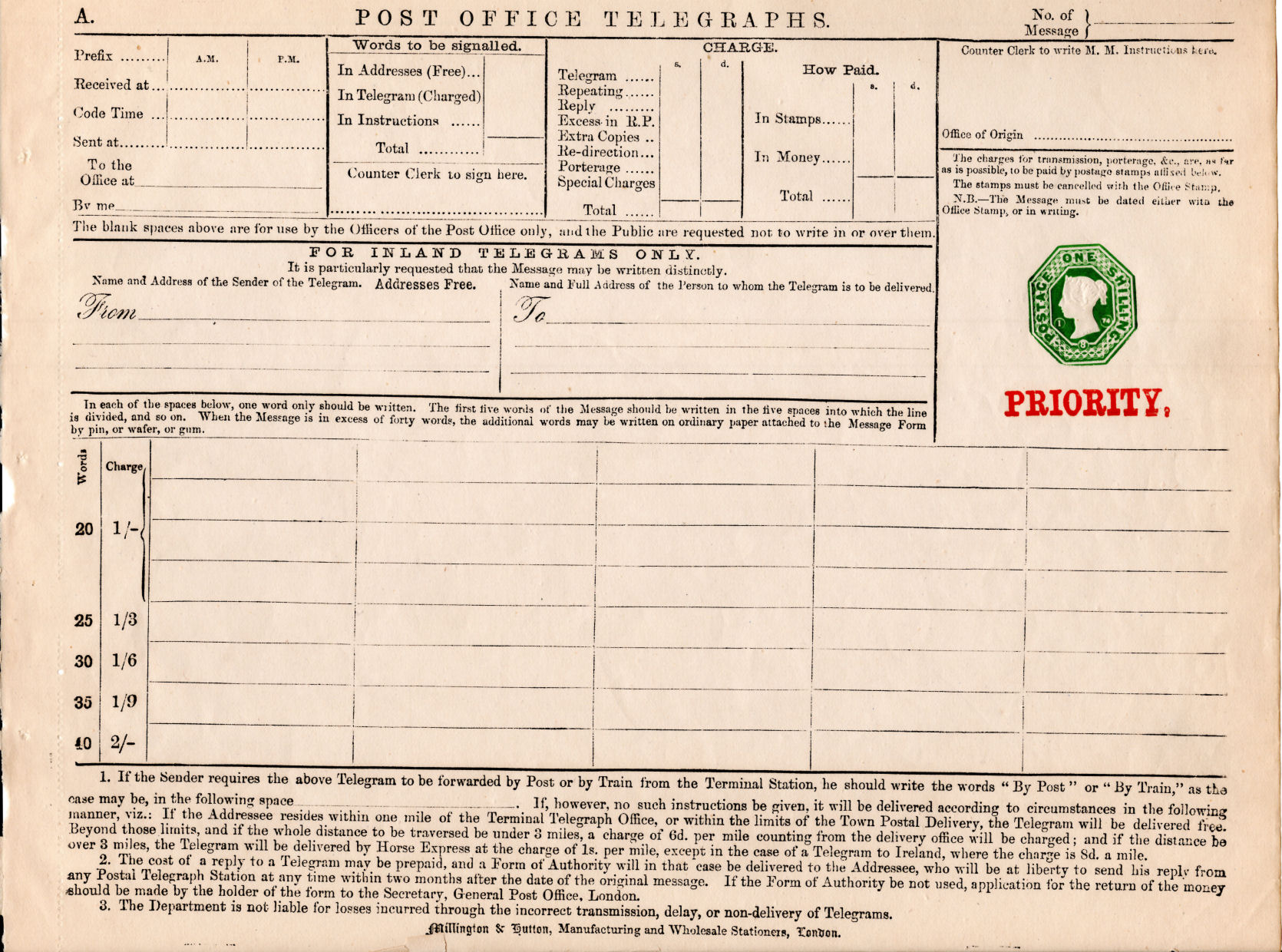
Form. A 1s green PRIORITY Post Office Telegraph Form (date plugs read 1/8/74, nothing on the back).
Printed by Millington & Hutton, Manufacturing and Wholesale Stationers, London. Nothing on the back. Image courtesy of Mark Gibson.
L & H list this on page 124 under varieties of TP4d. They say that they were intended for official use by Government departments.
Their TP4d though is given as having the rather stylized imprint on the bottom-left, though the Addendum changes that to bottom-right.
I show a similar one below without the "PRIORITY", with central imprint and date plugs of 8/8/74, which due to the confusion, I call TP4da.
1875 1s green QV octagonal dated ‘POSTAGE’ stamp with date plugs, smaller format form c.144 x 222 mm available in booklets.
These were stamped with the minimum rate for sending a telegram.
| TP5 | Form with ‘A1’; ruled for 30 words; with imprint ‘Millington & Hutton, London’; perforated at left margin. |
| TP5a | Imprint on reverse at right. |
| TP5b | Imprint central on reverse. |
A new type of round 1s version inscribed 'TELEGRAPHS' was introduced in August 1875.
These werre used on the TP6, TP7 and TP8 series of telegrams, as well as the A1![]() TP35 Stock Exchange Forms.
TP35 Stock Exchange Forms.
1875-1881 1s green QV dated ‘TELEGRAPHS’ stamp with date plugs (T1), smaller format form ruled for 30 words
PRINTED BY MILLINGTON & HUTTON WITH THREE PARAGRAPHS ON REVERSE.
| TP6a | Sold singly; imprint ‘Millington & Hutton,London’ at bottom left (1876). |
| TP7aa | Sold in booklets; imprint ‘Millington & Hutton,London’ at bottom left (1875). |
| TP7ab | Sold in booklets; imprint ‘Millington & Hutton,Wholesale Stationers, London’ central on reverse. |
PRINTED BY 'JAS TRUSCOTT, LONDON WITH THREE PARAGRAPHS ON REVERSE.
| TP6ba | Sold singly; imprint ‘JAS, TRUSCOTT & SON, LONDON’ at left: (1878). |
| TP7ba | Sold singly; imprint ‘JAS, TRUSCOTT & SON, LONDON’ at left: (1878) |
| TP7bb | Sold in booklets; imprint ‘JAS, TRUSCOT & SON, LONDON’ at left (1877). |
| TP7bc | Sold in booklets; imprint ‘JAS, TRUSCOTT & SON, PRINTERS, LONDON’ at left (1880). |
| TP6bb | Sold singly; imprint ‘JAS, TRUSCOTT & SON, PRINTERS, LONDON’ at left (1881?) |
PRINTED BY JAS TRUSCOTT, LONDON WITH SEVEN PARAGRAPHS ON REVERSE
Form A. 1. Date plugs 30/3/1881.
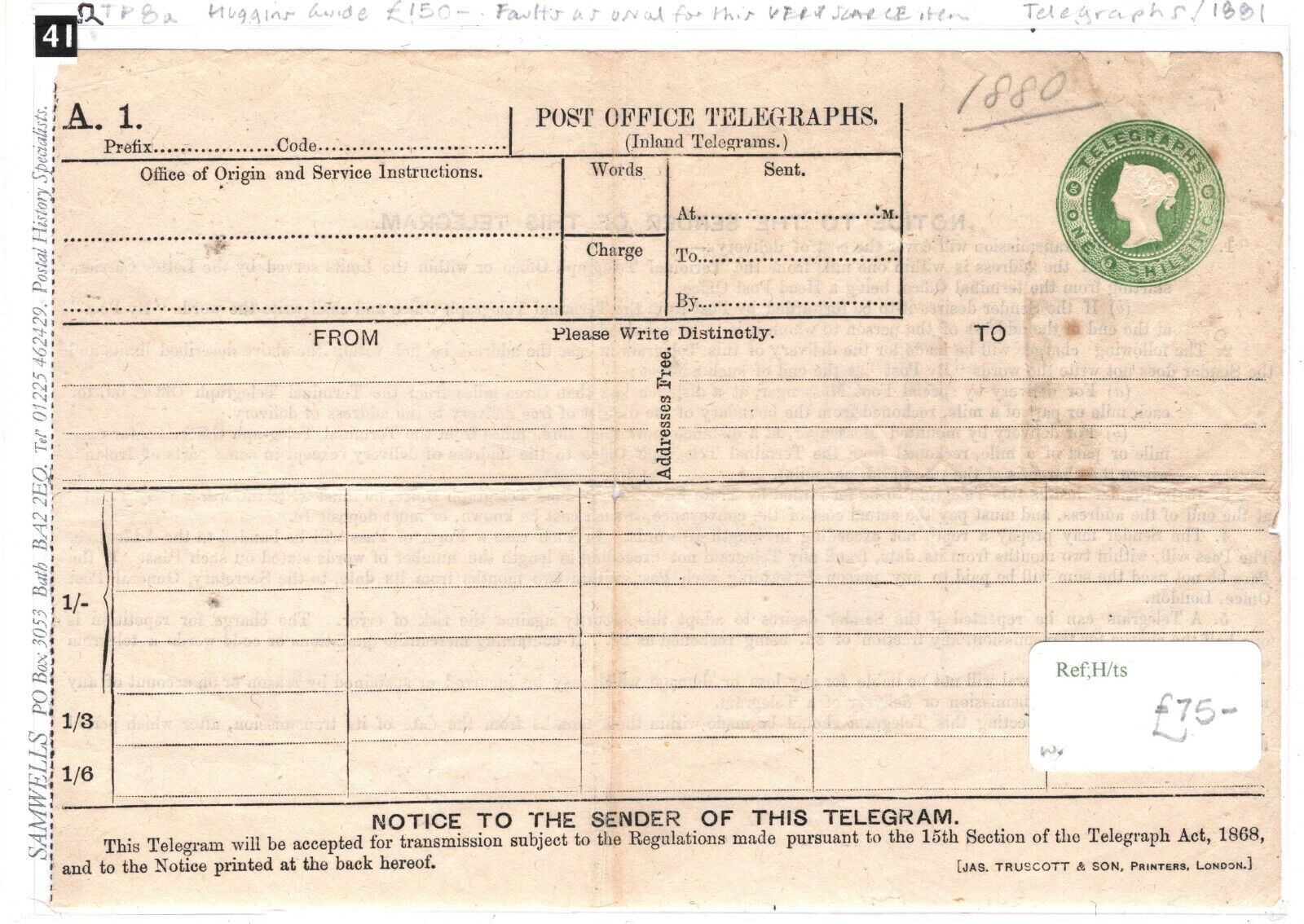
"[JAS. TRUSCOTT & SON, Printers, London.]" at bottom-right.
7 paragraphs of notices to the sender on the back.
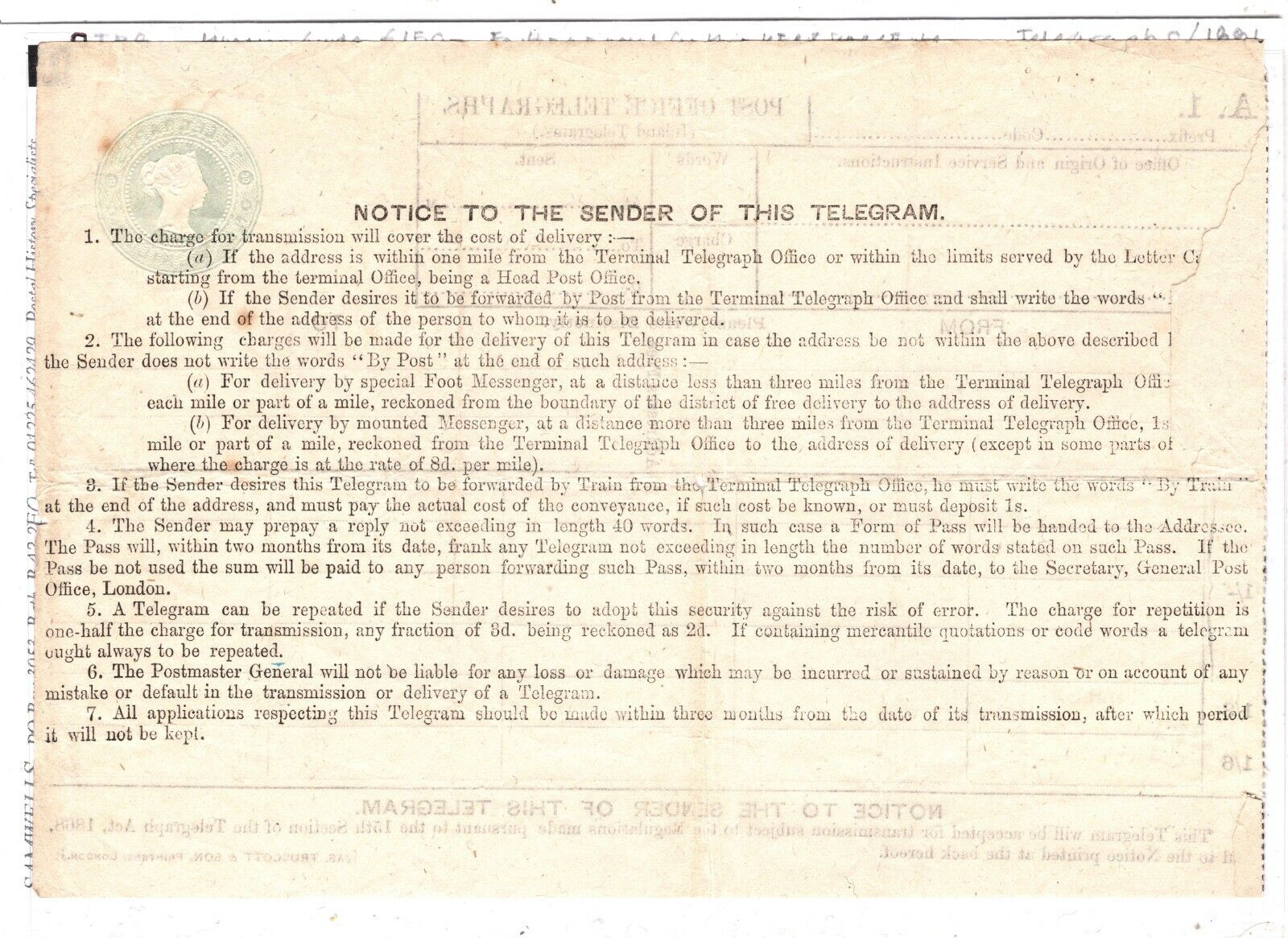
Huggins TP8a. Images courtesy of Samwells Ltd.
click image for eBay listing.
| TP8a | Sold in booklets; imprint JAS, TRUSCOTT PRINTERS, LONDON’ at right (1881). |
PRINTED BY HARRISON & SONS, LONDON WITH SEVEN PARAGRAPHS ON REVERSE
| TP8b | Sold in booklets; imprint ‘HARRISON & SONS, PRINTERS, LONDON’ at right (1881). |
Printing Dates. TP6a (13.10.76 — 14.5.77); TP6ba (11.11.78 — 24.9.79); TP6bb (30.11.80 — 14.3.81); TP7aa (6.9.75 — 24.6.76); TP7ab (5.10.75 — 10.12.75); TP7ba (11.7.76 — 24.3.77);
TP7bb (19.10.77 — 12.11.79 & 30.3.81*); TP7bc (9.6.80 — (12.3.81); TP8a (18.2.81 — 13.6.81); TP8b (12.8.81 — 3.9.81).
Varieties TP7aa without vertical dividing rule at left-hand margin perforated instead of rouletted.
1881-1885 1s green QV octagonal dated ‘POSTAGE’ stamp with date plugs (17a) smaller format form ruled for 30 words.
PRINTED BY JAS TRUSCOTT, LONDON.
| TP9a | Sold singly; imprint ‘JAS, TRUSCOTT & SON, PRINTERS, LONDON at left; three paragraphs on reverse (1881). |
| TP9b | Sold singly; imprint JAS, TRUSCOTT & SON, PRINTERS, LONDON at left?; seven paragraphs on reverse (1882?). |
PRINTED BY HARRISON & SONS, LONDON.
| TP10a | Sold in booklets; imprint ‘HARRISON & SONS, LONDON’ at right; seven paragraphs on reverse, paragraph 1(a) begins ‘If the address .. . by the letter Carriers’. |
| TP9c | Sold singly; imprint ‘HARRISON & SONS, LONDON’ at right; seven paragraphs on reverse, paragraph 1 (a) begins ‘If the address ... of the Town Postal delivery’ (1882). |
| TP10b | Sold in booklets; imprint ‘HARRISON & SONS, LONDON’ at right; seven paragraphs on reverse, paragraph, 1(a) begins ‘If the address is . . .of the Town Postal delivery’. (23.1.82 - 17.8.85). |
Printing Dates TP9a (15.11.81 — 14.12.81); TP9b (15.11.81 — 7.12.81); TP9c (6.1.82 — 16.5.84)*; TP10a (15.11.81 — 7.12.81); TP10b 23.11.82 — 17.8.85).
Varieties TP10a is known used from Glasgow on 30.12.81.
TP10b is known with perf. left-hand margin instead of rouletted separation from binding (23.1.82 & 3.2.82)
This A.1. Form has a 1/- die with date plugs for 7/2/85 (L & H designation TP9c/10b - there is no easy way to know if it was from a booklet or not).
The 1/- covers up to 20 words, with additional words at 3d per 5 words or less, to a total of 1/6d.
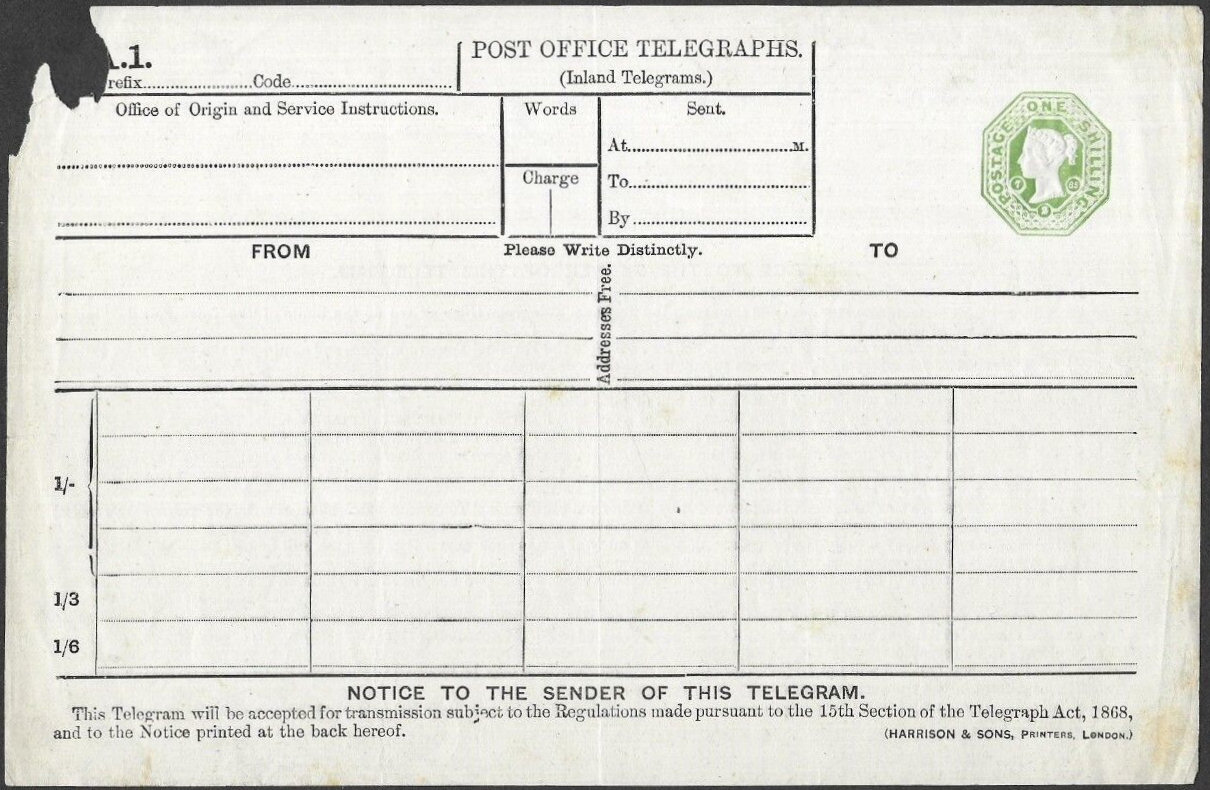
Printed by Harrison & Sons, London, as shown by the imprint at bottom-right.
The back now has 7-paragraphs of "NOTICE TO THE SENDER OF THIS TELEGRAM."
1(a) can be worded like this, referring to "Town Postal Delivery" or "letter Carriers" on TP10a.
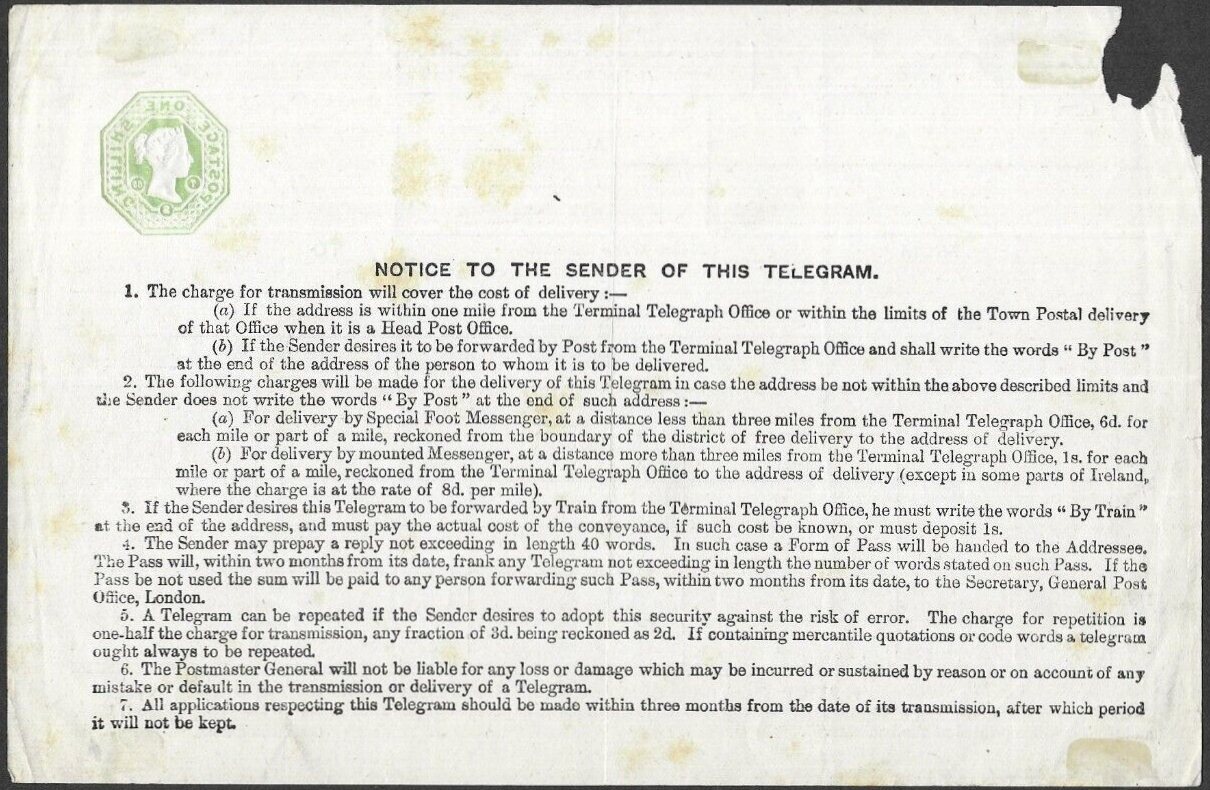
Images courtesy of David Huggins. (click on one for eBay listing)
On 1 October 1885 the minimum rate for Inland Telegrams was reduced to 6d for up to 12 words with each additional word charged at 1/2d.
1885-1894 6d purple QV octagonal dated ‘POSTAGE’ stamp with date plugs (14a)
smaller format form c.144 x 215 mm.
PRINTED BY HARRISON & SONS, LONDON imprint ‘(HARRISON & SONS, LONDON)’.
| TP11aa | Sold singly: ruled for 30 words (1.10.1885) |
| TP12aa | Sold in booklets; ruled for 30 words (1.10.1885) |
| TP11ab | Sold singly; ruled for 25 words (1887) |
| TP12ab | Sold in booklets; ruled for 25 words (1886) |
PRINTED BY MCCORQUODALE & CO. LIMITED imprint ‘(PRINTED BY McCORQUODALE & CO. LIMITED)’; ruled for 25 words.
Text of 4th line of 4th paragraph reads ‘Office London’.
| TP11ba | Sold singly (1890) |
| TP12ba | Sold in booklets (26/6/89-26/9/93) |
Text of 4th line of 4th paragraph reads ‘General Post Office London’.
| TP11bb | Sold singly (1894) |
| TP12bb | Sold in booklets (1893) |
Printing Dates TP11aa (2.9.85 — 5.10.85); TP11ab (14.1.87 — 8.6.89); TP11ba (19.12.88 — 19.12.93) TP11bb (19.12.93); TP12aa (2.9.85 — 14.1.87); TP12ab (1.7.86 — 22.3.88) TP12ba (26.6.89 — 26.9.93) TP12bb (10.1.94 —6.2.94)
Varieties There are two settings of TP12ba.
1894 6d purple QV octagonal ‘POSTAGE’ stamp (14b) with date plugs replaced by florets (rosettes) composed of five or nine dots;
smaller format form c.144 x 215 mm; ruled for 25 words; imprint (PRINTED BY McCORQUODALE & CO. LIMITED)’
| TP13a | Sold singly; five dots in florets; fourth paragraph with ‘General Post Office’ |
| TP14a | Sold in booklets; five dots in florets: fourth paragraph with ‘Office’ |
| TP13b | Sold singly; nine dots in florets; fourth paragraph with ‘General Post Office’ |
| TP14b | Sold in booklets; nine dots in florets; fourth paragraph with ‘General Post Office’ |
Varieties TP 14a has been recorded with a rouletted attachment to binding margin instead of perforation 12.
1894-1901 6d purple QV octagonal undated stamp (15) not drilled for date plugs, smaller format form c.144 x 215 mm; ruled for 25 words:
imprint “(PRINTED BY McCORQUODALE & CO. LONDON, LIMITED)’.
With two line footnote on front; imprint at right
| TP15aa | Sold singly (1894) |
| TP16aa | Sold in booklets (1894) |
With one line footnote on front; imprint in centre; seven paragraphs On reverse.
| TP15ab | Sold singly; 2nd paragraph text ‘the following are’; space for sender's address at top (1894) |
| TP16ab | Sold in booklets; 2nd paragraph text ‘the following charges’; space for sender’s address at top (1894) |
| TP16ac | Sold in booklets; 2nd paragraph text ‘The following are’; space for sender’s address at bottom (1895) |
| TP16ad | Sold in booklets; 2nd paragraph text ‘the following are’; space for sender’s address at top (1896) |
With one line footnote on front; imprint in centre; eight paragraphs on reverse..
| TP16ba | Sold in booklets; text bottom line of 5th paragraph ‘Secretary ... London’ (1897) |
| TP16bb | Sold in booklets; text bottom line of 5th paragraph ‘to the Secretary ... London, Dublin or Edinburgh’ (1898) |
TP15 / TP16 Variations :
NB. Warrants dated 1/97; 12/97 and 8/99 covered both forms to be sold singly and those to be made up into booklets.
This A.1. Form has a 6d die with date plugs (This dated 29/5/90. L & H designation TP12ba).
The 6d covers up to 12 words, with additional words at 1/2d each to a maximum of 25 words for 12½d
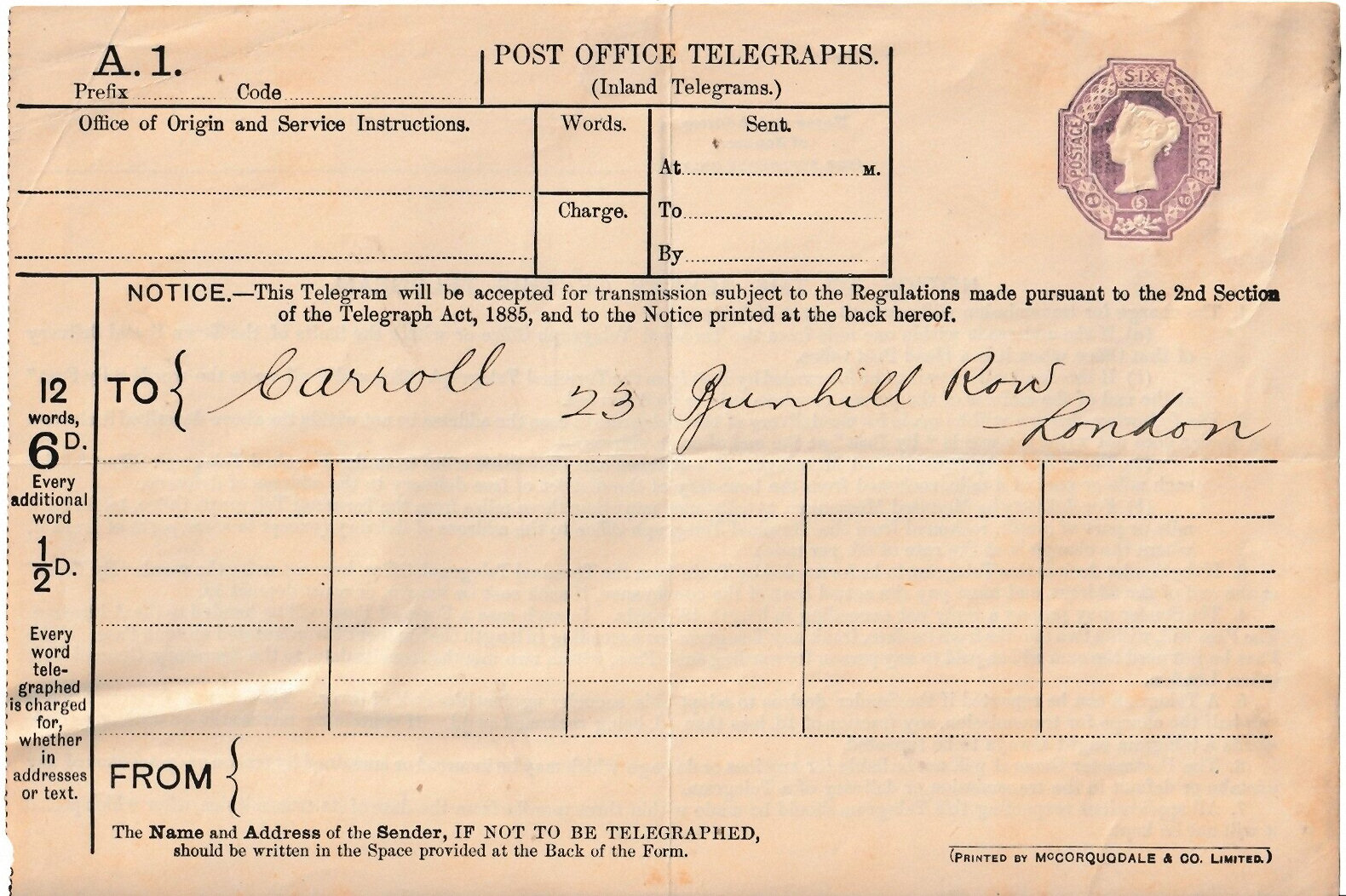
"The Name and Address of the Sender, IF NOT TO BE TELEGRAPHED, should be written in the Space provided at the Back of the Form."
Printed by McCorquodale & Co. Ltd., as shown by the imprint at bottom-right.
This A.1. Form has a 6d die with 5-dot florets (L & H designation TP14b).
The 6d covers up to 12 words, with additional words at 1/2d each to a maximum of 25 words for 12½d
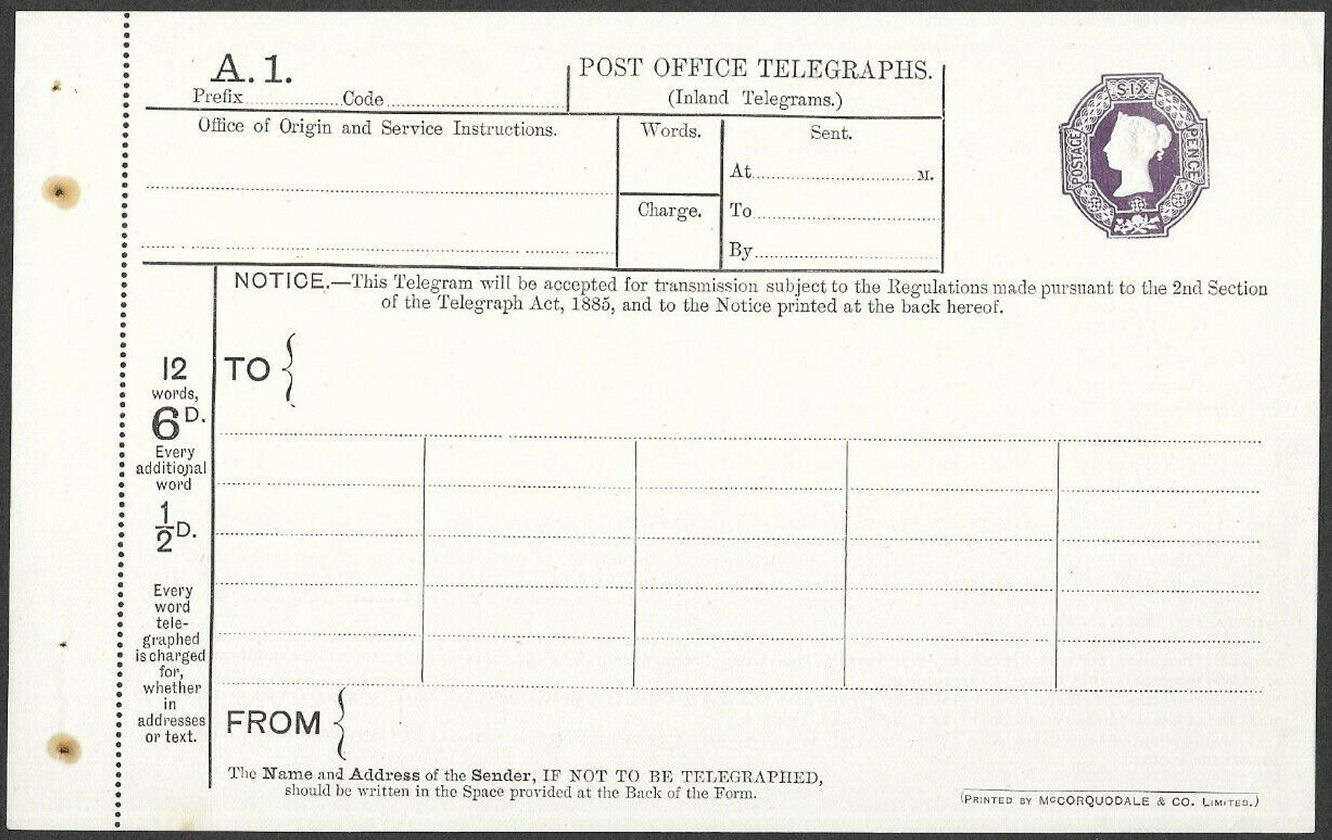
"The Name and Address of the Sender, IF NOT TO BE TELEGRAPHED, should be written in the Space provided at the Back of the Form."
Printed by McCorquodale & Co. Ltd., as shown by the imprint at bottom-right.
The back now has a space for the senders name and address at the top, and a 7-paragraph "NOTICE TO THE SENDER OF THIS TELEGRAM."
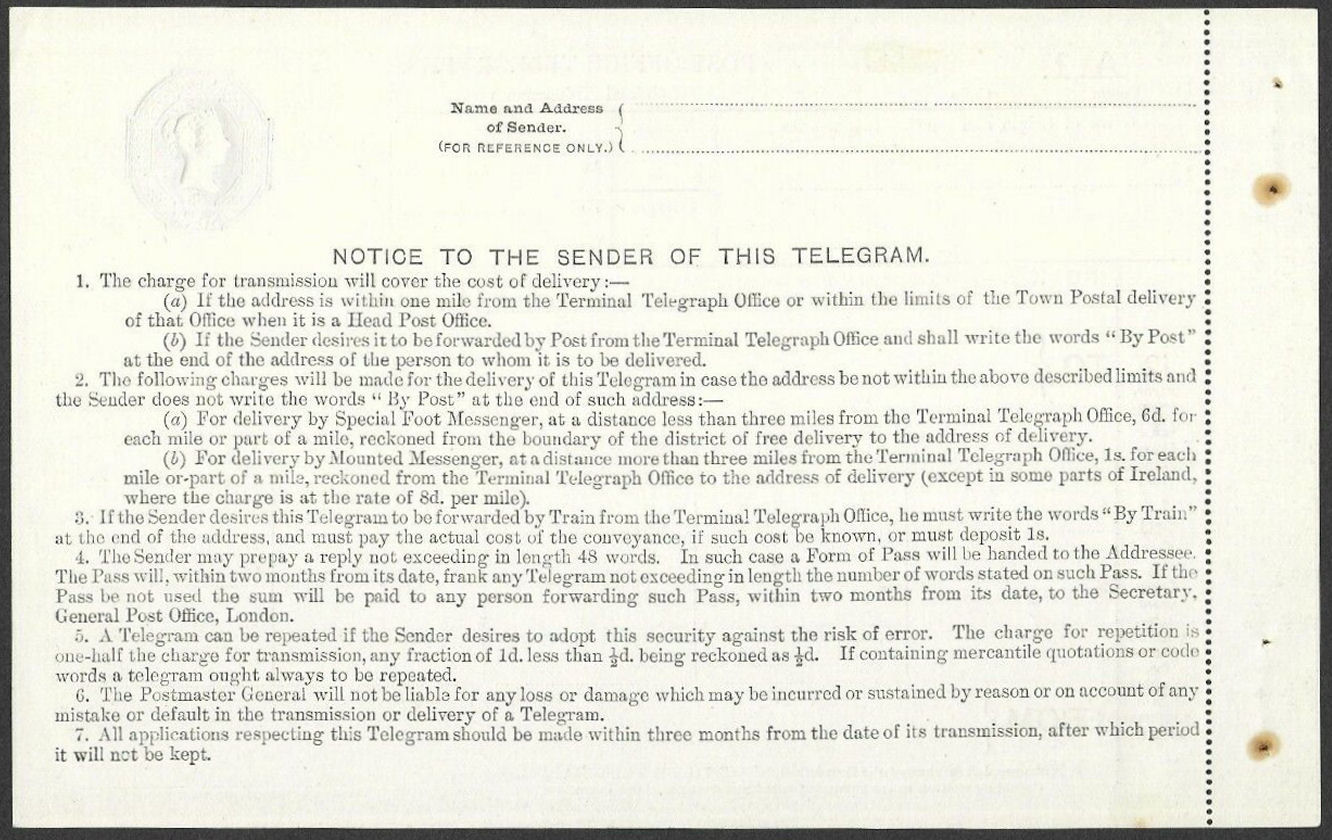
Images courtesy of David Huggins. (click on one for eBay listing)
This A.1. Form is Similar to last, but no florets on the 6d die. (L & H designation TP16ab).
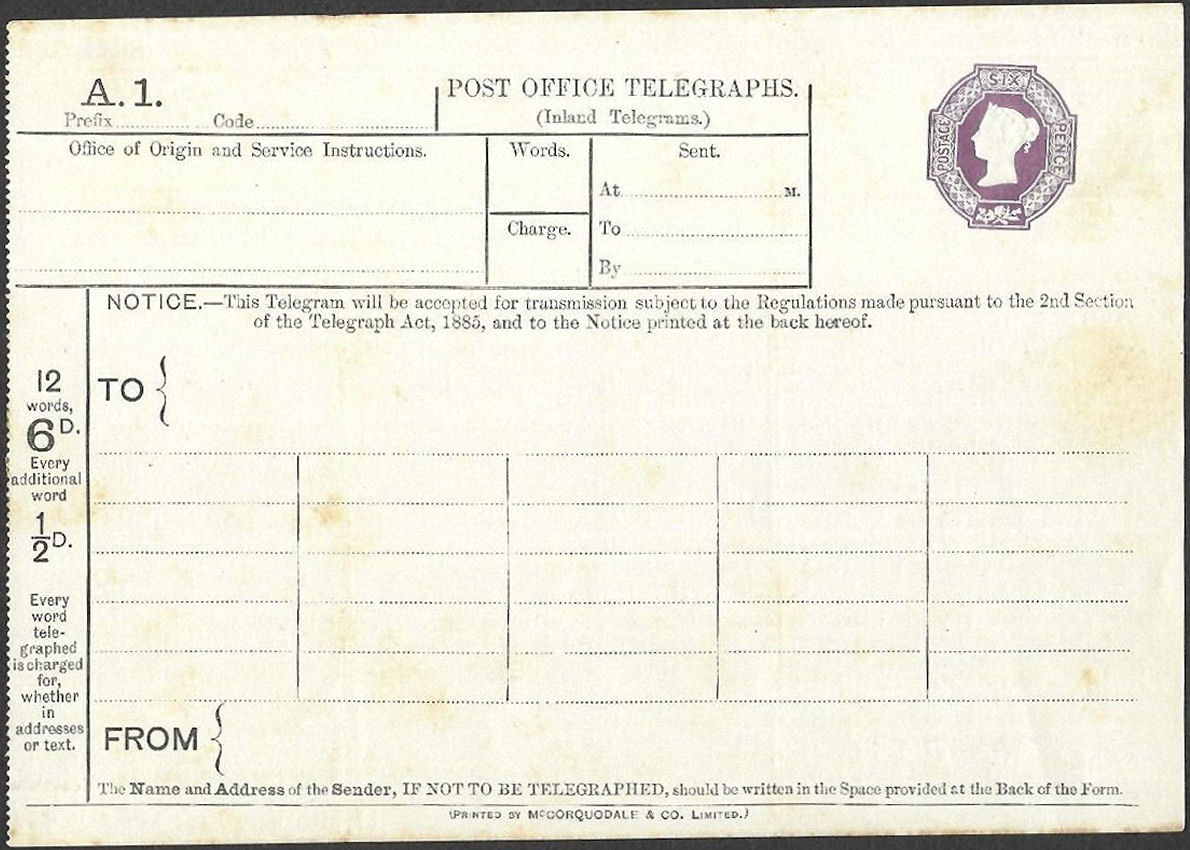
"The Name and Address of the Sender, note is on a single lineand the
McCorquodale & Co. Ltd., imprint is centrally now under it.
The back is the same as the last one.
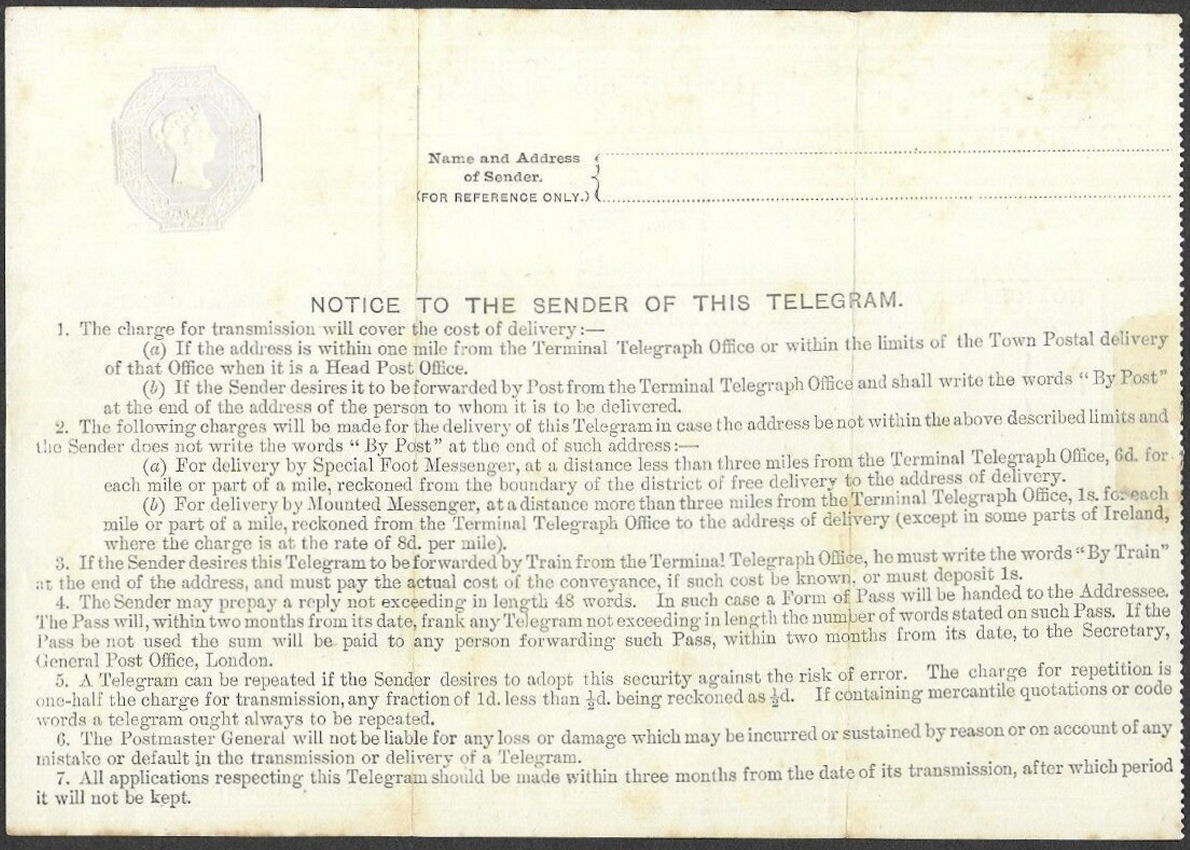
Images courtesy of David Huggins. (click on one for eBay listing)
TP15bb front is the same as the last, except for the bottom-right corner.
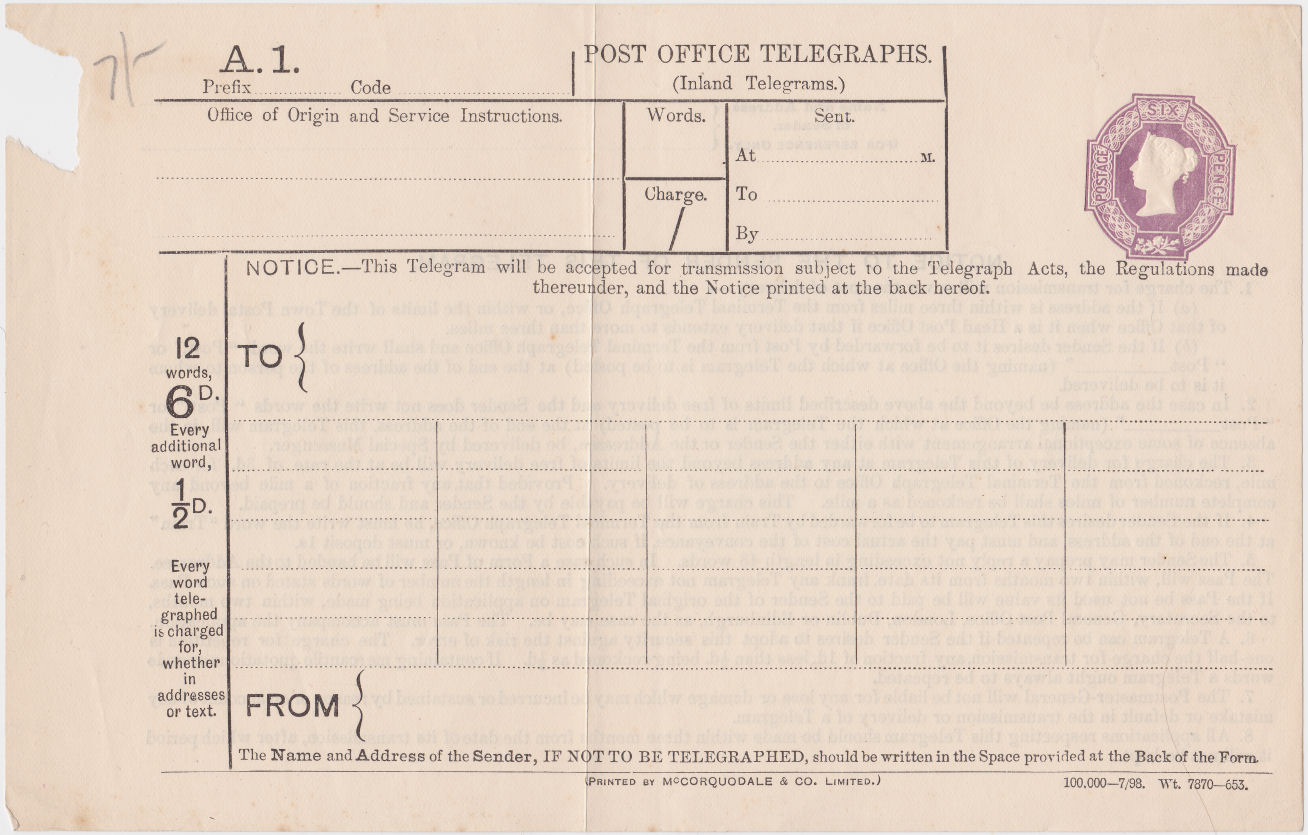
Printed by McCorquodale & Co. Ltd., with an imprint reading "100.000—7/98. Wt. 7870—653.", which I take to mean 100,000 printed July 1898.
This is L & H TP15bb (in the Addenda)
The back is similar to the last, but the first two paragraph have been reworded into three paragraphs, making 8 in all.
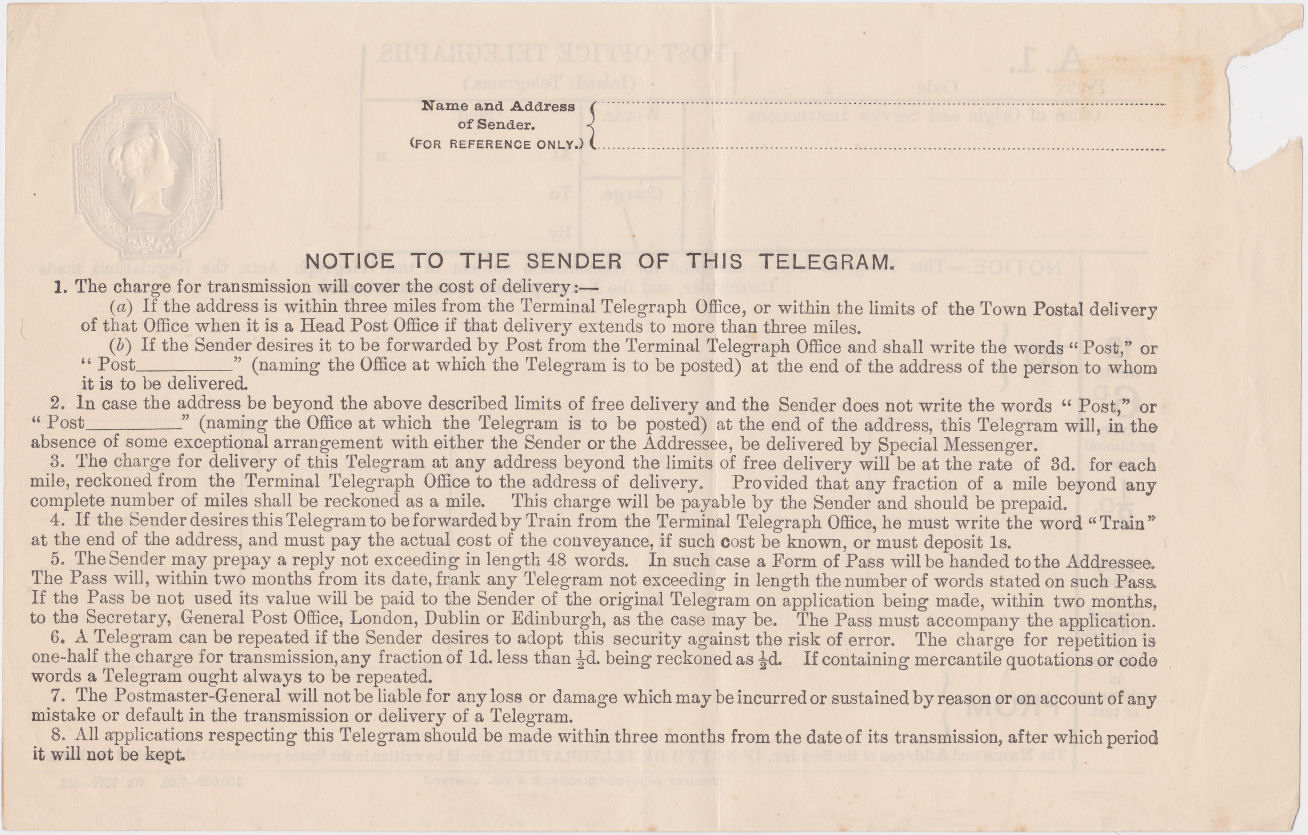
TP16bb - The front is the same as the last, except fro the bottom-right corner.
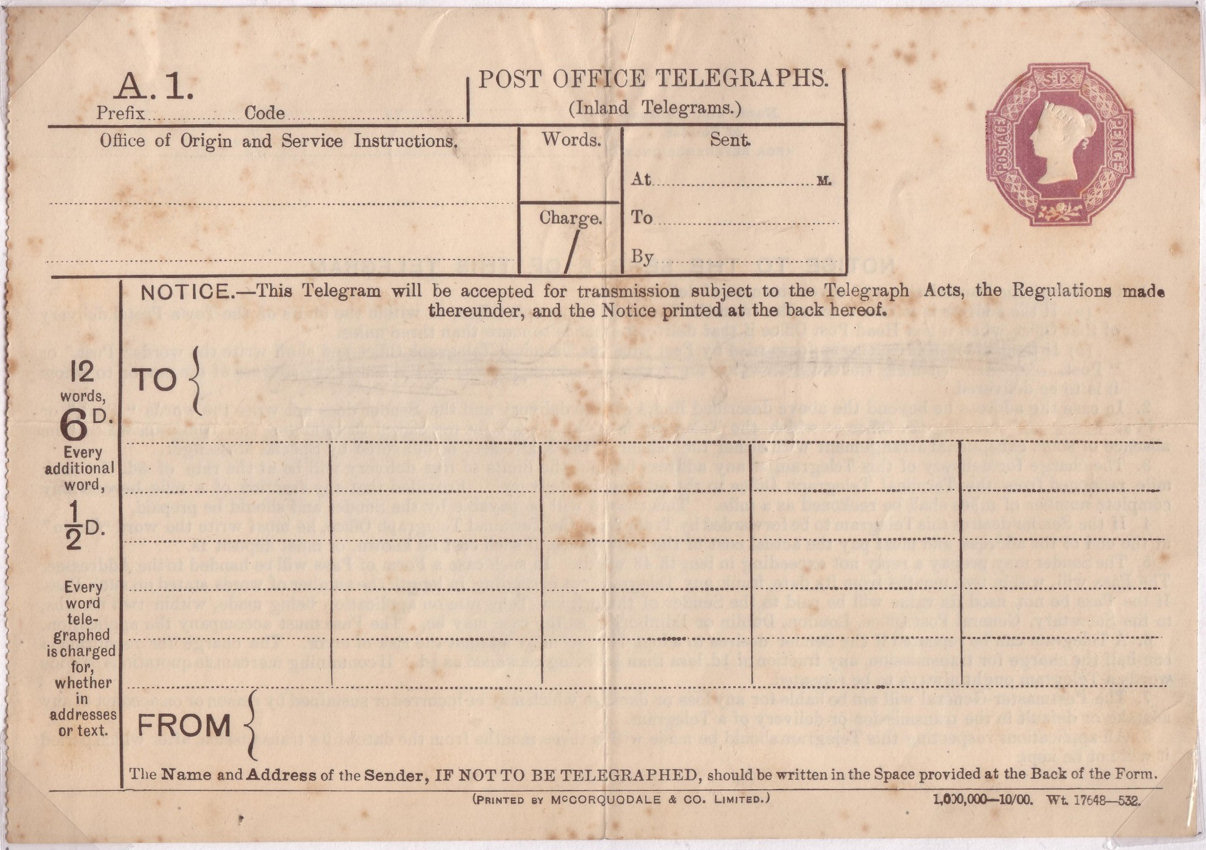
Printed by McCorquodale & Co. Ltd., with an imprint reading "1,000,000 10/00 Wt17648—532.", which I take to mean 100,000 printed October 1900.
This is L & H TP16bb - Images courtesy of Rolf Lampbrecht.
![]()
These were intended for use by people that did not live near an Office with telegraph facilities.
The card could be filled in and mailed at any post box. The 1/- stamp covered up to 20 words of a message, with free postage.
There are basically two different types, with different Coats of Arms. A range of date-plugs exist from 15.1.72 to 16.2.72.
The service was not greatly used and the cards were withdrawn at the end of January 1876.
Cards of the later type are known without an embossed 1/- stamp.
A 1/- charge for up to 20 words.
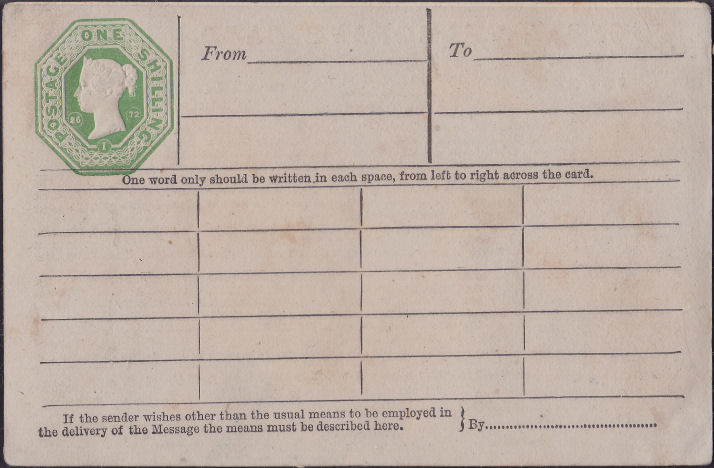
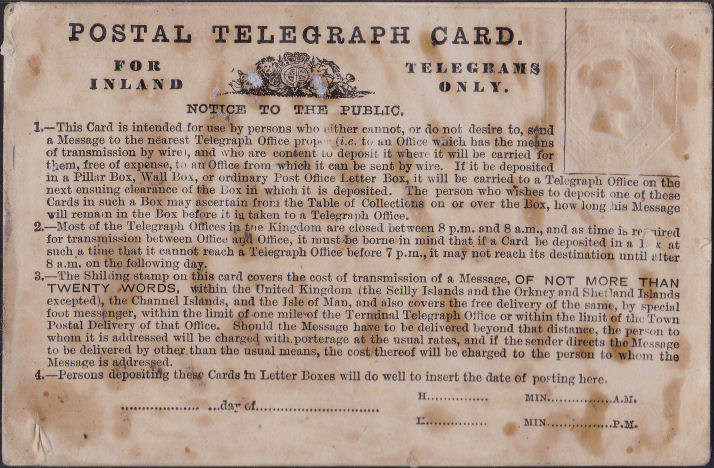
1s green Postal Telegraph Card (date plugs read 26/1/72), showing front and back (previously stuck down).
The back has a coat of arms and a"NOTICE TO THE PUBLIC". L & H (page 149) list two types depending on the width of the Coat of Arms along the base :
TCP1a, April 1872, 22mm; and this one, TCP1b, August 1874?, 25mm. However the size is less relavant than the style of the Coat of Arms.
Postal Telegraph Cards were available for use from 1872 to 1876, but little used.

This is the only recorded example, dated February 28, 1872.
Illustration from Langmead & Huggins' book (Colour Plate 8), courtesy of the
Great Britain Philatelic Society.
Form A1![]() for Inland Telegrams forwarded from Stock Exchange Offices only. - L & H type TP39b (1889).
for Inland Telegrams forwarded from Stock Exchange Offices only. - L & H type TP39b (1889).
Images courtesy of David Huggins, click on one for eBay listing.
Form A1![]() for Inland Telegrams forwarded from Stock Exchange Offices only. - L & H type TP40a (1885).
for Inland Telegrams forwarded from Stock Exchange Offices only. - L & H type TP40a (1885).
Images courtesy of David Huggins, click on one for eBay listing.
Form A1![]() for Inland Telegrams forwarded from Stock Exchange Offices only. - L & H type TP40ba (1889).
for Inland Telegrams forwarded from Stock Exchange Offices only. - L & H type TP40ba (1889).
Images courtesy of David Huggins, click on one for eBay listing.
Form A1![]() for Inland Telegrams forwarded from Stock Exchange Offices only. - L & H type TP41aa (1895).
for Inland Telegrams forwarded from Stock Exchange Offices only. - L & H type TP41aa (1895).
Images courtesy of David Huggins, click on one for eBay listing.
Form A1![]() for Inland Telegrams forwarded from Stock Exchange Offices only. - L & H type TP41ab (1896).
for Inland Telegrams forwarded from Stock Exchange Offices only. - L & H type TP41ab (1896).
| 6d Post Office Telegraph Form A1S/E (no date plugs), Printed by Wyman & Sons Ltd. 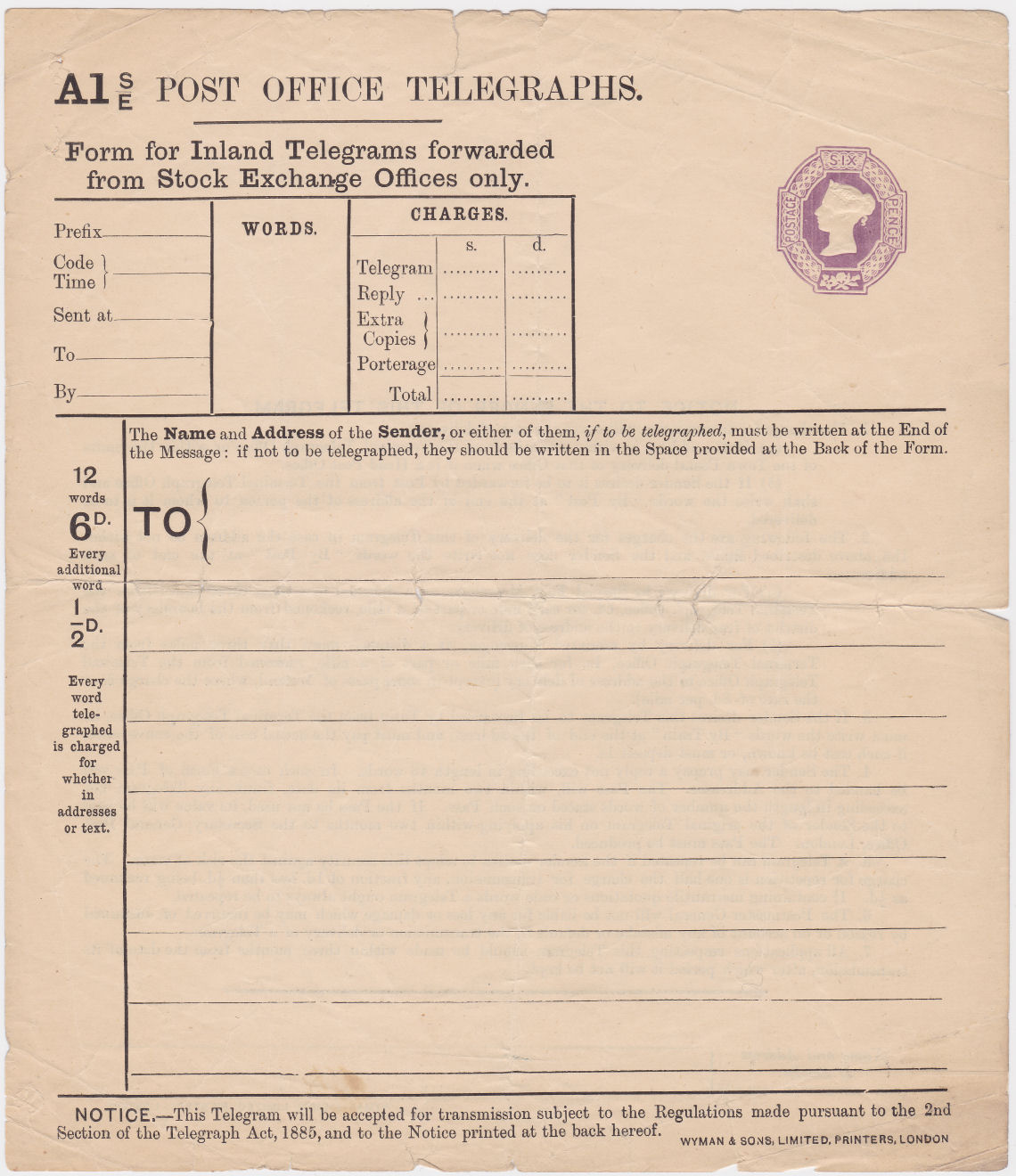 Wyman Imprint at bottom-right. |
The back has a "NOTICE TO THE SENDER OF THIS TELEGRAM" with the space for the senders name and address at the bottom. 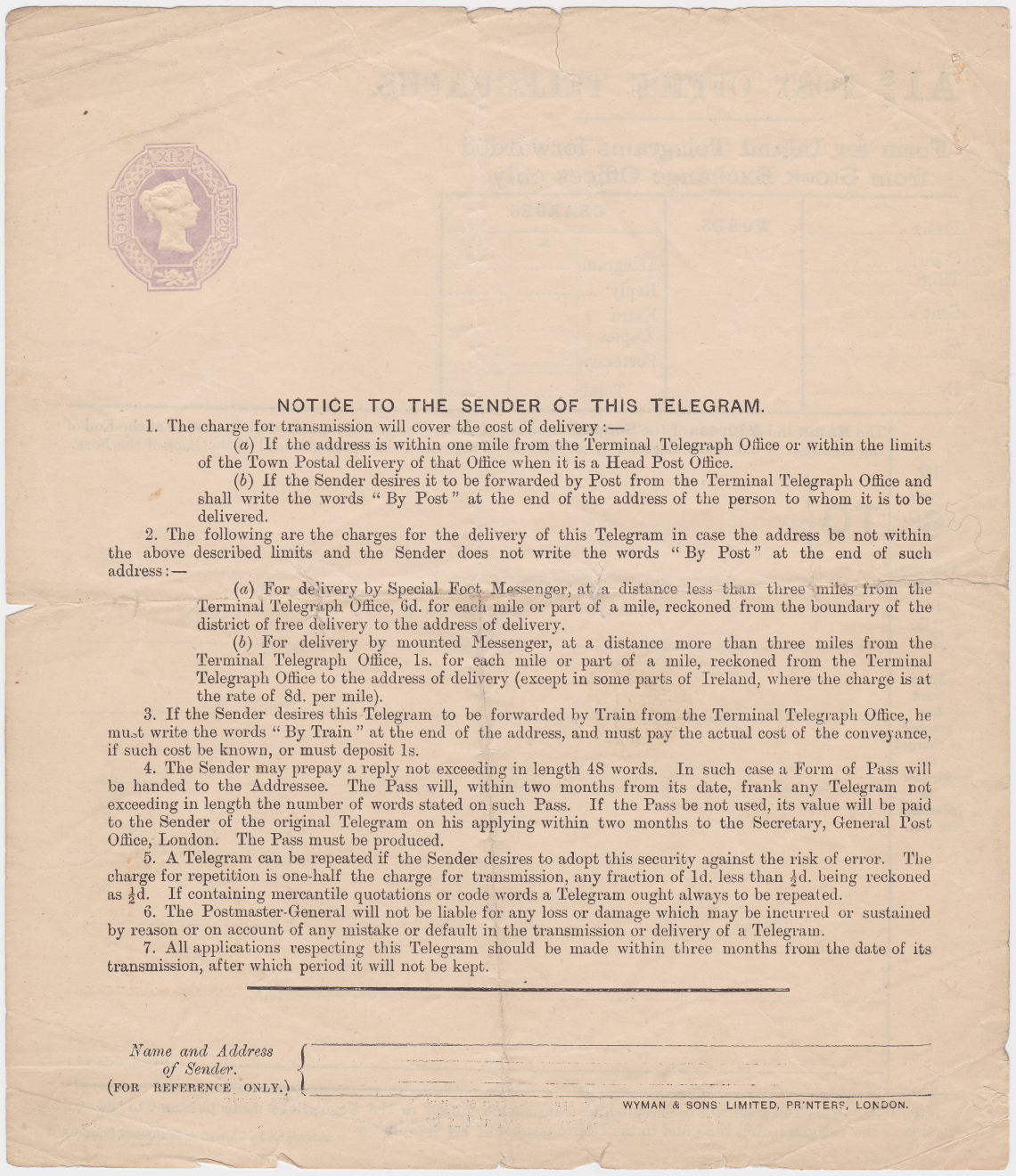 The back also has the Wyman imprint. |
I have another one almost identical to this, also L&H Type TP41ab (1896), but different at the bottom of the front and back :

The front has a purple "ENLISTED", still with the Wyman & Sons Ltd imprint.
The back has a purple "A. H. LEIGH & Co.," and the Wyman & Sons Ltd imprint is missing.

This is not specifically covered by L & H, but a note at the top of page 140 refers to forms with printed or handstamped company names, available singly or in booklets of 20.
Form A1![]() for Inland Telegrams forwarded from Stock Exchange Offices only. - L & H type TP41bb (1898).
for Inland Telegrams forwarded from Stock Exchange Offices only. - L & H type TP41bb (1898).
Images courtesy of David Huggins, click on one for eBay listing.
Form A1![]() for Inland Telegrams forwarded from Stock Exchange Offices only. - L & H type TP42bb (1896).
for Inland Telegrams forwarded from Stock Exchange Offices only. - L & H type TP42bb (1896).
Images courtesy of David Huggins, click on one for eBay listing.
Form A1![]() for Inland Telegrams forwarded from Stock Exchange Offices only. - L & H type TP42ca (1898).
for Inland Telegrams forwarded from Stock Exchange Offices only. - L & H type TP42ca (1898).
Images courtesy of David Huggins, click on one for eBay listing.
Form A![]() 1 for Foreign and Colonial Telegrams. - L & H type TP56a (1890).
1 for Foreign and Colonial Telegrams. - L & H type TP56a (1890).
Images courtesy of David Huggins, click on one for eBay listing.
Form A![]() 1 for Foreign and Colonial Telegrams. - L & H type TP57 (1892).
1 for Foreign and Colonial Telegrams. - L & H type TP57 (1892).
Images courtesy of David Huggins, click on one for eBay listing.
1895-1900 10d brown QV octagonal undated ‘POSTAGE’ stamp (16);
change of format to size 143 x 228 mm with perforated separation at left-hand margin; cream paper
For the sake of interest, Telegrams could be quite expensive.
A £3 A![]() (unstamped) Telegraph of December 1900, for 9 words, to Middleburg Officers Hospital in Transvaal
(unstamped) Telegraph of December 1900, for 9 words, to Middleburg Officers Hospital in Transvaal
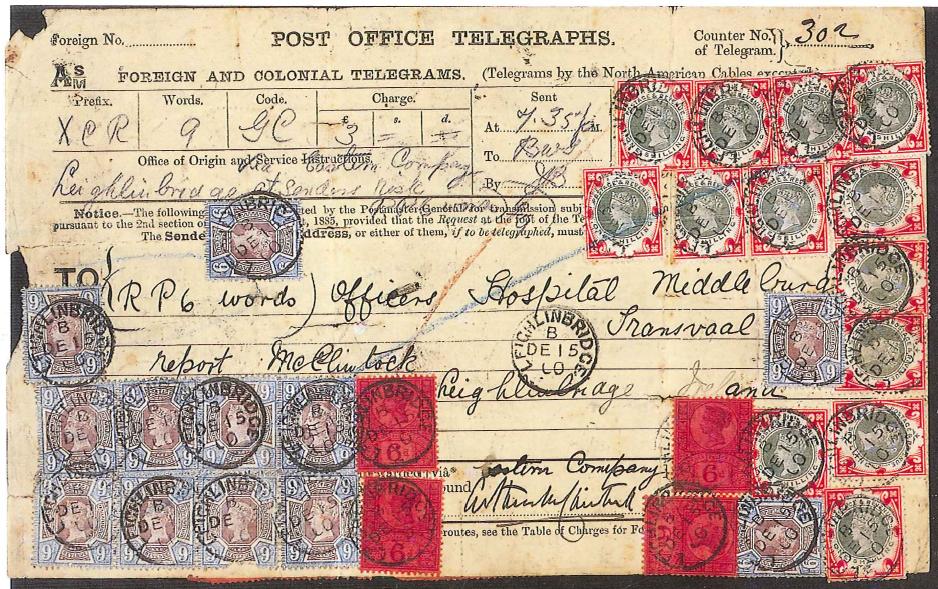
This could have bee paid with three stamps, but instead 29 stamps totalling £1.4s were plastered on the front and the other £1.16s on the back.
Stamps on the back can be seen at the bottom. I presume there was a good reason for it, perhaps related to the survival of the form.
Sent from Leighlinbridge, Ireland. Image courtesy of Allan Oliver.
Form A![]() 1 for Foreign and Colonial Telegrams. - L & H type TP58ab (1897).
1 for Foreign and Colonial Telegrams. - L & H type TP58ab (1897).
Images courtesy of David Huggins, click on one for eBay listing.
Form A![]() 1 for Foreign and Colonial Telegrams. - L & H type TP58ba (1900?).
1 for Foreign and Colonial Telegrams. - L & H type TP58ba (1900?).
Images courtesy of David Huggins, click on one for eBay listing.
Foreign Forms for Transmission by SubMarine Cable from Stock Exchange Offices Only. TP61a - TP61bb.
These were also available in booklets of 25 large-format forms with embossed 10d blue stamps (similar to TP55 above), but unfortunately I have no images as yet.
Can anyone supply an image ?
Not all telegram deliveries went smoothly. Various problems arose that needed to be documented.
I have sequenced these with the most common first, as judged by the number of forms printed.
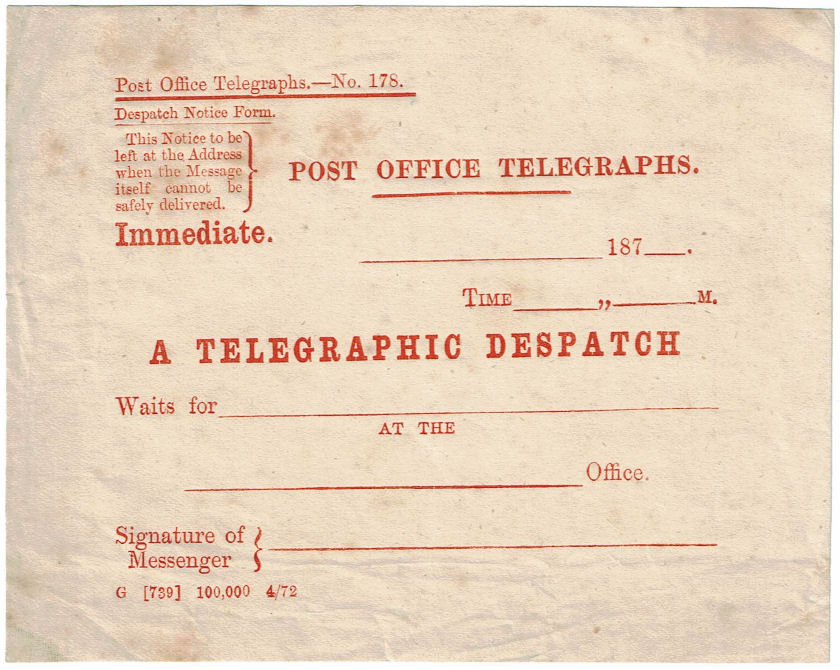
Unused "Post Office Telegraphs. —No. 178." form printed in red, with pre-printed year of 187__.
The top-left reads : 'This notice to be left at the address when the message itself cannot be delivered'
This would typically be filled in and left when the addressee was not at home. The imprint at the bottom reads :
"G [739] 100,000 4/72" suggesting that 100,000 were printed in April 1872, perhaps by Griffiths & Sons.
Image courtesy of Edward Coombes.
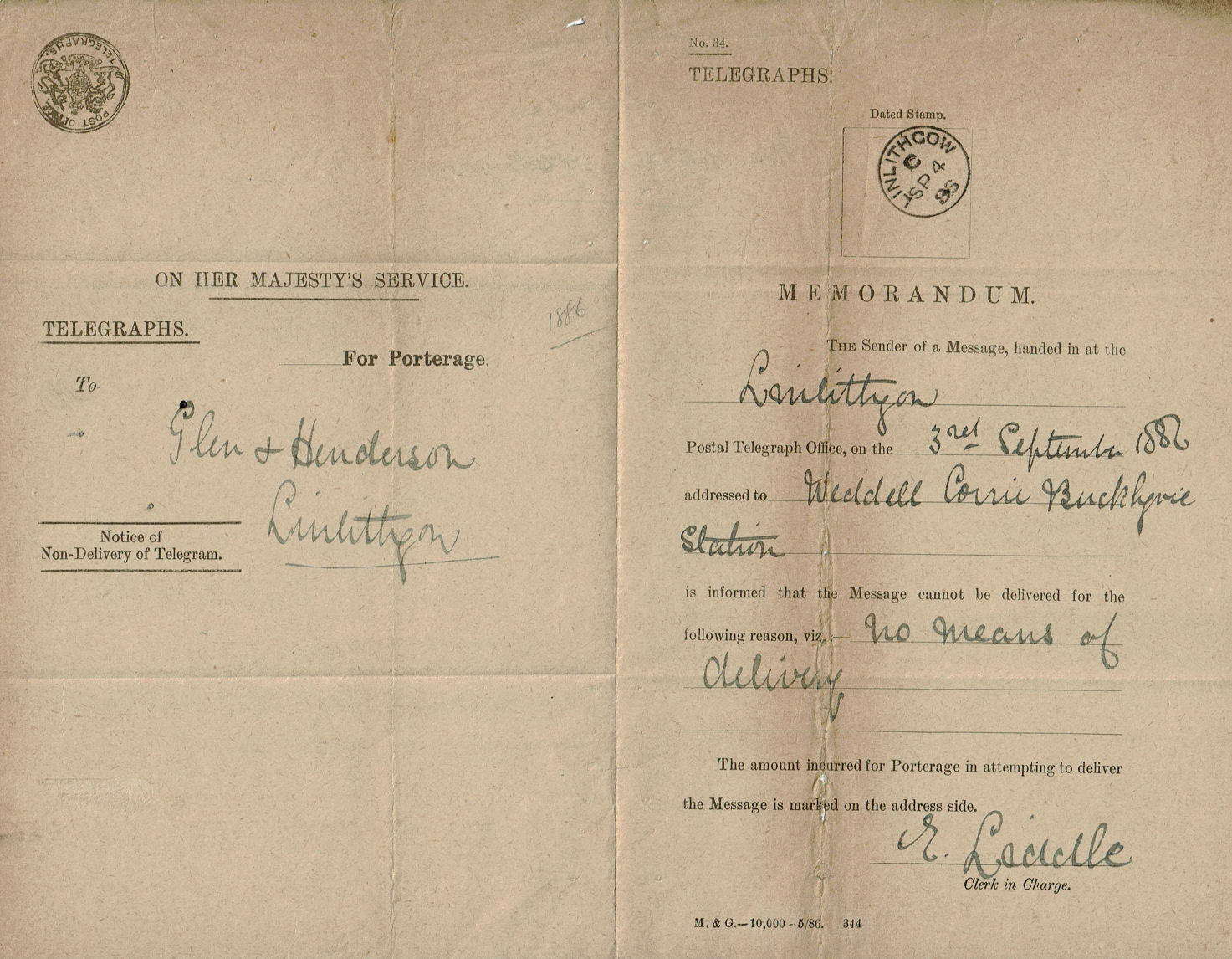
"No. 34." form dated 4 September 1886. A one-page form which on use is folded and posted out O.H.M.S. marked 'Notice of Non-Delivery of Telegram'. Plain on reverse.
This MEMORANDUM says they had no means to deliver it to Buchlyvie Station! I find that surprising.
The imprint at the bottom reads : "M & G Ltd—10,000—5/86 344", suggesting that 10,000 were printed by M & G Ltd. in May 1886
The form shown below probably replaced this. Image courtesy of Edward Coombes.
This has no Form Number, but appears to be for more general purpose Telegraph use.
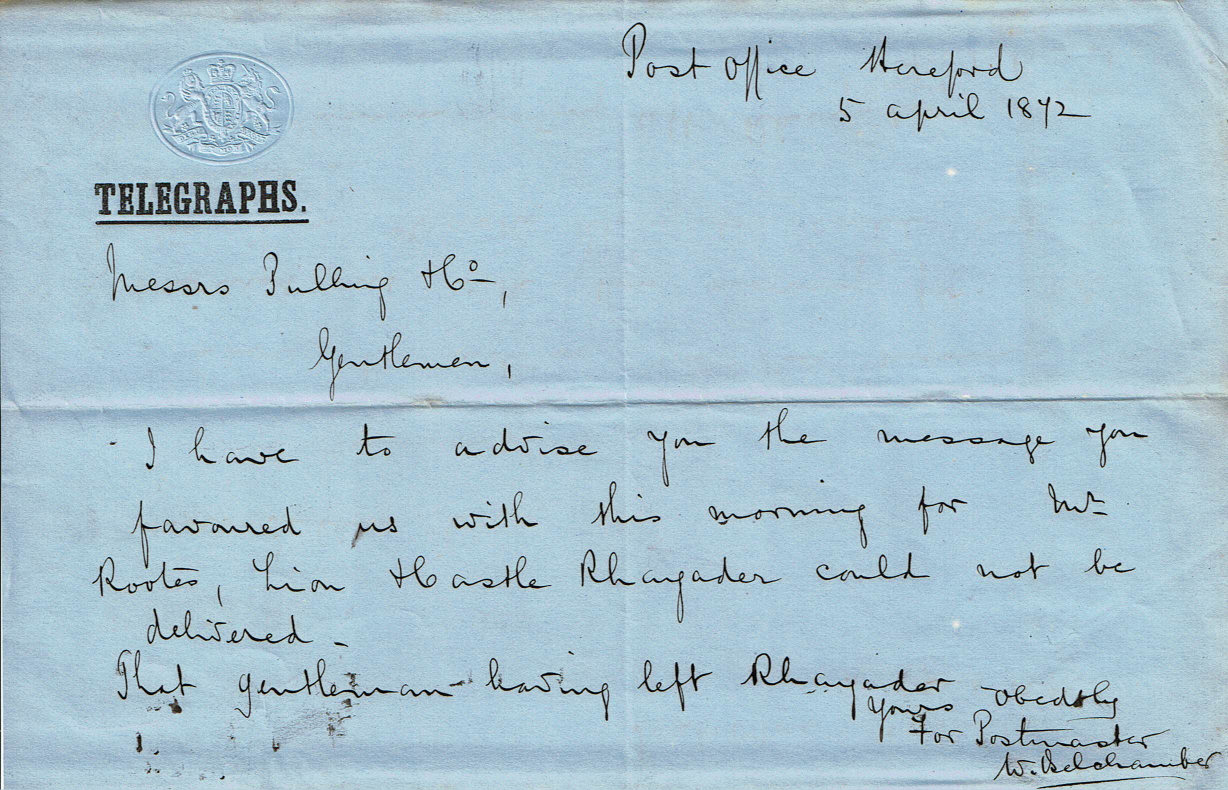
This is from the Post Office at Hereford, dated 5 April 1872, and sent to Bulling & Co. advising them that a telegram they sent to Mr. Rootes staying at the Lion and Castle in Rhayader,
could not be delivered because he had left Rhayader. It is signed on behalf of the Postmaster. Image courtesy of Edward Coombes.
| Shortcuts to different types of Receipt. | |||
| Telegraph Message Receipts | Reply Paid | Abbreviated Address | General Receipts |
All the scans I have, have a few things in common. They are all missing the top-left corner, all in the years 1880/81, and all seem to have very similar wording,
despite being printed in a range of years.
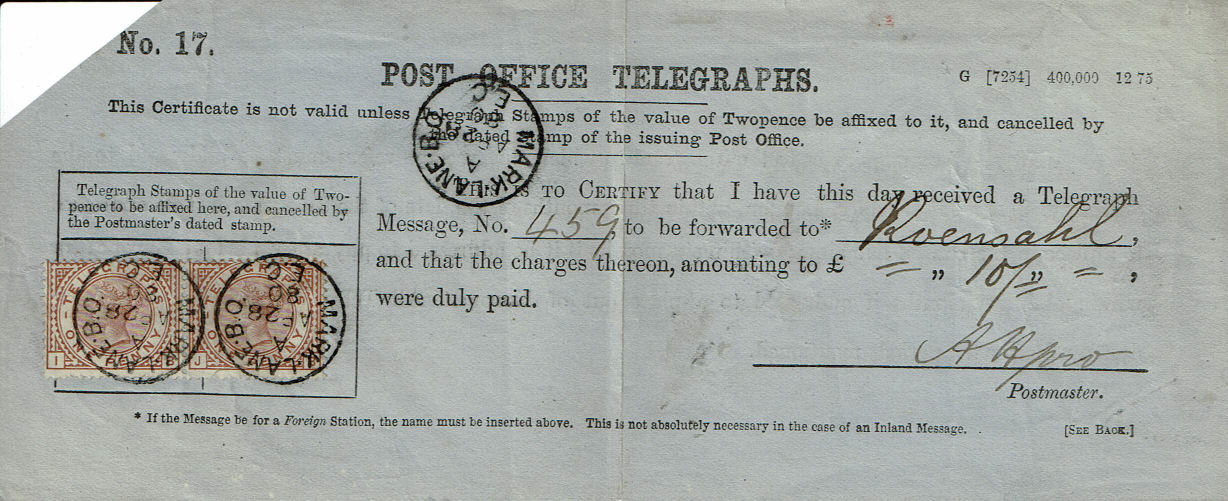
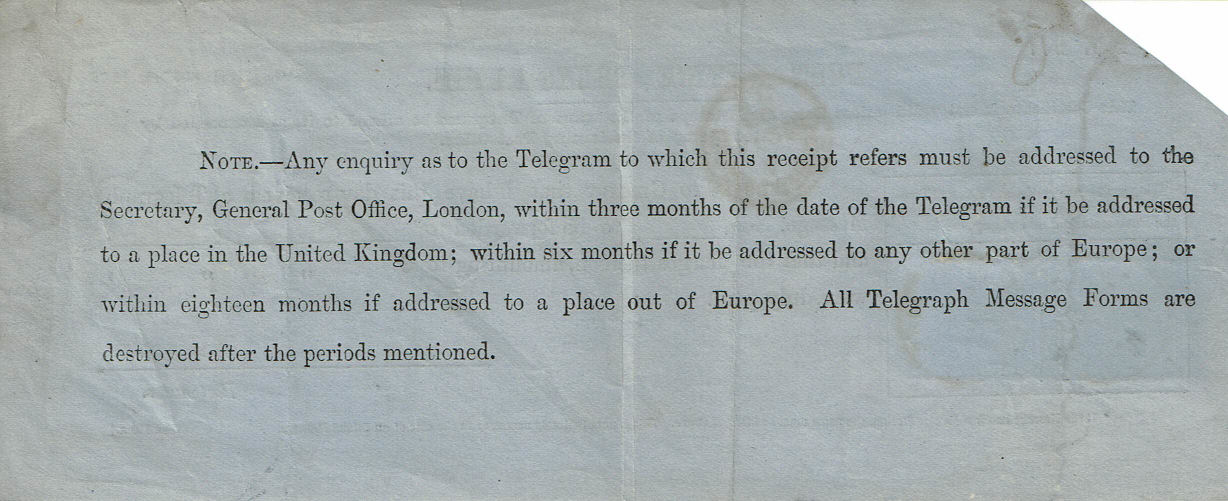
Code No 17 and size 212 x 86 mm. Imprint of "G (7254) 400,000 12 75" on top right.
suggesting 400,000 printed in December 1875, perhaps by Griffiths (& Sons ?). Message number (459) handwritten and postmarked Mark Lane 28th April 1880.
Text in central paragraph reads "and that the charges thereon, amounting to __ were duly paid".
Receipts could be obtained for 2d in stamps which were attached to the receipt and cancelled. This was the only legitimate source of used telegraph stamps !
Other telegraph stamps, along with the forms they were on, were supposed to have been pulped (see below). Presumably this was primarily to protect confidentiality,
but considering the ready market available for the stamps (even before the Post Office Telegraph stamps), there were many that escaped this fate.
In the interests of making the text searchable and translatable, the test on the back reads :
"Note.—Any enquiry as to the Telegram to which this receipt refers must be addressed to the Secretary, General Post Office, London, within three months of the date of the telegram if it be addressed
to a place in the United Kingdom; within six months if it be addressed to any other part of Europe; or within eighteen months if addressed to a place out of Europe. All Telegraph Message Forms are destroyed after the periods mentioned."
The first two time periods seem remarkably short, the last being more normal in other countries. Perks of a monopoly I suppose.
Plate 1, used at Mark Lane B.O. London E.C. on 28 April 1880. Image courtesy of Edward Coombes.
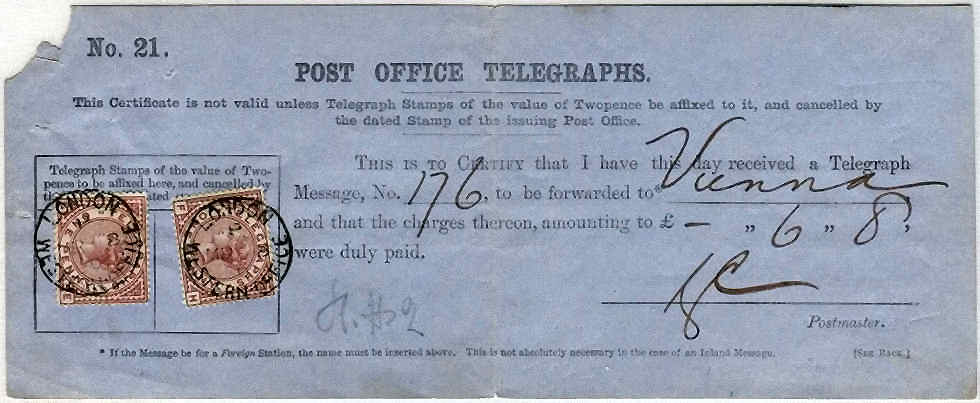
This has "No. 21." at top-left and no imprint on the front. Otherwise, the wording on the front is the same as the last.
Plate 2, used at London, Western Office on 8 March 1880. Image courtesy of Ian Pinwill.
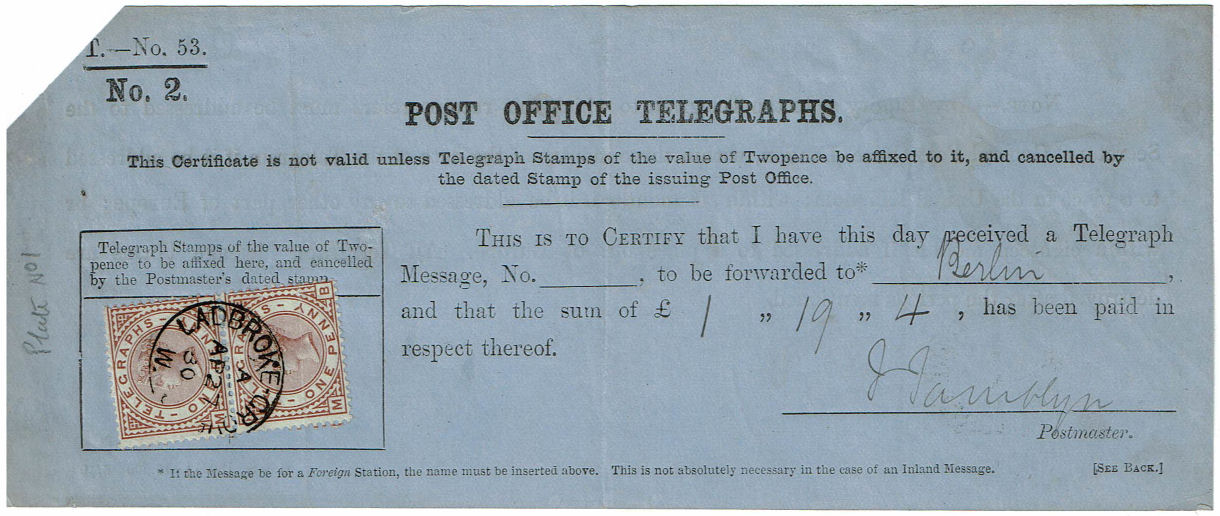
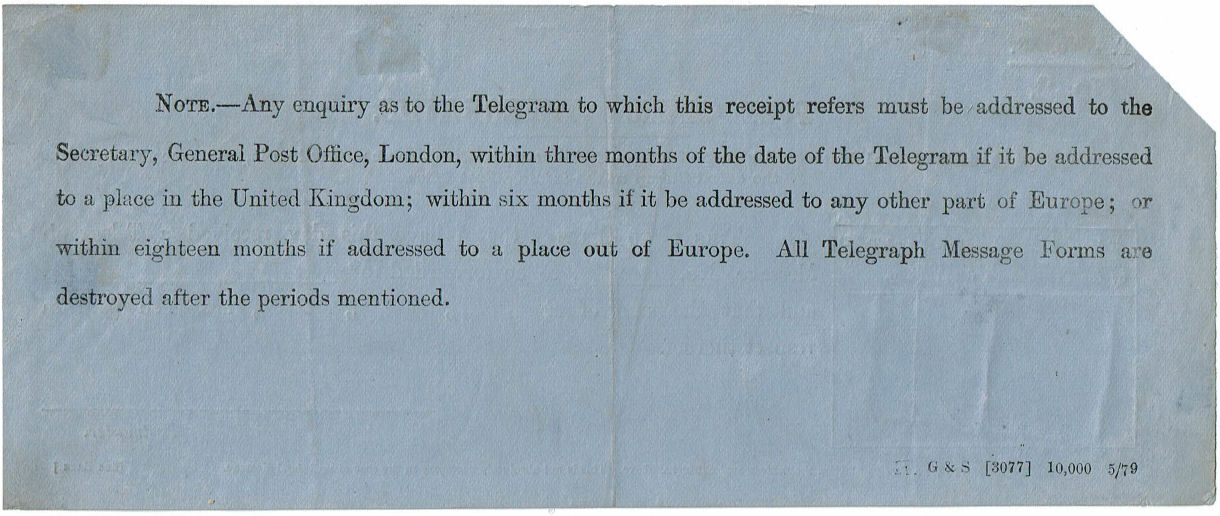
This has "T.—No. 53. / No. 2." at top-left. The text in the front central paragraph now reads "and that the sum of __ , has been paid in respect thereof." Size 205 x 85 mm.
An imprint on the back bottom-right says "G & S [3077] 10,000 5/79" suggesting that 10,000 were printed in May 1879, perhaps by Griffiths & Sons. Other wording on the back remains unchanged.
Plate 1, used at Ladbrook Grove Rd., West London, on 27 April 1880. Image courtesy of Edward Coombes.
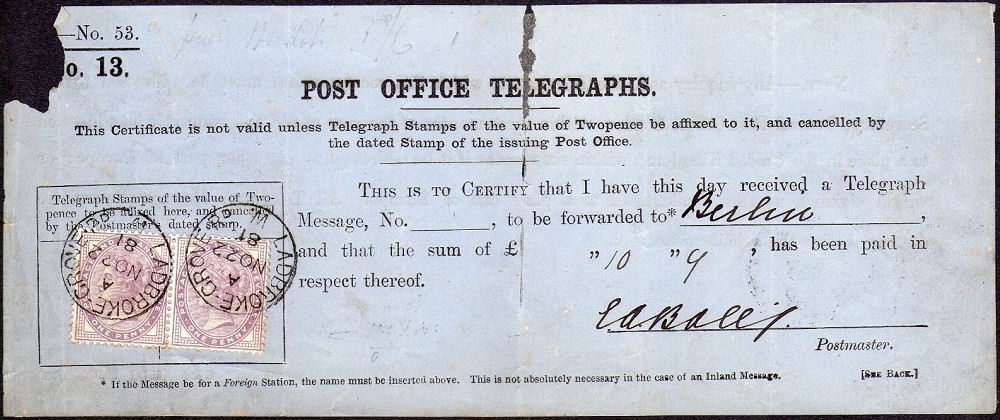
This has "T.—No. 53. / No. 13." at top-left. A later one very similar to the last and used at the same place, dated 22/11/81 using postage & revenue stamps.
It has been suggested that the "No. 13." represents the Message number which is not filled in on the form, again like the last. Image courtesy of Andrew Higson.
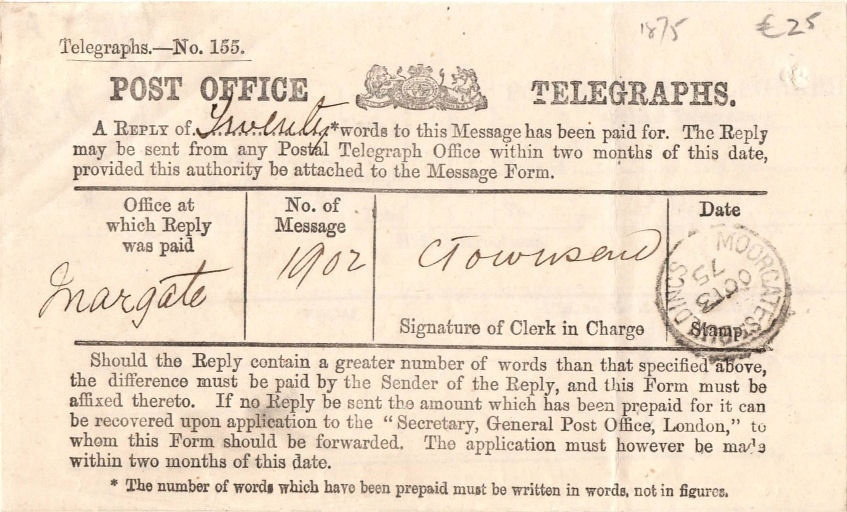
This has "Telegraphs.—No.155." at top-left. A receipt for a pre-paid reply telegram of 20 words, postmarked Moorgate St Buildings and dated 13th October 1875.
The reply has to be made within 2 months. Alternatively a refund can be had if application is made to the Secretary of the GPO within that time.
Image courtesy of Ian Pinwill.
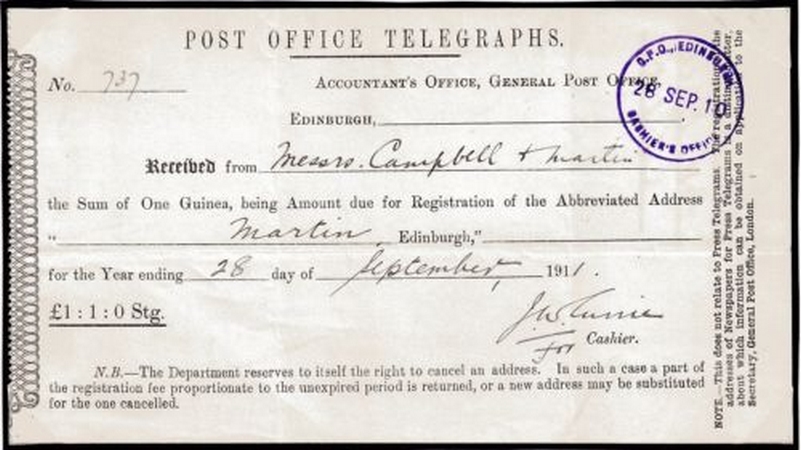
A receipt for One Guinea, paying for the Registration of Abbreviated Address at Edinburgh dated 28 September 1910.
Image courtesy of Allan Oliver.
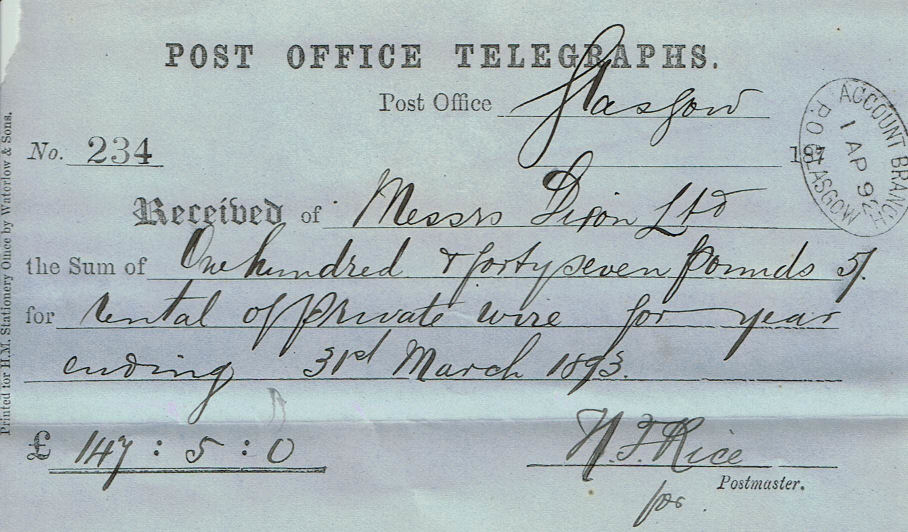
This has "Printed for H.M. Stationery Office by Waterlow & Sons." on the left side. A receipt of £147:5:0 for one year rental of a a private telegraph wire.
Oval cancel 'Account Branch P.O. Glasgow' and dated 1st April (18)92.
Image courtesy of Edward Coombes.
| Provisional Reference | Number | Style | known dates | Printers imprint | Size mm. | Front | Back | Flap | Comments |
|---|---|---|---|---|---|---|---|---|---|
| PO_Env_H2 | - | H2 | 26 February 1870 | - | 148 x 84 | PO Tel. Immediate | - | embossed CoA | - |
| PO_Env_Del_1 | - | Delivery | 21 September 1870 | - | - | PO Tel. Immediate / No Charge / Sent Out | - | embossed CoA | - |
| PO_Env_Del_2 | - | Delivery | 14 August 1871 | - | - | PO Tel. Immediate / No Charge / Sent Out At | - | embossed CoA | - |
| PO_Env_Port_1 | - | Porterage | - | - | 148 x 84 | PO Tel. Immediate / For Porterage / Sent Out At | - | embossed CoA | Box for charges |
| PO_Env_Charges_1 | - | Charges | 12 December 1875 | Straight-line Waterlow & Sons, Ltd | 127 x 84 | Telegram / Charges / For | - | plain | Box for charges |
| PO_Env_Del_3 | - | Delivery | 11 September 1877 | Curved Waterlows, Manufacturers | - | Telegram / No Charge / Sent Out At | - | plain | |
| PO_Env_Del_4 | - | Delivery | Late 1880s to 1900 | Straight-line Waterlow & Sons, Ltd | 127 x 81 | Telegram / No Charge | - | plain | |
| PO_Env_Del_4a | - | Delivery | 12 October 1882 | Straight-line Waterlow & Sons, Ltd | 127 x 81 | Telegram / No Charge / Address | - | plain | Customized |
| PO_Env_Del_4b | - | Delivery | 18 June 1888 | Straight-line Waterlow & Sons, Ltd | 127 x 81 | Telegram / No Charge / cachet | - | plain | with cachet |
| PO_Env_Port_2 | - | Porterage | 1878-82?? | - | - | Telegram / For Porterage / Sent Out At | - | plain | Box for charges |
| PO_Env_Port_3 | - | Porterage | 20 March 1885 | - | - | Telegram / For Porterage | - | plain | Box for charges |
| PO_Env_Royal_1 | - | Royal | Early | - | 234 x 108 | Immediate / PO Tel. / Tel. Clerk | - | plain | Thick white card |
| PO_Env_OHMS_1 | No. 14 | OHMS | 6 June 1888 | - | 133 x 79 | OHMS No.14 / Telegraphs / PO | - | plain | Blue |
| PO_Env_OHMS_2 | No. 27 | OHMS | 18 July 1893 | - | 126 x 76 | OHMS No.27 / Telegraphs / Free / name | - | plain | Blue |
| PO_Env_OHMS_3 | No. 27 | OHMS | 2 December 1898 | - | 133 x 79 | OHMS / Telegraphs / Free / name / No.27 | - | plain | Blue |
| PO_Env_Pay_1 | No. 22 | Payment | ? | - | 100 x 75 | No. 22 / PO Tel. / No. Name / £sd / instructions | - | plain | White |
| BC-Env-269 | No. 269 | Confirmation | 3 September 1929 | - | - | No Charge / PO Tel. / Telegram / Confirmation / No.269 | - | plain | Red-brown |
| BC-Env-198 | No. 198 | Delivery | 24 August 1939 | Straight-line Waterlow & Sons, Ltd | - | PO Telegram / No Charge | Instructions / No. 198 | plain | Tan |
The last two are not on this page.
Dated (F)E 26, 1870 "POST OFFICE TELEGRAPHS. —— IMMEDIATE. ". My Provisional Ref: PO_Env_H2
Stamped "CONFIRMATION"
This is very similar to the image shown on page 21 of Form H2. Typical size 148 x 84 mm.
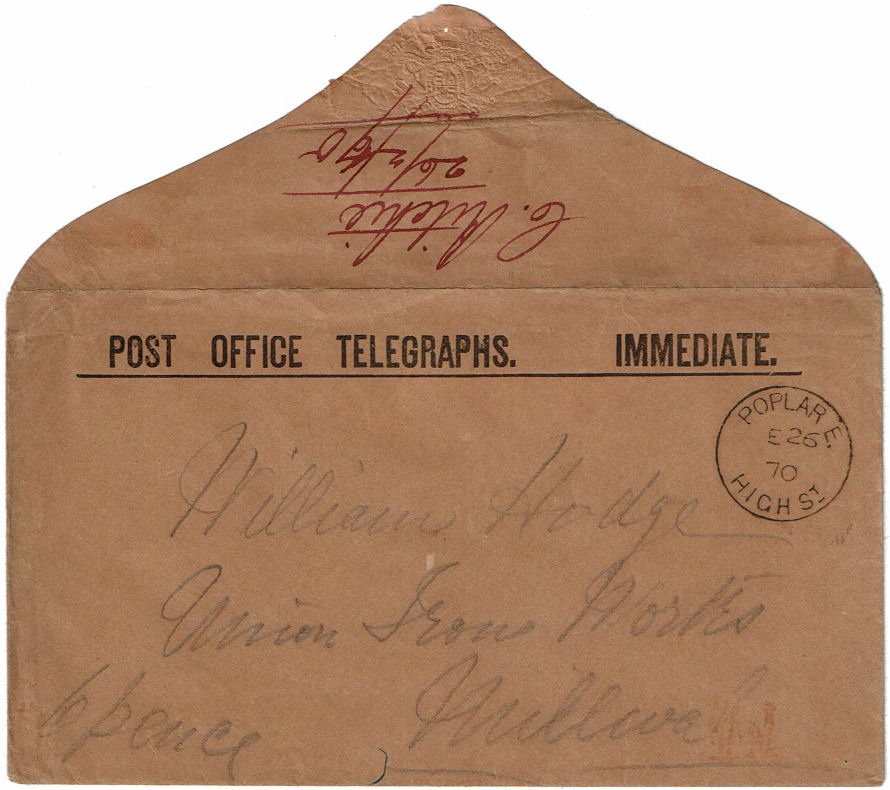
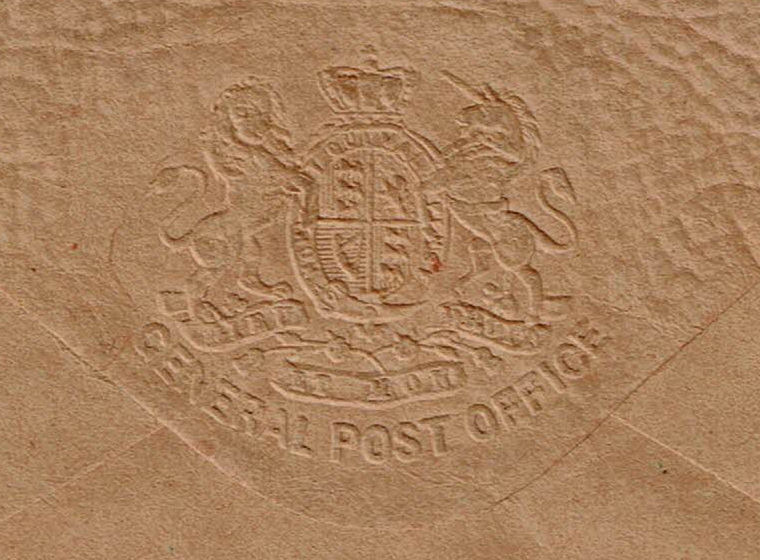
There is a porterage charge of 6d and a Coat of Arms embossed on the flap.
No printers imprint or date - Images courtesy of Edward Coombes.
Both of these also have embossed flaps and no imprints. My Provisional Ref: PO_Env_Del_1 and PO_Env_Del_2
Unused, with "PORTERAGE." (with box for charge), on the second line. My Provisional Ref: PO_Env_Port_1
This is very similar to the image shown on page 21 of Form H2. Typical size 148 x 84 mm
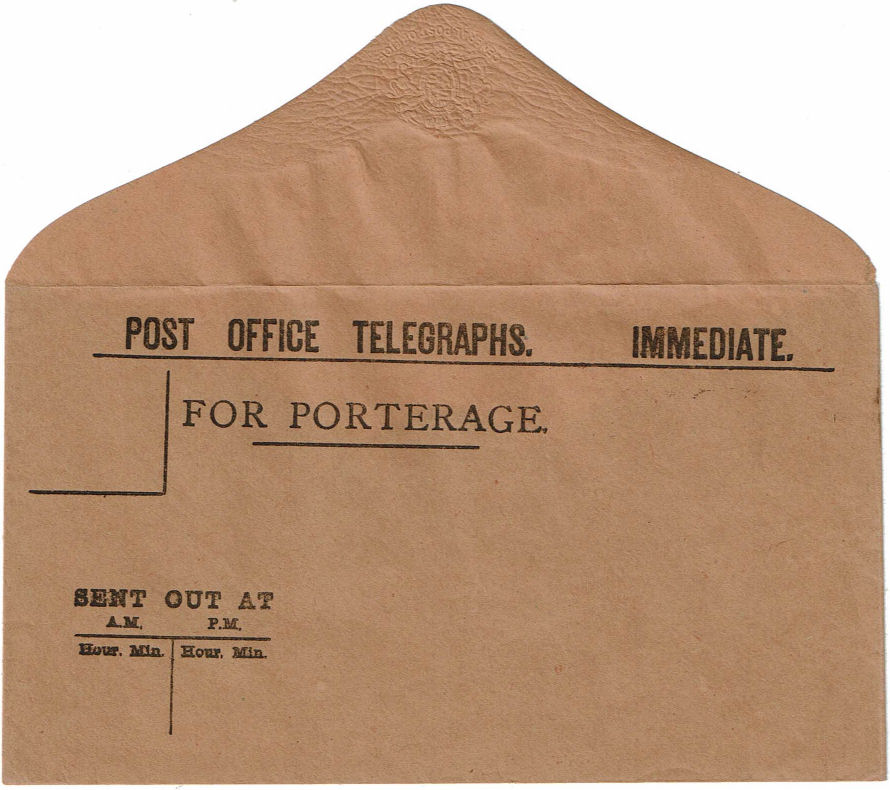
Otherwise similar to last. Still with embossed Coat of Arms embossed on the flap.
No printers imprint or date - Image courtesy of Edward Coombes.
This and the following ones do NOT have embossed flaps. My Provisional Ref: PO_Env_Charges_1
Long lasting design by Waterlow & Sons Limited. Fairly consistent size of about 127 x 82 mm., but position of printing rather variable. Earliest seen dated October 1882. (displayed at about 83% normal scale)
My Provisional Ref: PO_Env_Del_4
Another example of the same type with an overprint. My Provisional Ref: PO_Env_Del_4b
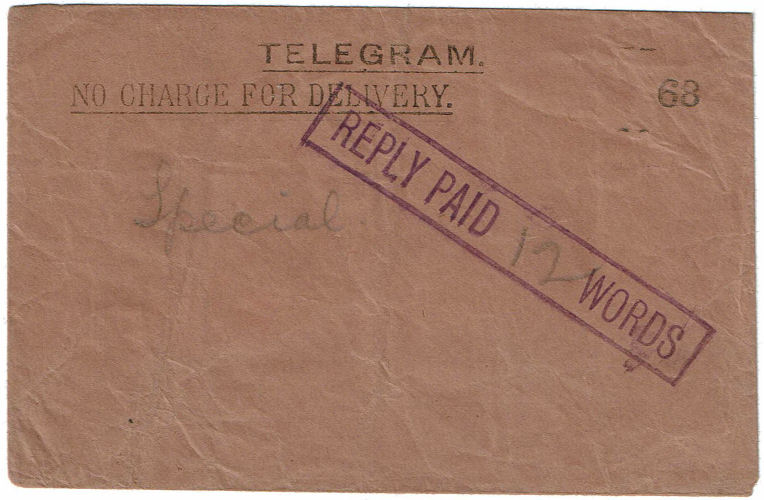
Purple rectangular boxed cachet stating REPLY PAID 12 WORDS. The "68" was presumably a reference number.
This was was received in Birmingham on 18th June 1888 - Image courtesy of Edward Coombes.
Similar to earlier types, but now with "TELEGRAM" (3 mm caps). My Provisional Ref: PO_Env_Port_2
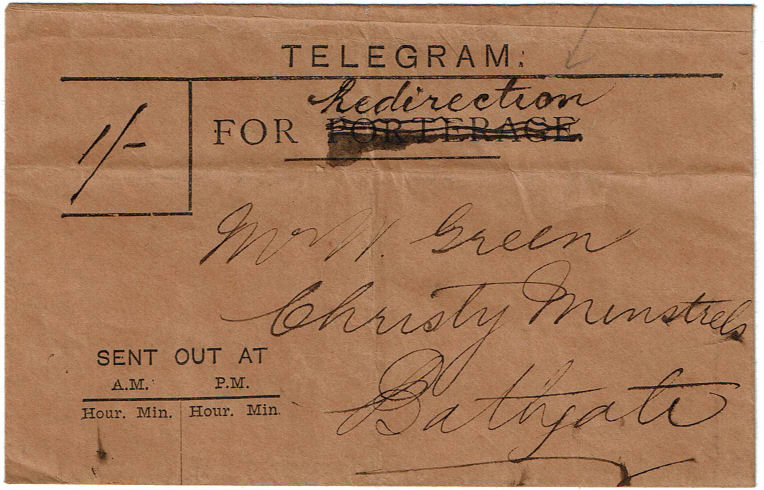
This was "FOR PORTERAGE" (4 mm caps), but Porterage crossed out and Redirection handwritten.
Printed SENT OUT AT details. Telegram sent from within Alnwick then redirected to Bathgate at a cost of 1/-
1878-82?? - Image courtesy of Edward Coombes.
Similar to above, but without the SENT OUT AT details and change of use. My Provisional Ref: PO_Env_Port_3
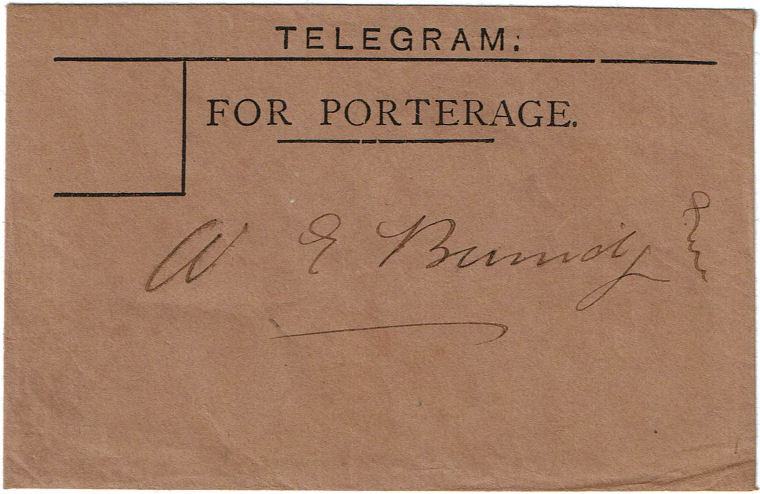
Corresponding telegram inside was dated 20th March 1885.
Image courtesy of Edward Coombes.
Well this is different ! My Provisional Ref: PO_Env_Royal_1

Size 234 x 108 mm on thick white card. Printed by Waterlow & Sons, Limited, London wall, London. Perhaps used by the Royal Family and/or Ministerial Governmental Departments?
"POST OFFICE TELEGRAPHS" and the London Wall Waterlow address suggests that this is quite early.
Image courtesy of Edward Coombes.
On Her Majesty's Service. (O.H.M.S. - size 133 x 79 mm) My Provisional Ref: PO_Env_OHMS_1
-envs-1888-23022021.jpg)
"N0. 14." at top-right and "Post Office" at bottom-left. This has been authenticated in purple by Leonard Bidwell (Chief Clerk of the Post Office)
Official Paid London cancel in red dated 6 June 1888. Image courtesy of Edward Coombes.
POST OFFICE TELEGRAPHS No. 22. Size 100 x 75 mm My Provisional Ref: PO_Env_Pay_1
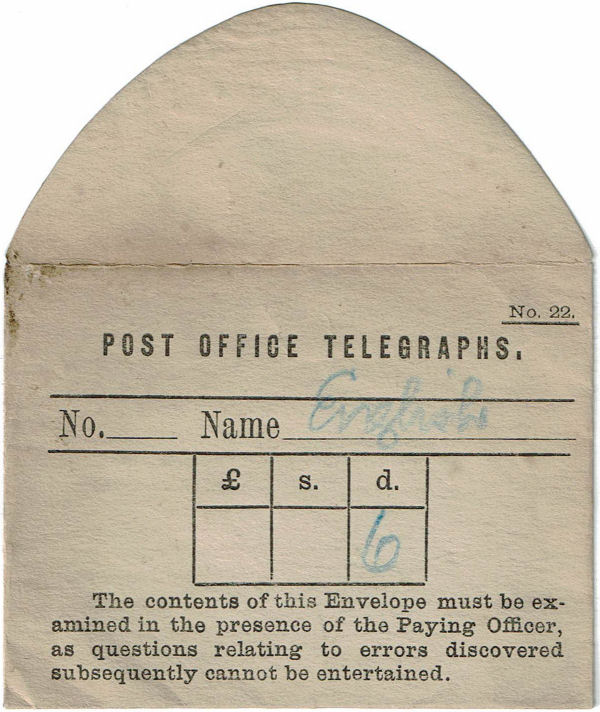
"N0. 22." on thick white/cream paper. This GPO envelope was used to collect additional charges.
Typically porterage, but could be for redirection. In this case 6d was collected from the telegram recipient.
It says on the envelope "The contents of this Envelope must be examined in the presence of the Paying Officer,
as questions relating to errors discovered subsequently cannot br entertained."
- Image courtesy of Edward Coombes.
The Post Office had a system for expressing the time using one, two or three letters, which could be sent as Morse Code.
This is a card of 1909 explaining the system and codes used. It is marked "T.—No. 15." at the top-left.
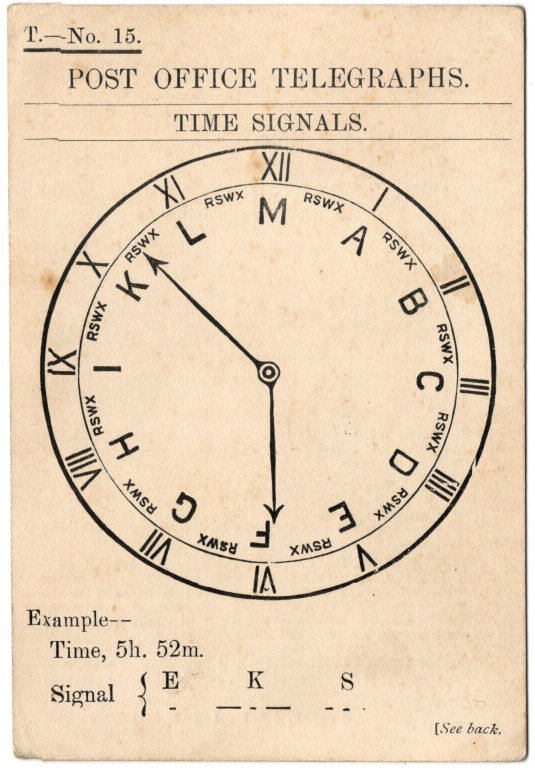

The imprint on the back suggests that this was printed by Griffith & Sons in July 1909.
![]()
Images courtesy of AJM Philately on eBay. Click image for listing.
| Provisional Reference | Name | Form | Colour | Date on form | Date used | Printer | Size inches | Size mm. | Front | Back | Comments |
|---|---|---|---|---|---|---|---|---|---|---|---|
| ICM-4/21-RPBW | Imp. Cab. | CSM/I | black | 13/4/21 | 30/9/21 | R. P. & B. W. Ltd. | 7.9 x 9.8 | 200 x 250 | Information. Message. | - | "State Owned", Coat of Arms |
| ICM-7/24-MCL | Imp. Cab. | CSM/I | black | July 1924 | 27/9/25 | M. & C. Ltd. | 7.9 x 9.8 | 202 x 250 | Information. Message. | - | "The All Red Route" |
| ICM-10/26-McC | Imp. Cab. | CSM/I | black | October 1926 | 25/11/27 | McCorquodale | 7.9 x 9.8 | 200 x 248 | Information. Message. | - | "The All British Route" |
| ICM-2/27-WSL | Imp. Cab. | CSM/I | black | February 1927 | 22/5/27 | W. & S. Ltd | 7.9 x 9.8 | 200 x 248 | Information. Message. | - | "The All British Route" |
| ICM-6/27-WHS | Imp. Cab. | CSM/I | black | June 1927 | 28/7/28 | W.H. & S | 7.9 x 9.8 | 202 x 252 | Information. Message. | - | " " + Enquiries |
| ISD-2/25-WSL | Imp. Cab. | S - Deff. | green | February 1925 | - | W. & S. Ltd | 8.4 x 8.9 | 214 x 226 | Notice. Message. | Info, Cond, imprint | LC for language |
| ISD-5/27-WSL | Imp. Cab. | S - Deff. | green | May 1927 | - | W. & S. Ltd | 7¾ x 8¾ | 197 x 222 | Notice. Message. | Info, Cond, imprint, A22 | LC or TWT/DLT/TLT |
| ISW-11/26-GS | Imp. W.S. | S | black | November 1926 | - | G & S | 8.2 x 9.8 | 207 x 249 | Notice. Message. imprint | Info, Cond. A30 | TWT/DLT/TLT |
| ISW-11/26-BFL | Imp. W.S. | S - Deff. | green | November 1926 | - | B.&F. Ltd | 8¼ x 8.9 | 210 x 226 | Notice. Message. | Info, Cond. imprint. A31 | LC for language |
| ISW-10/27-TWJM | Imp. W.S. | S - Deff. | green | October 1927 | - | T.&W. and J.M. Ltd | 7¾ x 10¼ | 196 x 260 | Notice. Message. | Info, Cond. imprint. A31 | LC or TWT/DLT/TLT |
| ISW-10/28-WSL | Imp. W.S. | S | red | October 1928 | - | W. & S. Ltd | 7.9 x 10¼ | 203 x 260 | Notice. Message. | Info, Cond. imprint. A30 | DLT/NLT/WLT/PLT |
| ITW-3/29-TWJM | Imp. W.S. | T | red | March 1929 | - | T.&W. and J.M. Ltd | 7¼ x 9.7 | 183 x 246 | Notice. Message. | Info, Cond. imprint. A30 | DLT/NLT/WLT/PLT |
| IWM-6/27-Harr-CA | Imp. W.S. | CSM/IW | black | 5/27 & 6/27 | 5/12/27 | Harrow | 8.1 x 9.8 | 205 x 252 | .Message. imprint. C11 | - | CA |
| IWM-1/28-TWJM-SA | Imp. W.S. | CSM/IW | red | January 1928 | 5/8/28 | T.&W. and J.M. Ltd | 8¼ x 9.8 | 208 x 251 | .Message. imprint. C11 | - | SA |
| IWM-9/28-Harr-AU | Imp. W.S. | CSM/IW | red | September 1928 | 2/12/28 | Harrow | 8¼ x 9.8 | 209 x 251 | .Message. imprint. C11 | - | AU |
| IWM-9/28-Harr-IN | Imp. W.S. | CSM/IW | red | September 1928 | 9/2/29 | Harrow | 8¼ x 9.8 | 210 x 250 | .Message. imprint. C11 | - | IN |
| IIC-17A-LP-Clk | Imp. I.C.Ltd | 5/17A | brown, yellow | - | 20/1/31 | L & P (c) | ? | ? | .Message. Instructions | ? | Map, Eastern-Style time-clock |
| IIC-17A-LP-W | Imp. I.C.Ltd | 5/17A | red, tan | - | 16/12/32 | L & P (c) | 8.2 x 8½ | 208 x 216 | .Message. Instructions | ? | Map, Red W |
| IIC-17A-LP-161 | Imp. I.C.Ltd | 5/17A | red, tan | - | 11/4/33 | L & P (c) | ? | ? | .Message. Instructions | ? | Map. "5/17A - 161" |
| IIC-Env-1931 | Imp. I.C.Ltd | - | Mauve | - | 11/2/31 | ? | ? | ? | Logo, "Letter Telegram" | Return Address | Envelope |
| CWL-158-6/34-LP | C.W. Ltd | 5/-158 | green | June 1934 | 15/1/35 | L & P (c) | 8¼ x 8.6 | 210 x 218 | .Message. Instructions | Information / Addresses | Map |
| CWL-158-9/35-LP | C.W. Ltd | 5/-158 | green | September 1935 | 1/2/36 | L & P (c) | 8¼ x 8.6 | 210 x 218 | .Message. Instructions | Information / Addresses | Map |
| CWL-159A-9/38-LP | C.W. Ltd | 5/-159/A | green | September 1938 | 15/12/39 | L & P (c) | 8.2 x 8¾ | 208 x 223 | .Message. Instructions | Information / Addresses | Map, A |
| CWL-9/42-LP | C.W. Ltd | - | green | September 1942 | 15/8/43 | L & P (c) | 7¼ x 8¼ | 185 x 209 | .Message. Instructions | Information / Addresses | Map and left-side information gone |
| CWL-Env-7-38 | C.W. Ltd | - | blue | July 1938 | 6/5/40 | ? | ? | ? | Logo, "Telegram" | "Via Imperial" | Envelope |
| CWL-Env-9-39 | C.W. Ltd | - | blue | September 1939 | 7/2/41 | ? | ? | ? | Logo, "Telegram" | "Via Imperial" | Envelope |
For reasons of presumably National Security and prosperity, the British Government wanted to establish a global network entirely under British control.
The "Imperial" banner was a way to make that happen, with unabashed use of jingoistic slogans.
With the completion of the All Red Line in 1902 and availability of long-distance radio-telegraphy, it became viable for the Post Office to enter the fray about 1921.
Post Office Telegraphs "Imperial Cable ". The form was used 30 September 1921. Sent from Montreal.
The imprint at top-left reads "23993-Wt. 1789-1514-2000 Pads-13/4/21-The R. P. & B. W. Ltd. (E7455)." suggesting a printing date of 13 April 1921.
I would take the form number below as being a large "C" as a PO form C (a delivery form), with "SM" for Submarine, over "I" for Imperial.
A narrow, central Coat of Arms. Nothing on the back.
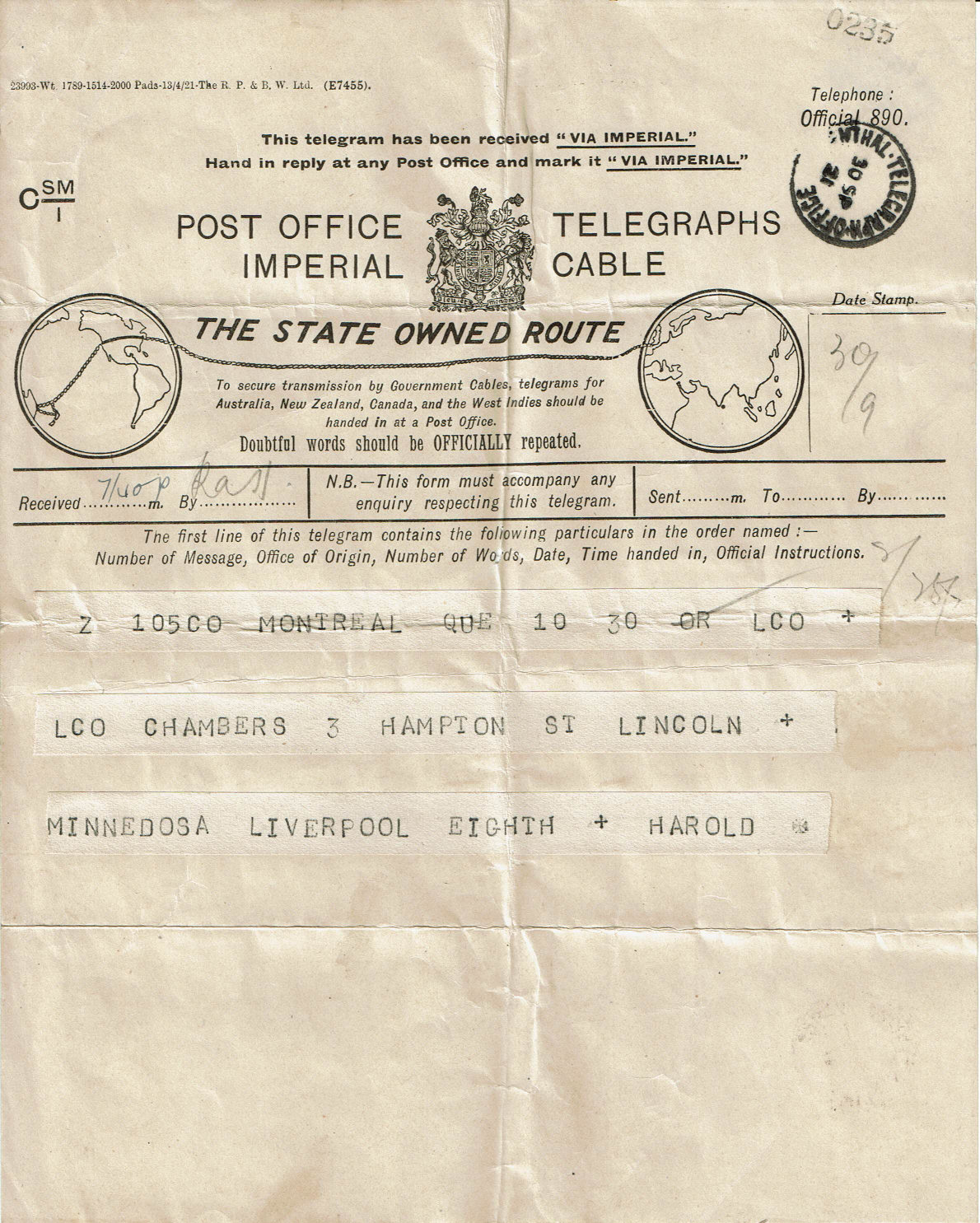
Image courtesy of Edward Coombes.
Post Office Telegraphs "Imperial Cable ". The form was used 27 September 1925. Sent from Vancouver, British Columbia.
"The All Red Route". No Coat of Arms. Nothing on the back.
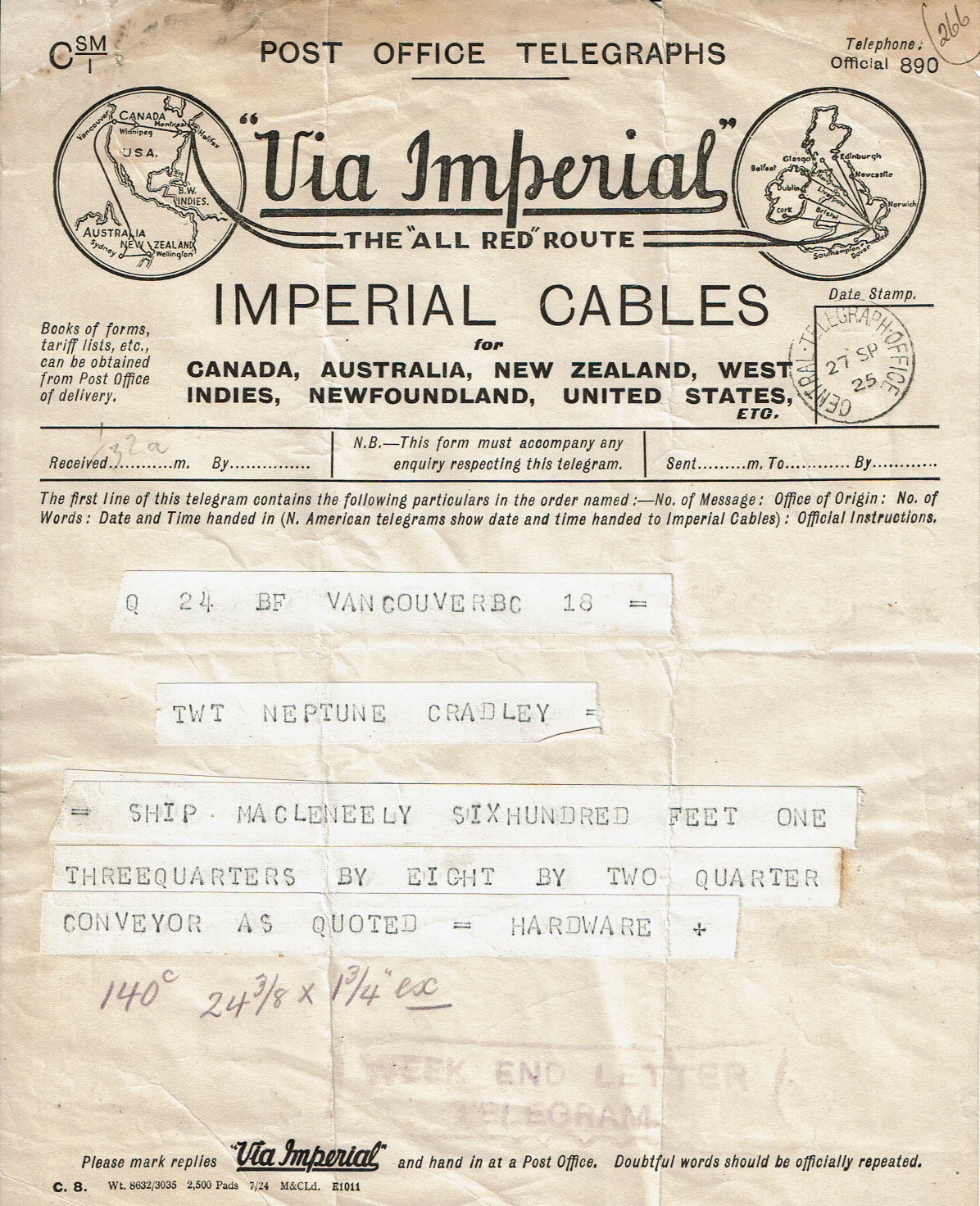
"C. 8." at bottom-left, with an imprint reading "Wt. 8632/3035. 2,500 Pads. 7/24. M&CLd. E1011", which I take to mean 2,500 pads printed by "M. & C. Ltd. " in July 1924.
Stamped "WEEK END LETTER TELEGRAM.". Image courtesy of Edward Coombes.
Post Office Telegraphs Via Imperial "The All British Route". The form is dated October 1926 and it was used 25 November 1927. Sent from Wellington, New Zealand to Edinburgh.
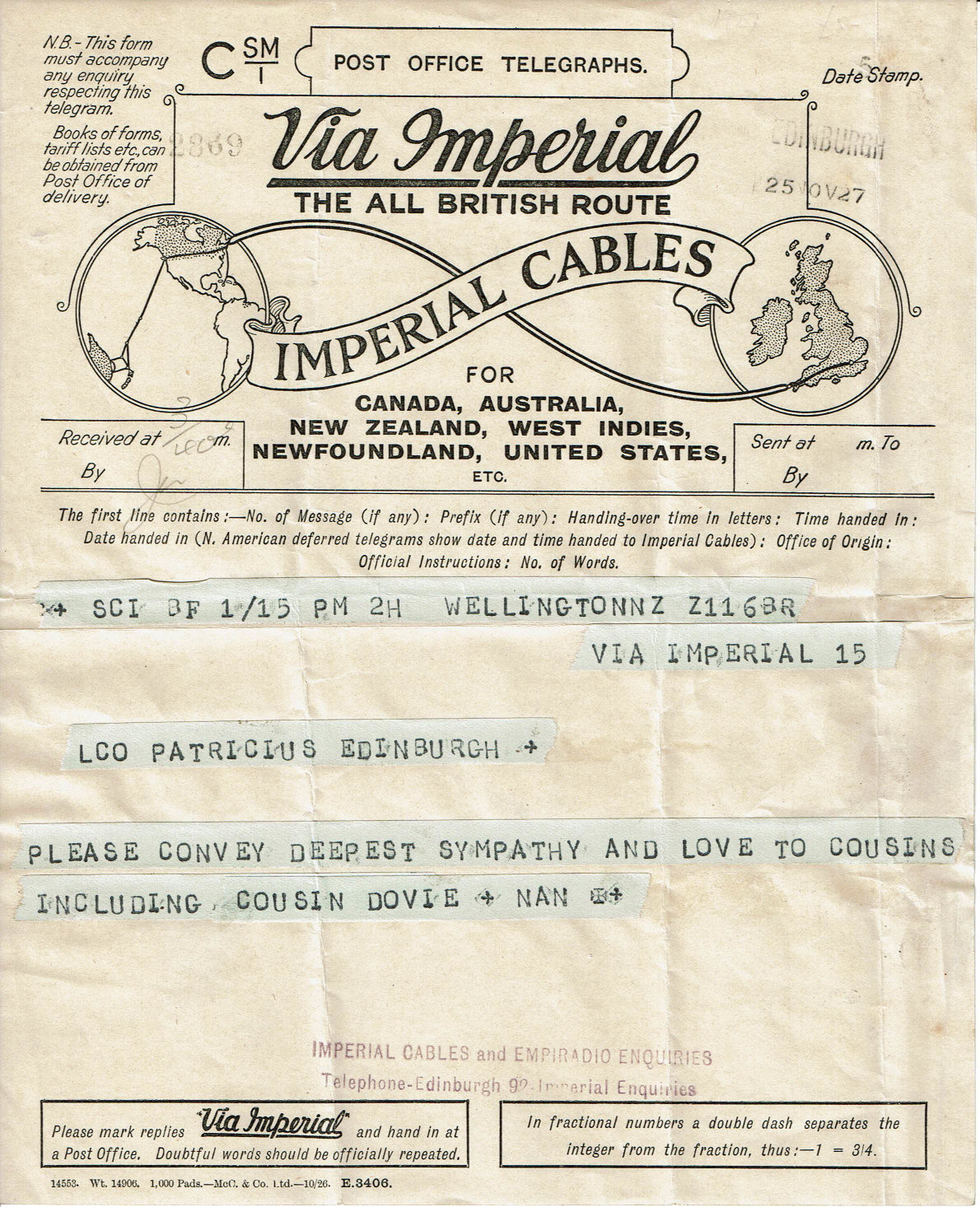
The imprint at bottom-left reads "14553. Wt. 14906. 1,000 Pads.—McC. & Co. Ltd.—10/26. E.3406", which I take to mean 1,000 pads printed by McCorquodale in October 1926.
There is nothing on the back. Image courtesy of Edward Coombes.

A variant of this type used in Walsall on 22 May 1927, with an imprint reading "255784—Wt.22862/411—1,000 pads—2-27—W. & S. Ltd.—(E.3711)." Courtesy of Edward Coombes.
Post Office Telegraphs, very similar to the last, used 28 July 1928. Sent from New Zealand to London.
Added now at top-right is "Enquiries by Telephone: London, Central 3600, Extn. 890. Elswhere, Head Post Office of District.".
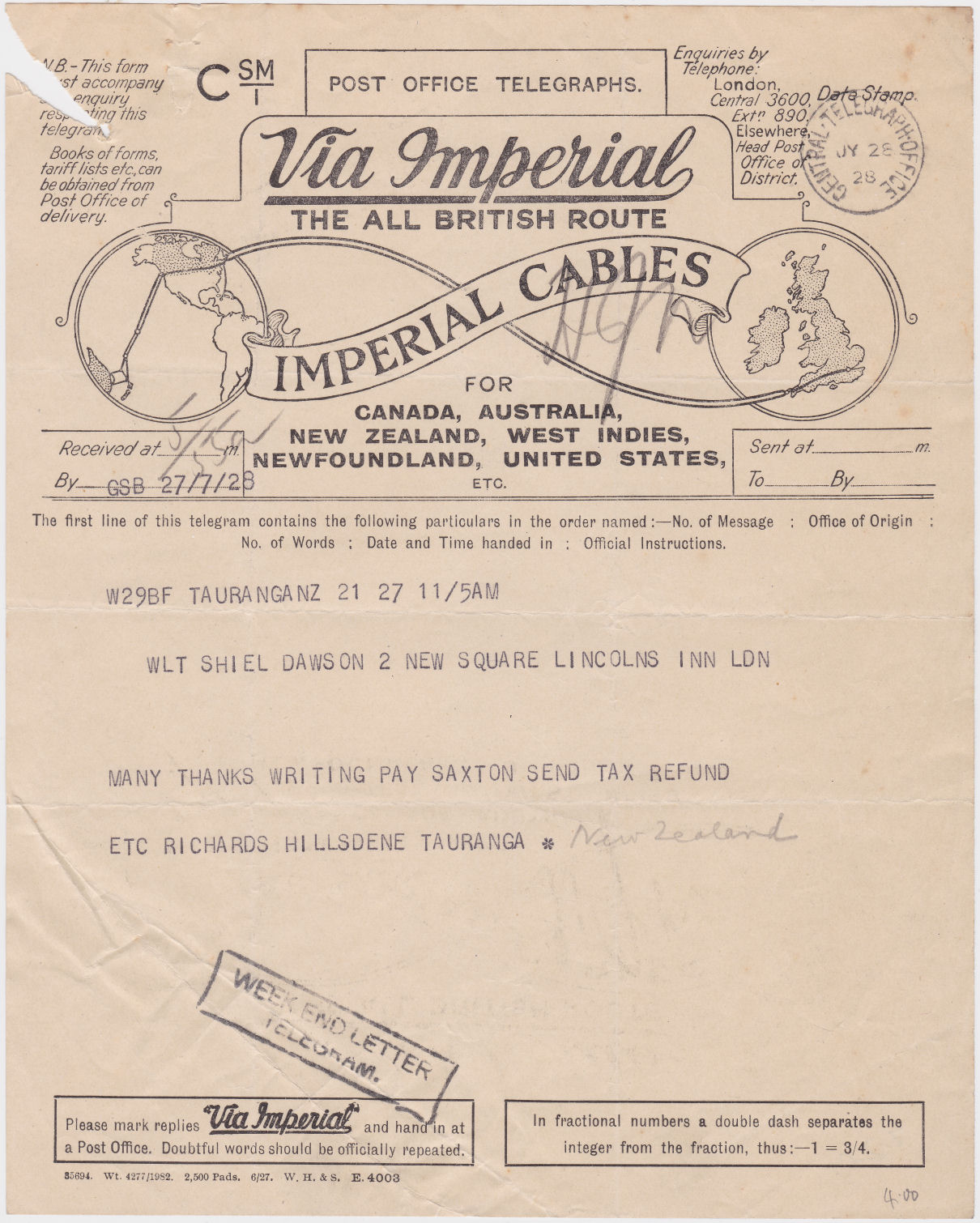
The imprint at bottom-left reads "35694. Wt. 4277/1982. 2,500 Pads. 6/27. W. H. & S. E. 4003", which I take to mean 2,500 pads printed by "W.H. & S" in June 1927.
That could be Harrison & Sons. Stamped "WEEK END LETTER TELEGRAM.". There is nothing on the back.
Post Office Telegraphs "Imperial Cables Form for Deferred... ". The form back is dated February 1925 . It is unused. There is an "S" at top-right (Sending ?).
The "LC" was to indicate language used, with "LCO" for Engilsh, "LCF" for French, and "LCD" for other.
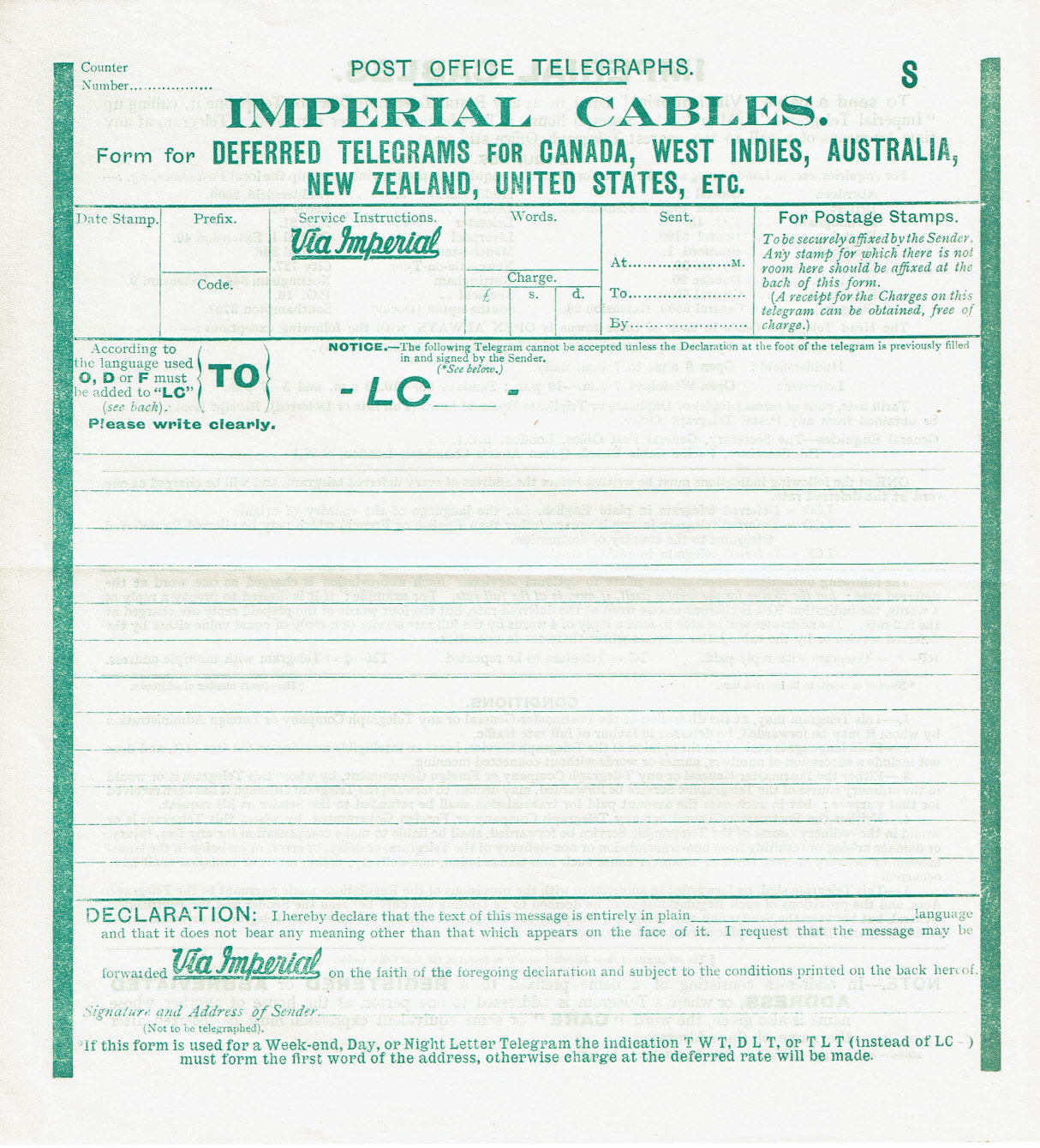
This now has a section on the bottom explains the use of "TWT", "DLT" and "TLT" in place of "LC" above, for Week-end, Day, or Night Letter Telegrams.
The back gives instructions, conditions and contact information.
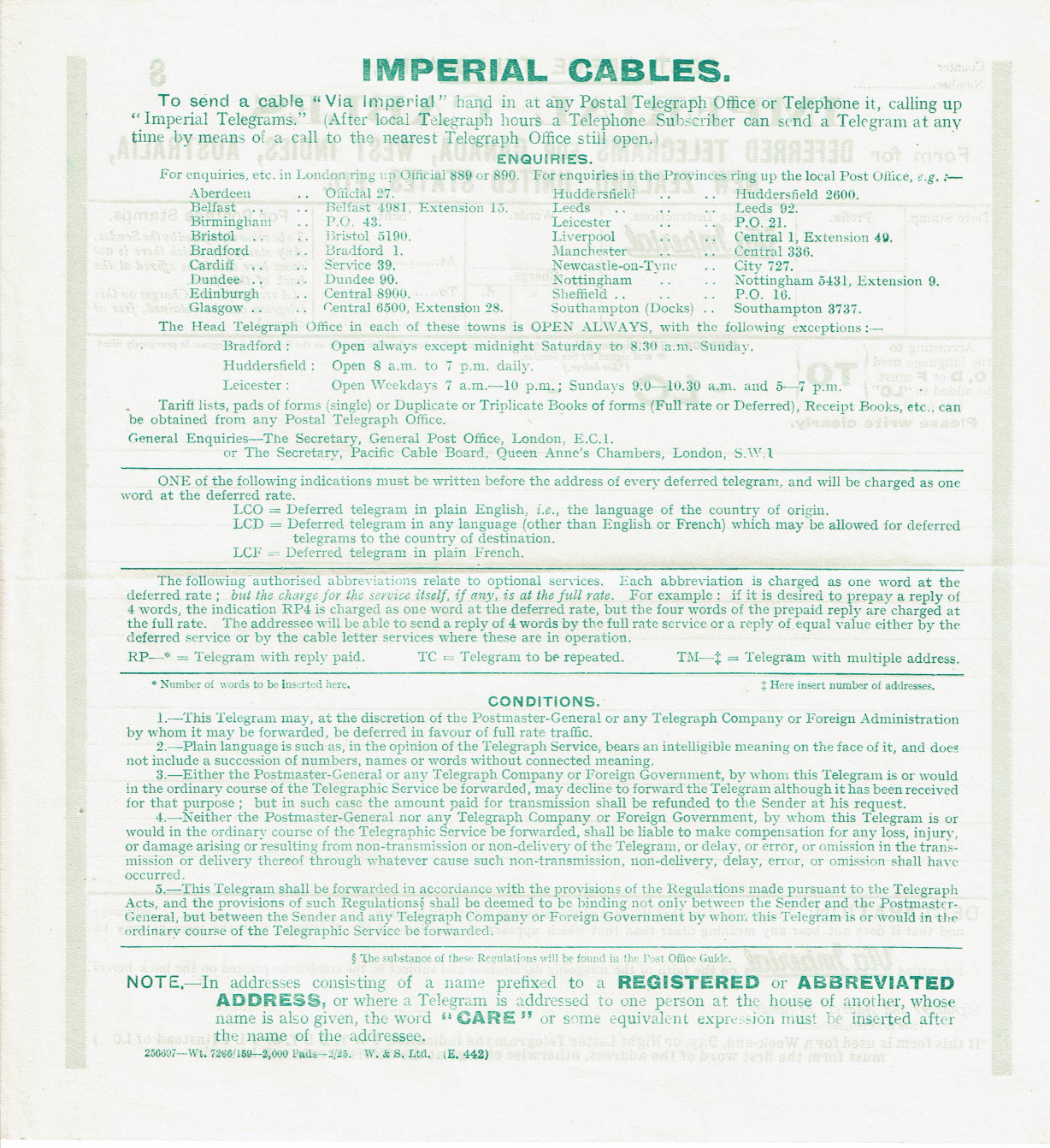
The imprint at bottom-left reads "256697—Wt. 7266/159—2,000 Pads.—2/25. W. & S. Ltd. (E. 442)", which I take to mean 2,000 pads printed by W. & S. Ltd in February 1925.
Images courtesy of Edward Coombes.
Post Office Telegraphs "Imperial Cables Form for Deferred... ". The form back is dated May 1927 . It is unused. There is an "S" at top-right.
The "LC" was to indicate language used, with "LCO" for English, "LCF" for French, and "LCD" for other.
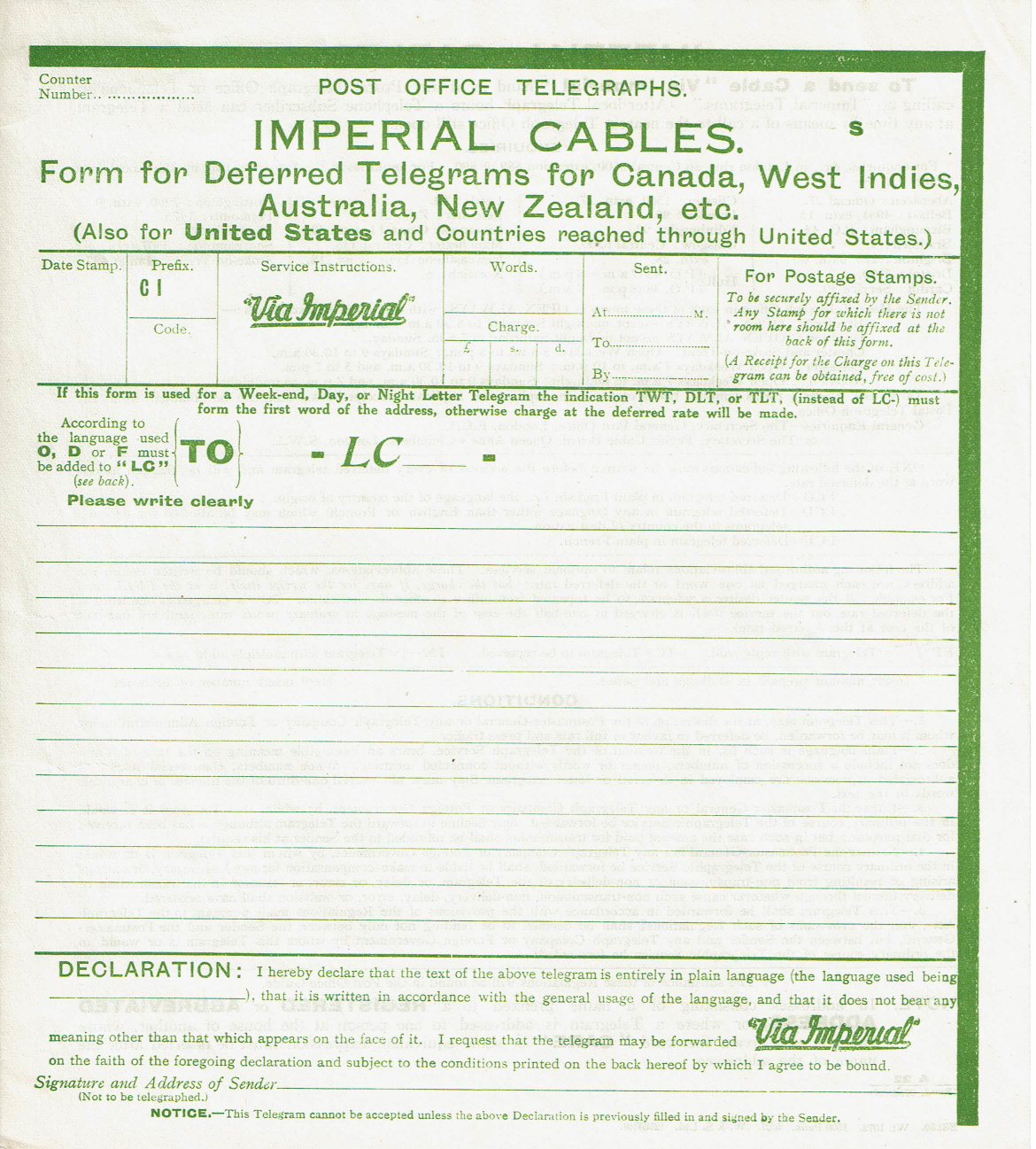
The back gives instructions, conditions and contact information.
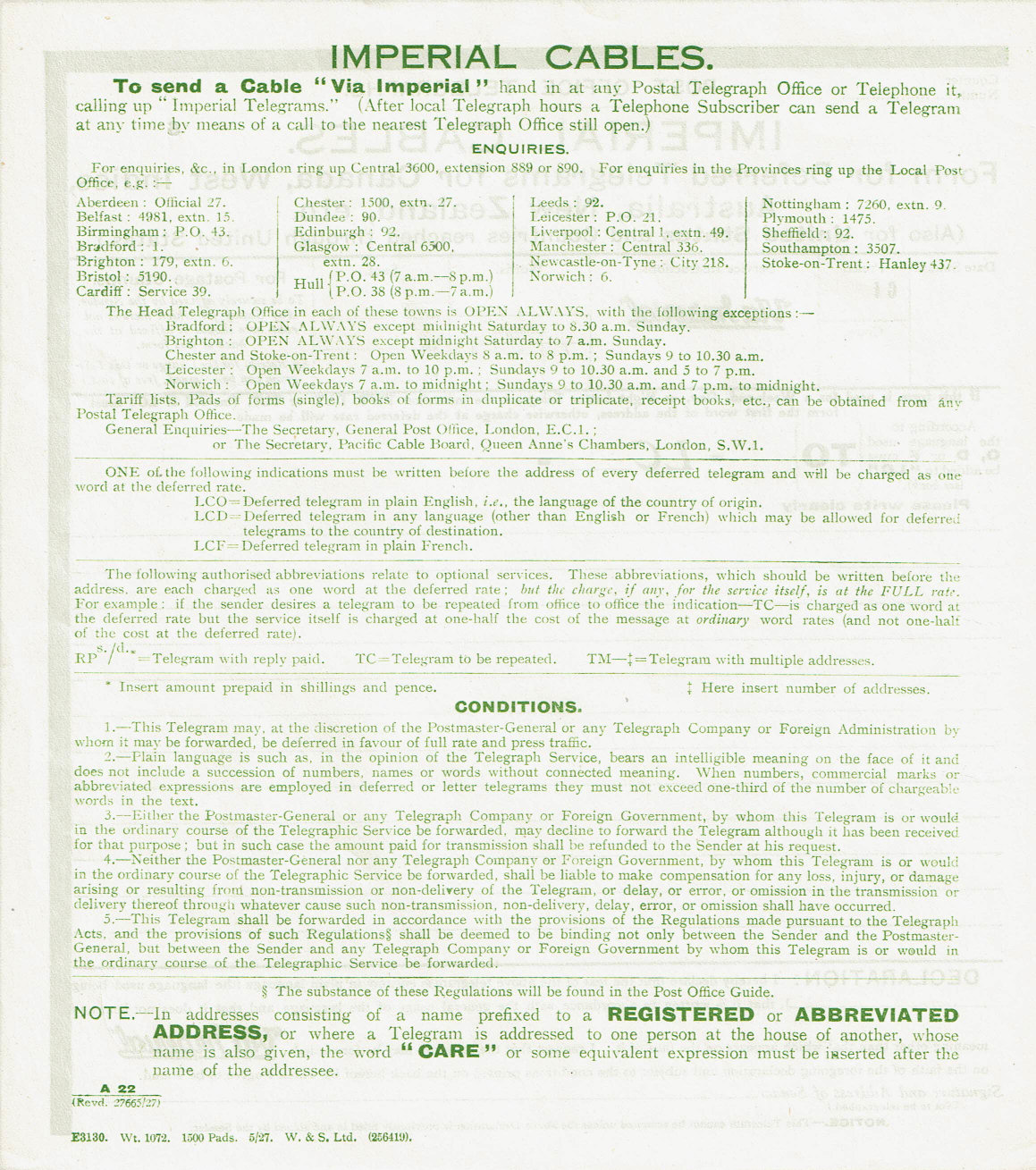
The imprint at bottom-left reads "E3130. Wt. 1072. 1500 Pads. 5/27. W. & S. Ltd. (256419).", which I take to mean 1,500 pads printed by W. & S. Ltd in May 1927.
But above that is "A22 / (Revd. 27665/27)". Images courtesy of Edward Coombes.
Early radio used long wave which could travel long distances but required a tall radio mast which was not directional.
The transmitting stations were expensive and lacked security of the transmissions. Nevertheless it could provide a cheaper service to customers and was impacting the profitablity of the cable companies.
The advent of "BEAM WIRELESS." radio technology with directional shorter wavelengths, brought down costs and had some slight extra security.
At that point the cable companies had to do something. They still had the advantage of security, making them neccessary for financial and military purposes, but their income was sharply declining.
The Imperial had to offer a Wireless Service too.
Post Office Imperial Wireless Services Form dated November 1926, as last, but in green and Deferred. It is unused. There is an "S" at top-right.
The "LC" was to indicate language used, with "LCO" for Engilsh, "LCF" for French, and "LCD" for other.
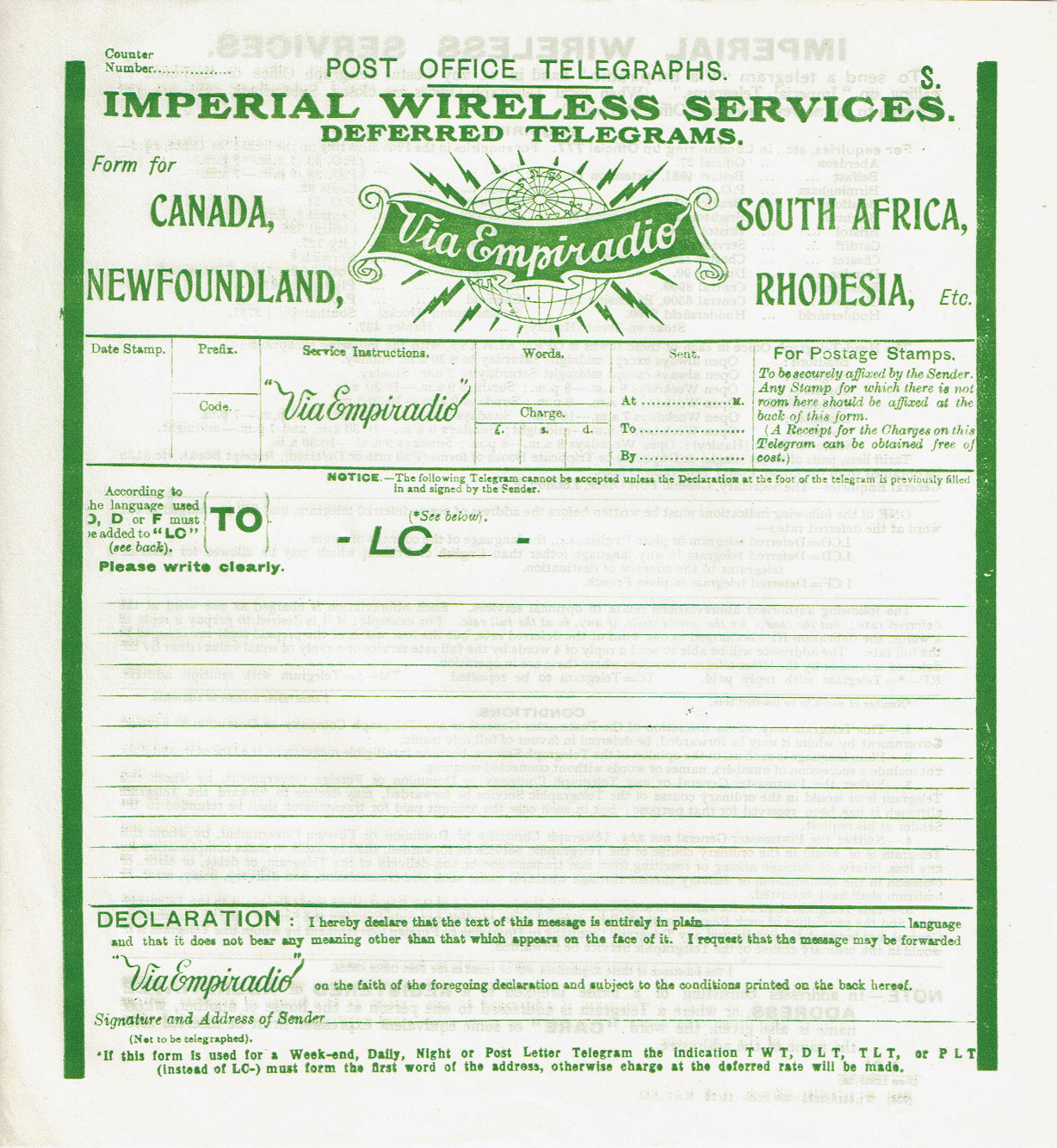
This now has a section on the bottom explains the use of "TWT", "DLT" and "TLT" in place of "LC" above, for Week-end, Daily, Night or Post Letter Telegrams.
The back gives instructions, conditions and contact information.
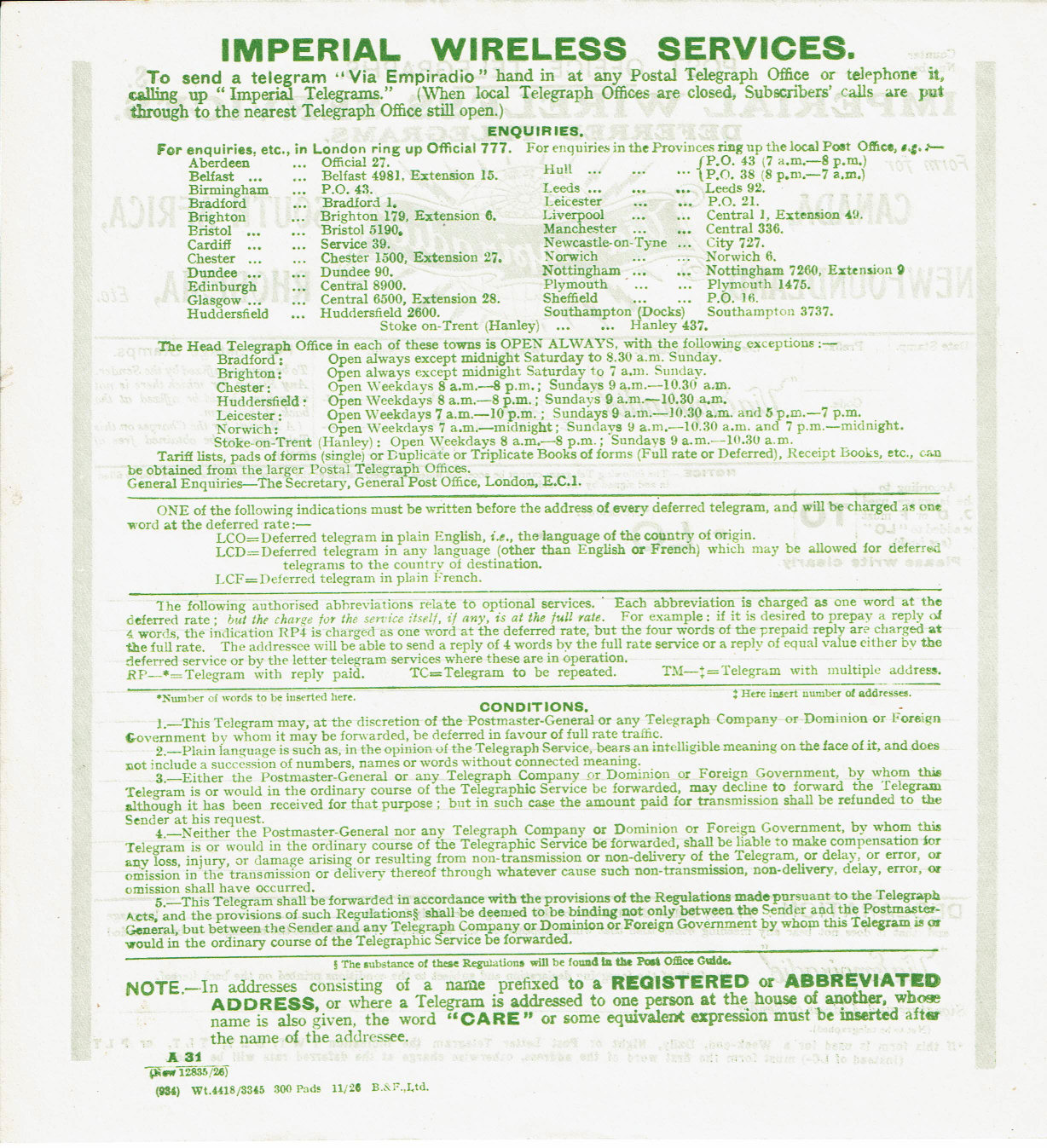
The imprint at bottom-left reads "(934) Wt.4418/3345 300 Pads 11/26 B.&F., Ltd.", which I take to mean 300 pads printed by B.&F. Ltd in November 1926.
Above that is "A31 / (New 12835/26)". Images courtesy of Edward Coombes.
Post Office Imperial Wireless Services Form dated October 1927, in a darker green and Deferred. It is unused. There is an "S" at top-right.
The "LC" box now has instructions explaining the use of "TWT", "DLT" and "TLT" in place of "LC" above, for Week-end, Daily, Night or Post Letter Telegrams..
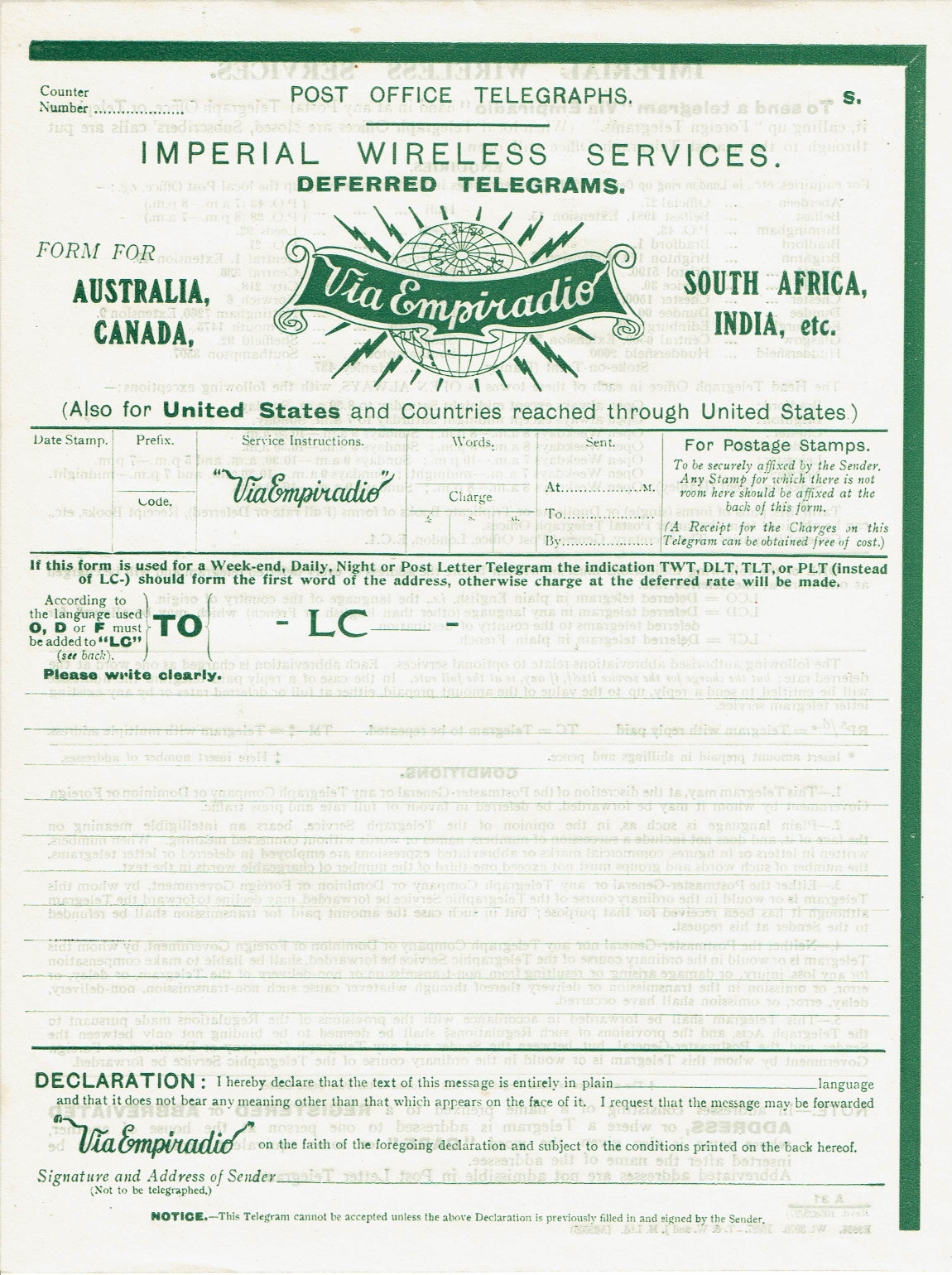
Imprints and instructions gone from the bottom-front.
The back gives instructions, conditions and contact information.
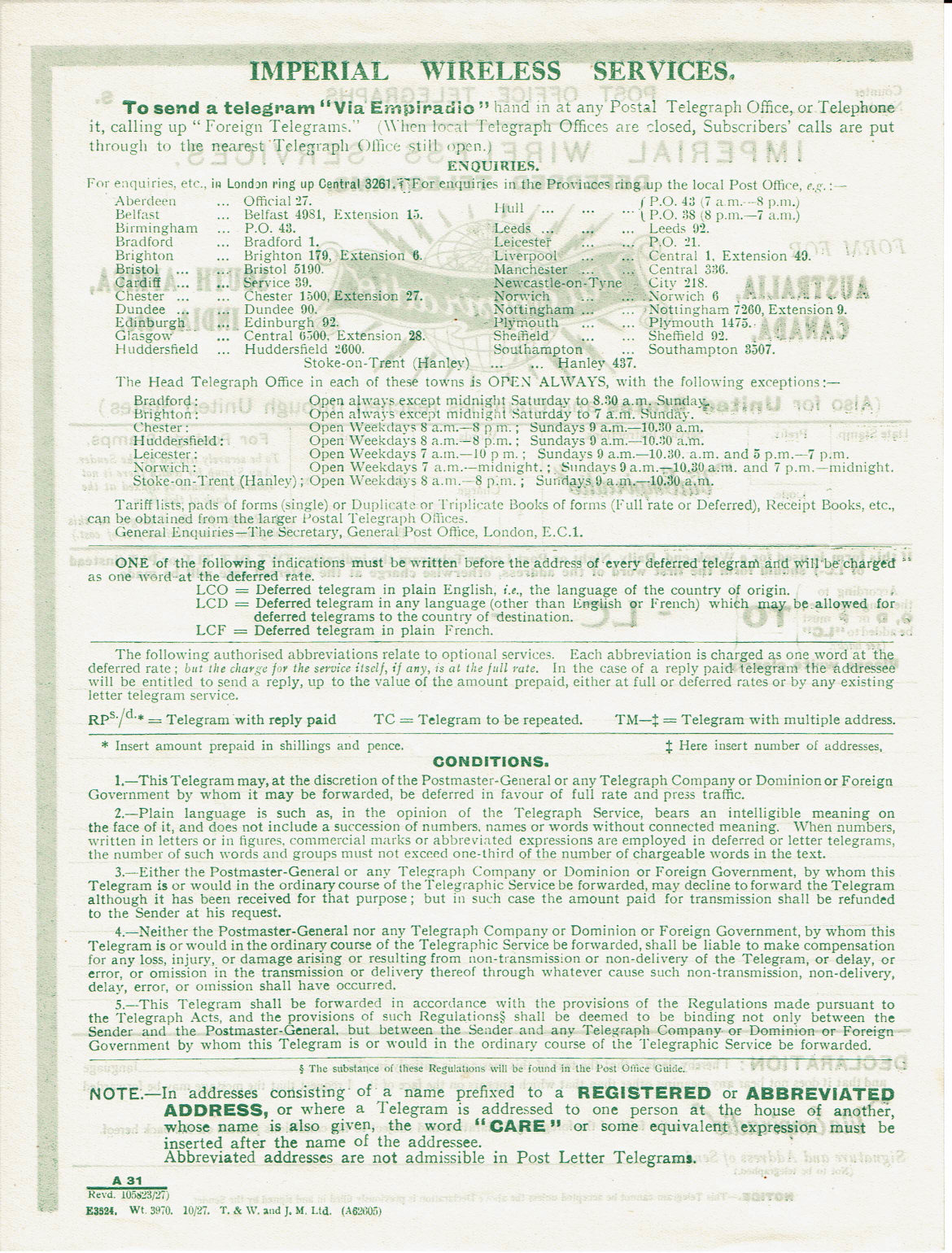
The imprint at bottom-left reads "E3524, Wt. 3970. 10/27. T. & W. and J. M. Ltd (A62605)", which I take to mean printed in October 1927.
Above that is "A31 / (Revd. 105823/27)". Images courtesy of Edward Coombes.
Post Office Imperial Wireless Services Form dated October 1928, in red (NOT Deferred). It is unused. There is an "S" at top-right.
The "LC" is gone from the box, but it has instructions explaining the use of "TWT", "DLT" and "TLT" for Week-end, Daily, Night or Post Letter Telegrams.
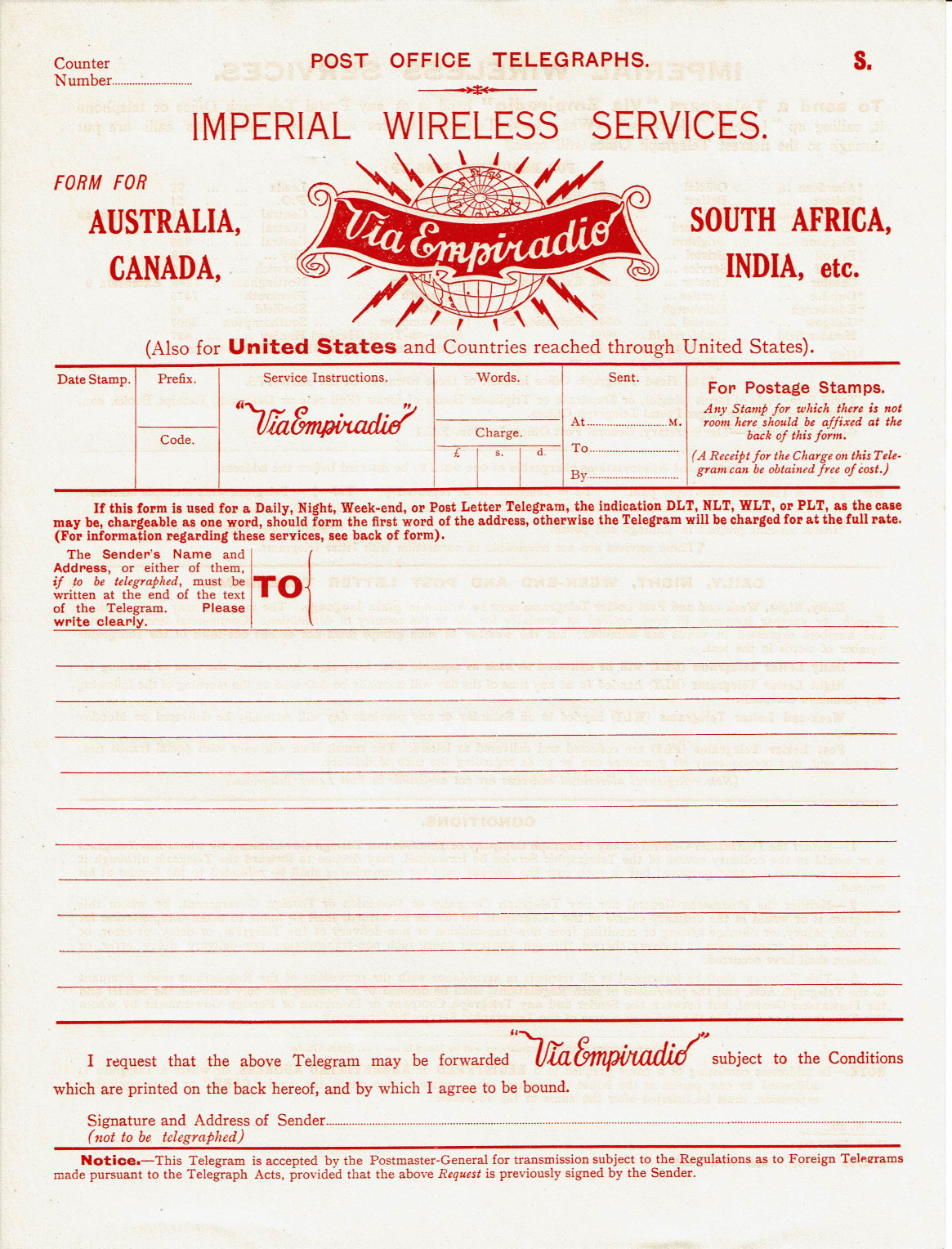
Just the Notice on the bottom-front.
The back gives instructions, conditions and contact information.
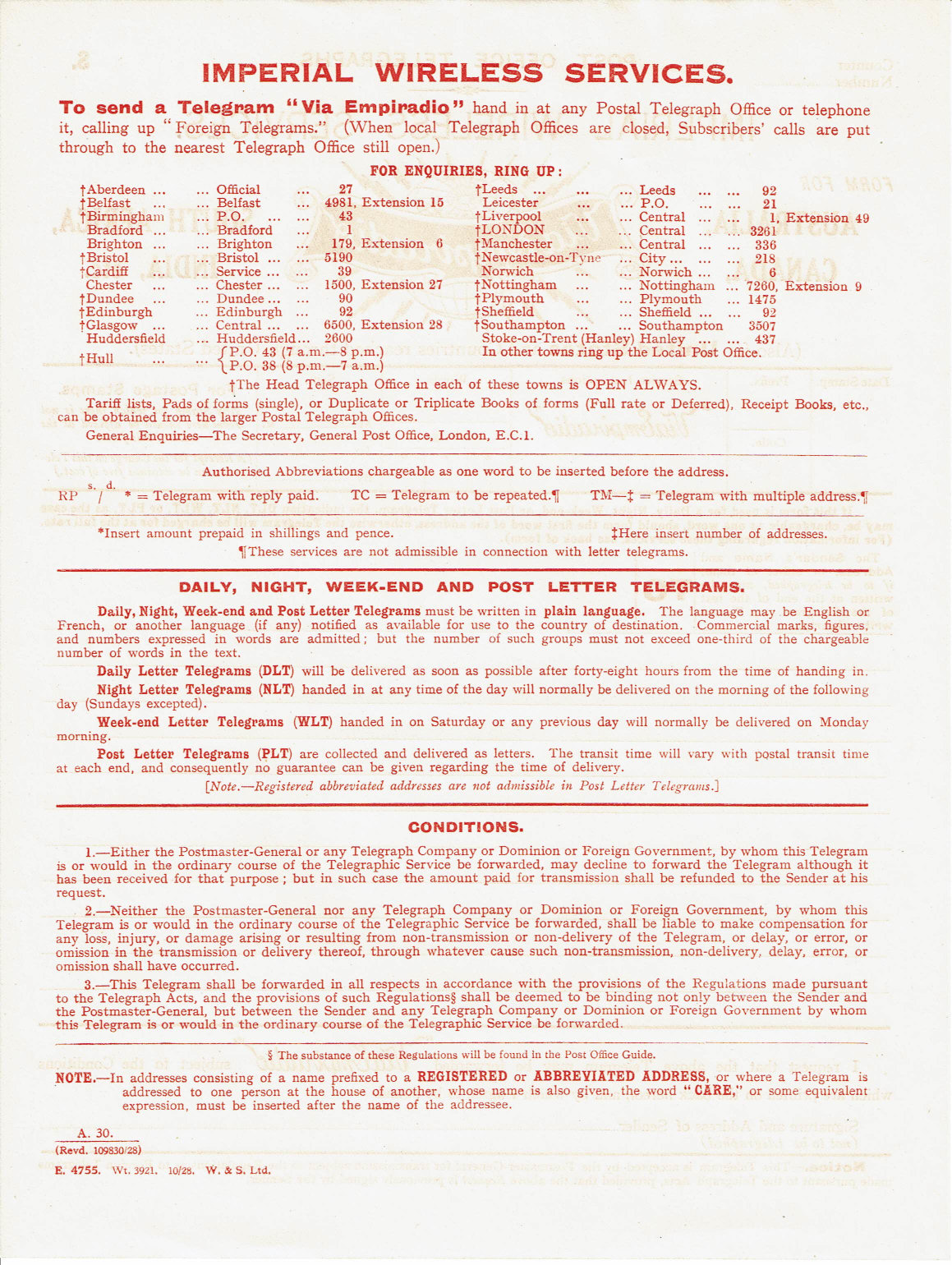
The imprint at bottom-left reads "E. 4755. Wt. 3921. 10/28. W. & S. Ltd.", which I take to mean printed in October 1928.
Above that is "A30 / (Revd. 109830/28)". Note that the format of the revision matches the format used for P. O. References placed on their communications.
They seem to have got through about 10,000 per month. Images courtesy of Edward Coombes.
Post Office Imperial Wireless Services Form dated March 1929, in red (NOT Deferred). But there is an "T" at top-right.
The "Sent" box is highlighted. The left edge is serrated, so presumably is from a pad.
The "LC" is gone from the box, but it has instructions explaining the use of "TWT", "DLT" and "TLT" for Week-end, Daily, Night or Post Letter Telegrams.
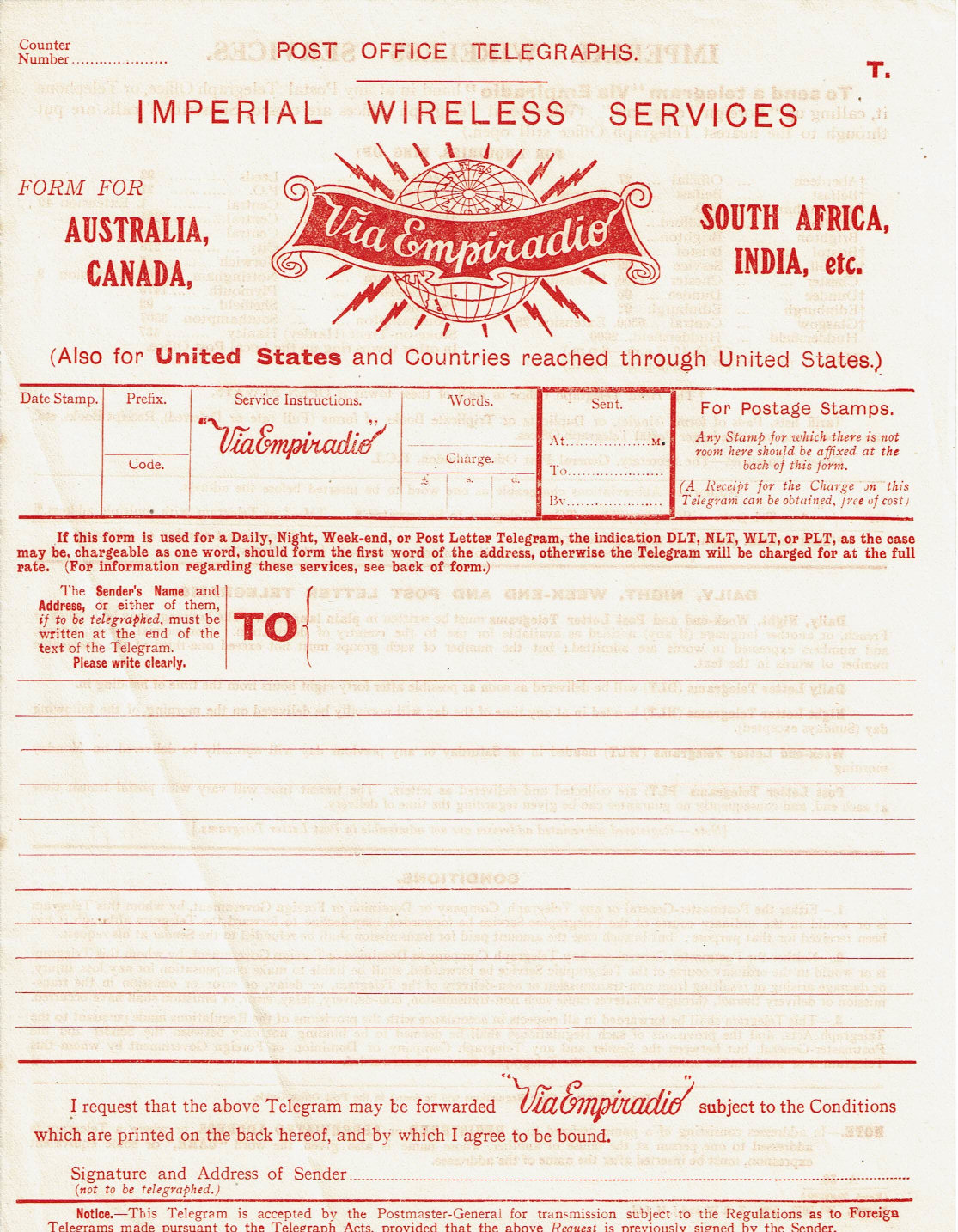
Just the Notice on the bottom-front.
The back gives instructions, conditions and contact information.
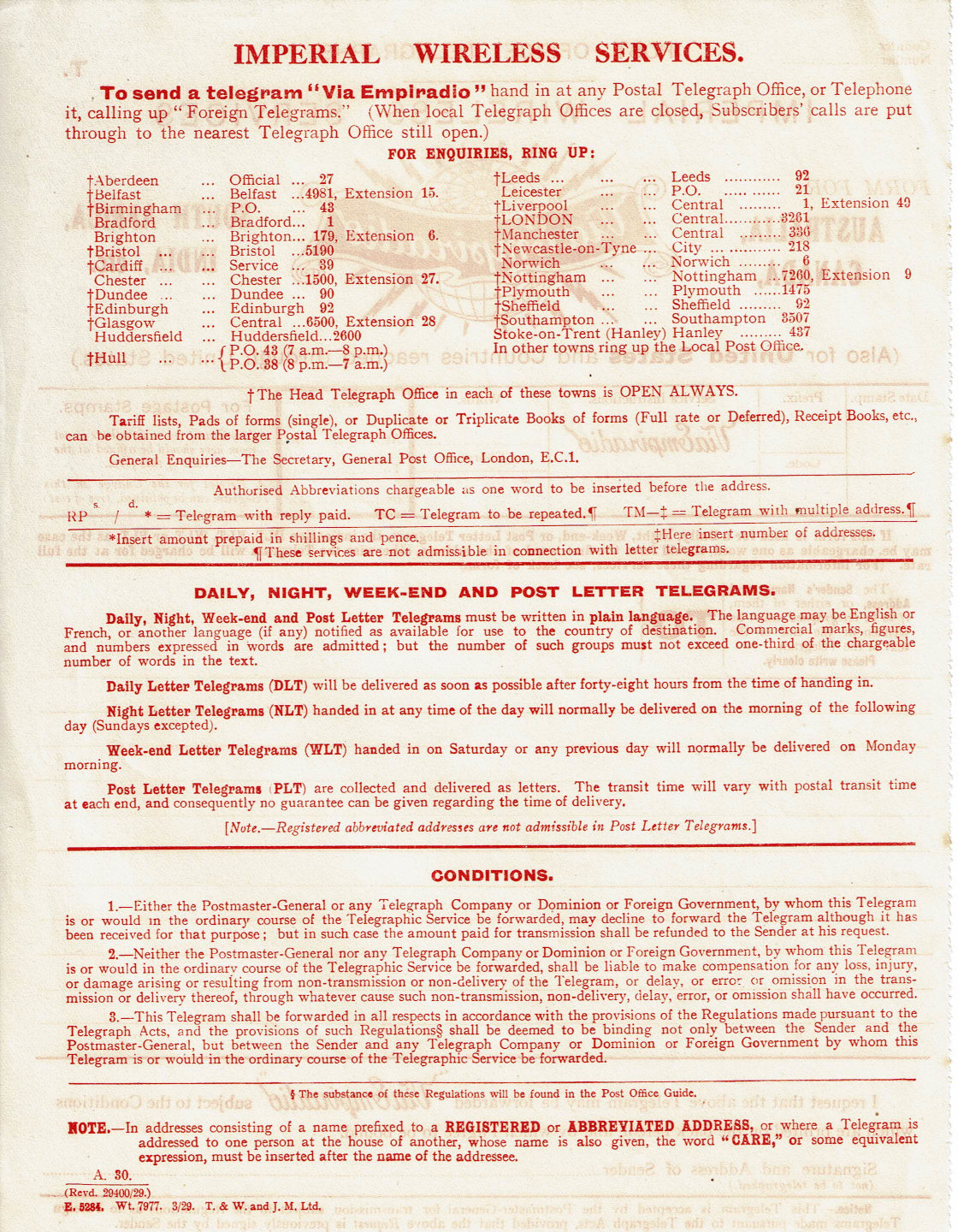
The imprint at bottom-left reads "E. 5284. Wt. 7977. 3/29. T. & W. and J. M. Ltd.", which I take to mean printed in March 1929.
Above that is "A30 / (Revd. 29400/29.)". Images courtesy of Edward Coombes.
I would take the form number below as being a large "C" as a PO form C (a delivery form), with "SM" for Submarine, over "IW" for Imperial Wireless.
The large "CA" below, I originally thought meant for use in Canada, but in fact it indicates from Canada. Used 5 December 1927.
Nothing on the back.
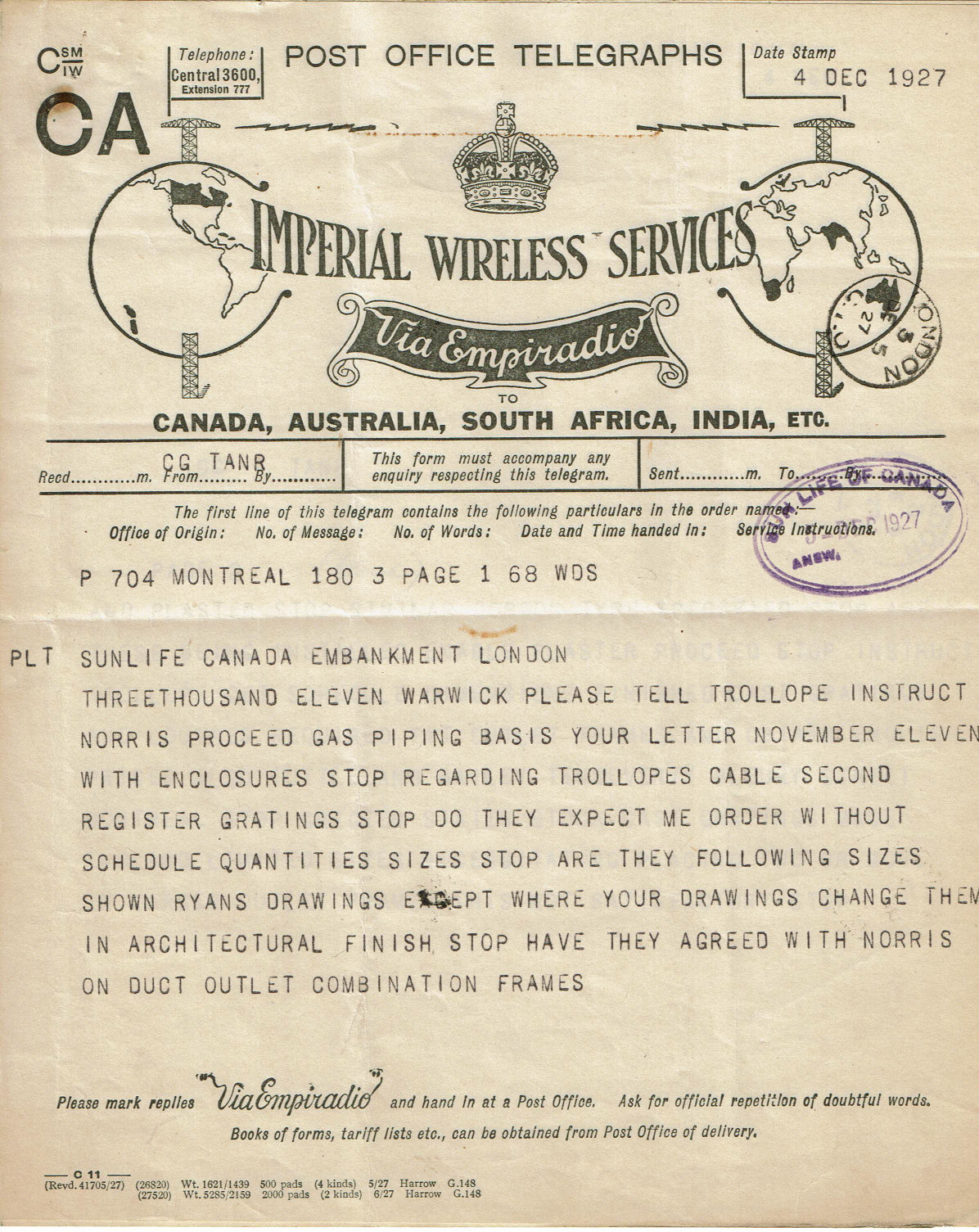
There is a "--- C 11 ---" at bottom-left. Below that, the imprint takes up 2 lines, reading more like a shopping list !:
"(Revd.41705/27) (26820) Wt. 1621/1439 500 pads (4 kinds) 5/27 Harrow G.148
(27520) Wt. 5285/2159 2000 pads (2 kinds) 6/27 Harrow G.148"
The "Revd" is the revision of the C11. "Wt" is "Warrant", authorizing the printing. Harrow is probably the HMSO printers there, printing in May or June 1927.
This indicates that the form can be from any of six possible items. The "4 kinds" may have been AU, CA, IN and SA. Image courtesy of Edward Coombes.
The large "SA" indicates from South Africa. Used 5 August 1928.
Nothing on the back.
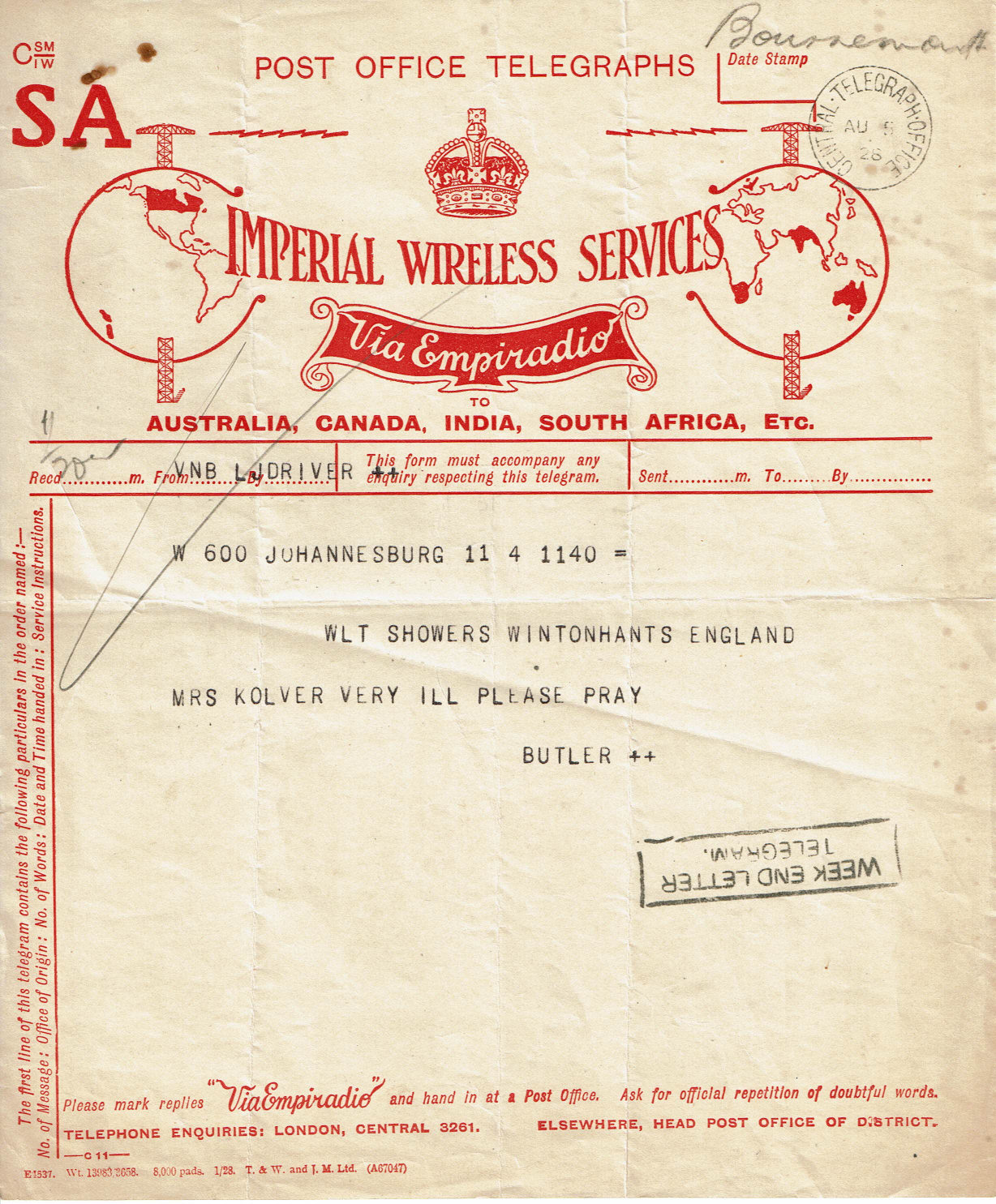
There is a "--- C 11 ---" at bottom-left, without a revision date.
Below that, the imprint reads "E1537. Wt. 13983/3658. 8,000 pads 1/28 T. & W. and J. M. Ltd. (A67047)"
implying printed in January 1928. Image courtesy of Edward Coombes.
The large "AU" indicates from Australia. Used 2 December 1928.
Nothing on the back. The Beam stations in Australia were at Rockbank and Ballan with callsigns of 'VIY' & 'VIZ', with 'VIZ' being on this telegram.
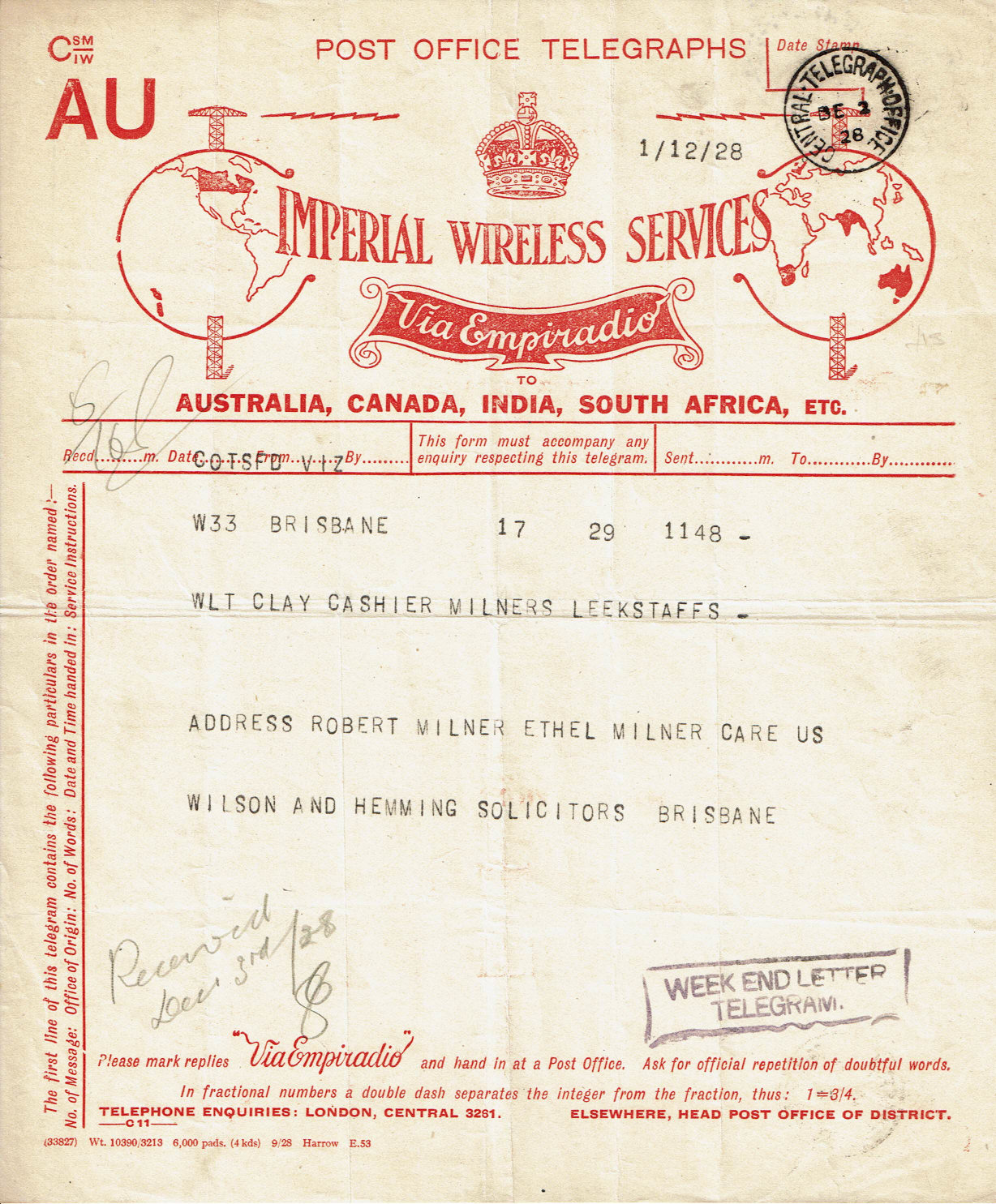
There is a "--- C 11 ---" at bottom-left, without a revision date.
Below that, the imprint reads "(33827). Wt. 10390/3213. 6,000 pads. (4 kds) 9/28 Harrow. E.53"
implying the 4 kinds printed in September 1928 at Harrow. Image courtesy of Edward Coombes.
The large "IN" indicates from India. Used 9 February 1929.
Nothing on the back. Khadi & Daund (?Dhond) were the Beam Stations in India with callsigns of VWY & VWZ. This form has VWZ.
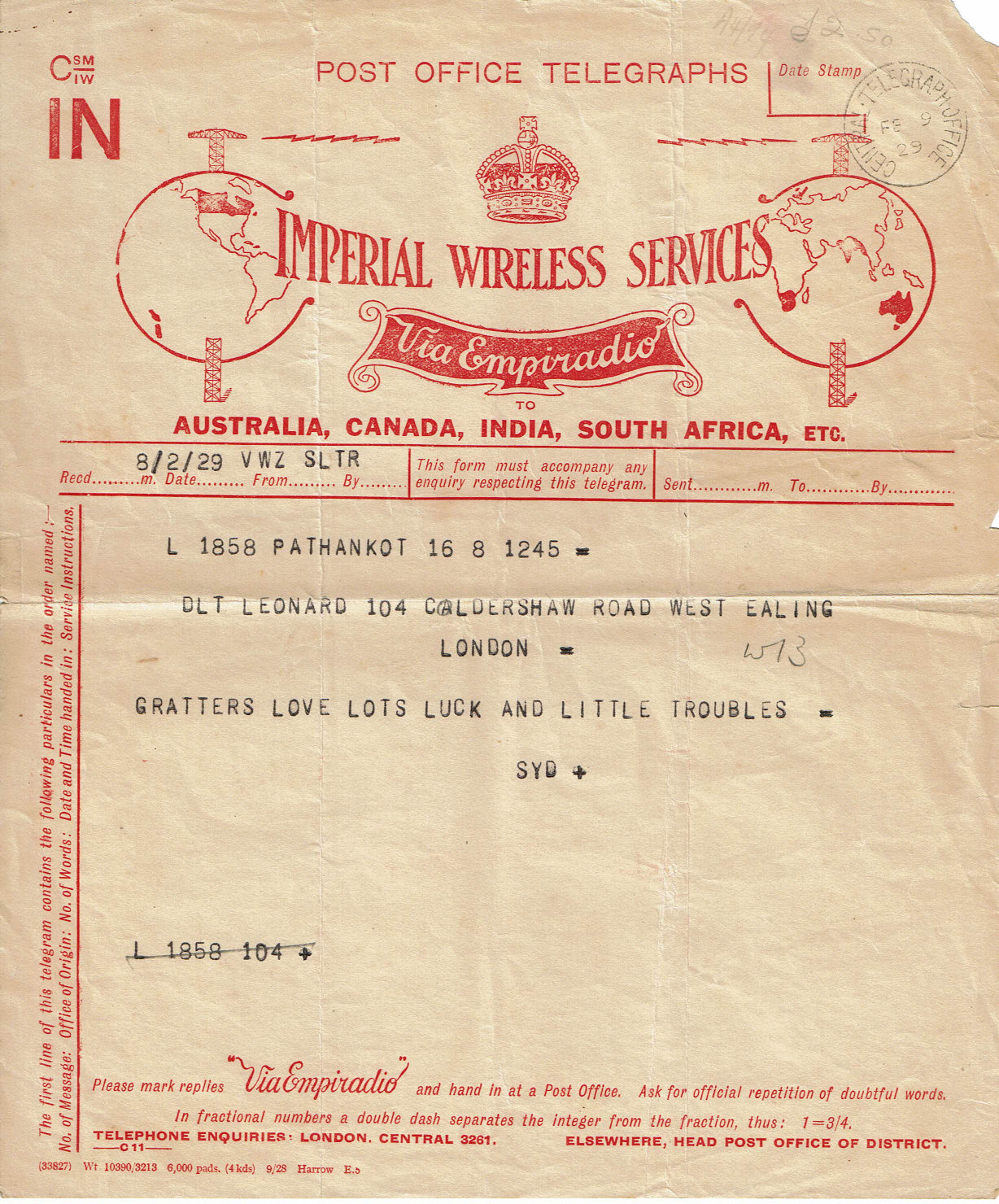
There is a "--- C 11 ---" at bottom-left, without a revision date.
Below that, the imprint which is the same as the last (though the last bit is broken), and reads "(33827). Wt. 10390/3213. 6,000 pads. (4 kds) 9/28 Harrow. E.53"
implying the 4 kinds printed in September 1928 at Harrow. This would be another of the 4 kinds. Image courtesy of Edward Coombes.
Edward Coombes tells me : The findings of the Imperial Wireless and Cable Conference in 1928 recommended that both the Cable and Wireless services of a number of Companies
(Marconi, the Eastern, the Western, & the Eastern Extension {Australia & China} etc) should be merged to form the operating company 'Imperial & International Communications Limited'.
By 1929 the Cable and Wireless parts of the Imperial networks merged and Cable and Wireless Ltd. was formed.
This has a time-code wheel at top-left as used by the Eastern Telegraph, and a form number at top-right that looks like it could be "Message Form 5/17A-99" (see next)
No image of the back, but it probably has conditions, more information and the location of Telegraph Offices.
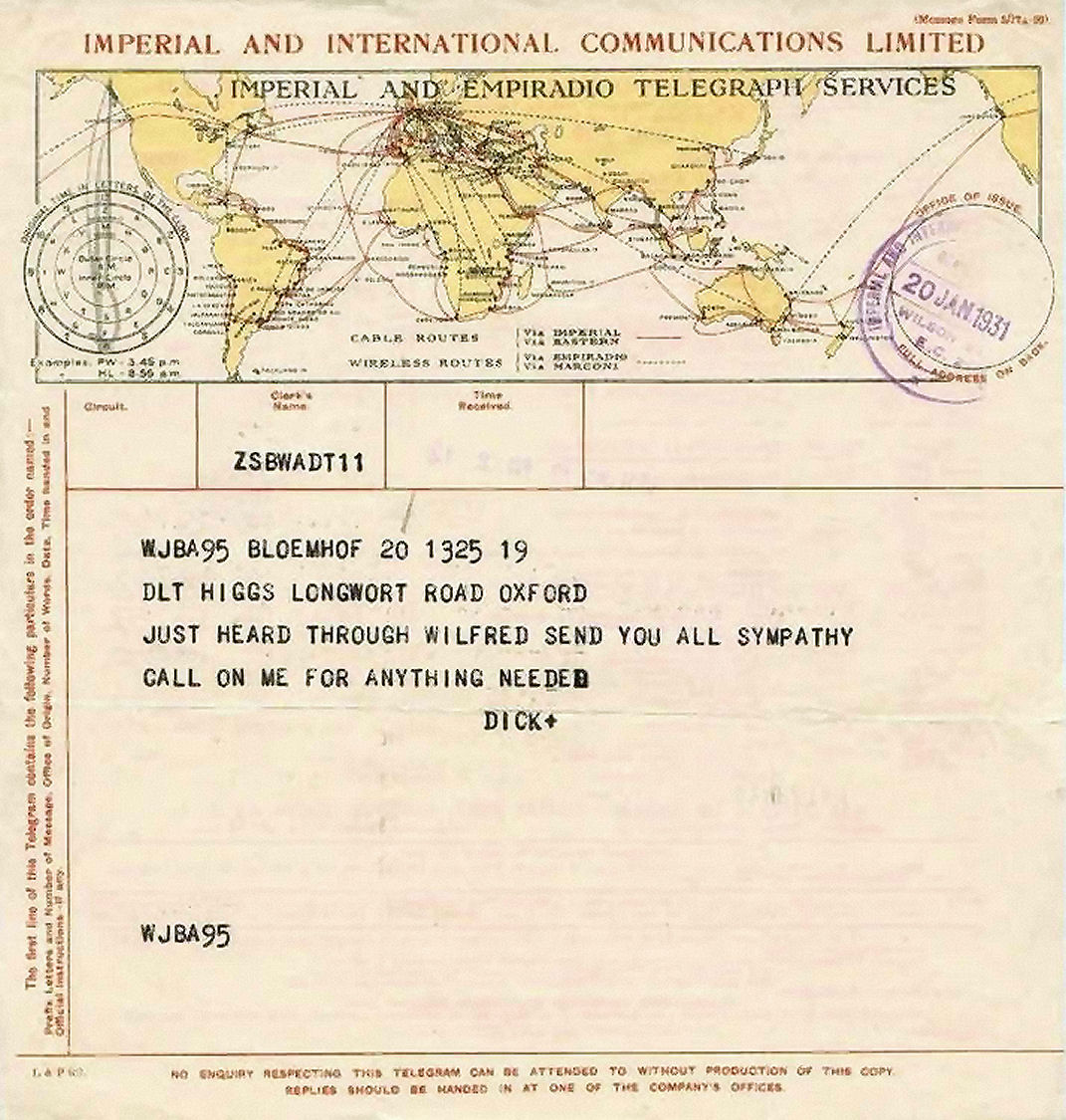
This is very similar to a 1927 telegram of the Eastern Telegraph. Image courtesy of Bill Glover at Atlantic-Cable.com
A similar form dated 16 December 1932 received at London from Paris.
The time-code wheel has gone, and a form number at top-right is clearly "Message Form 5/17A-99". The map looks the same, Madagascar still connected to the mainland.
No image of the back, but it probably has conditions, more information and the location of Telegraph Offices.
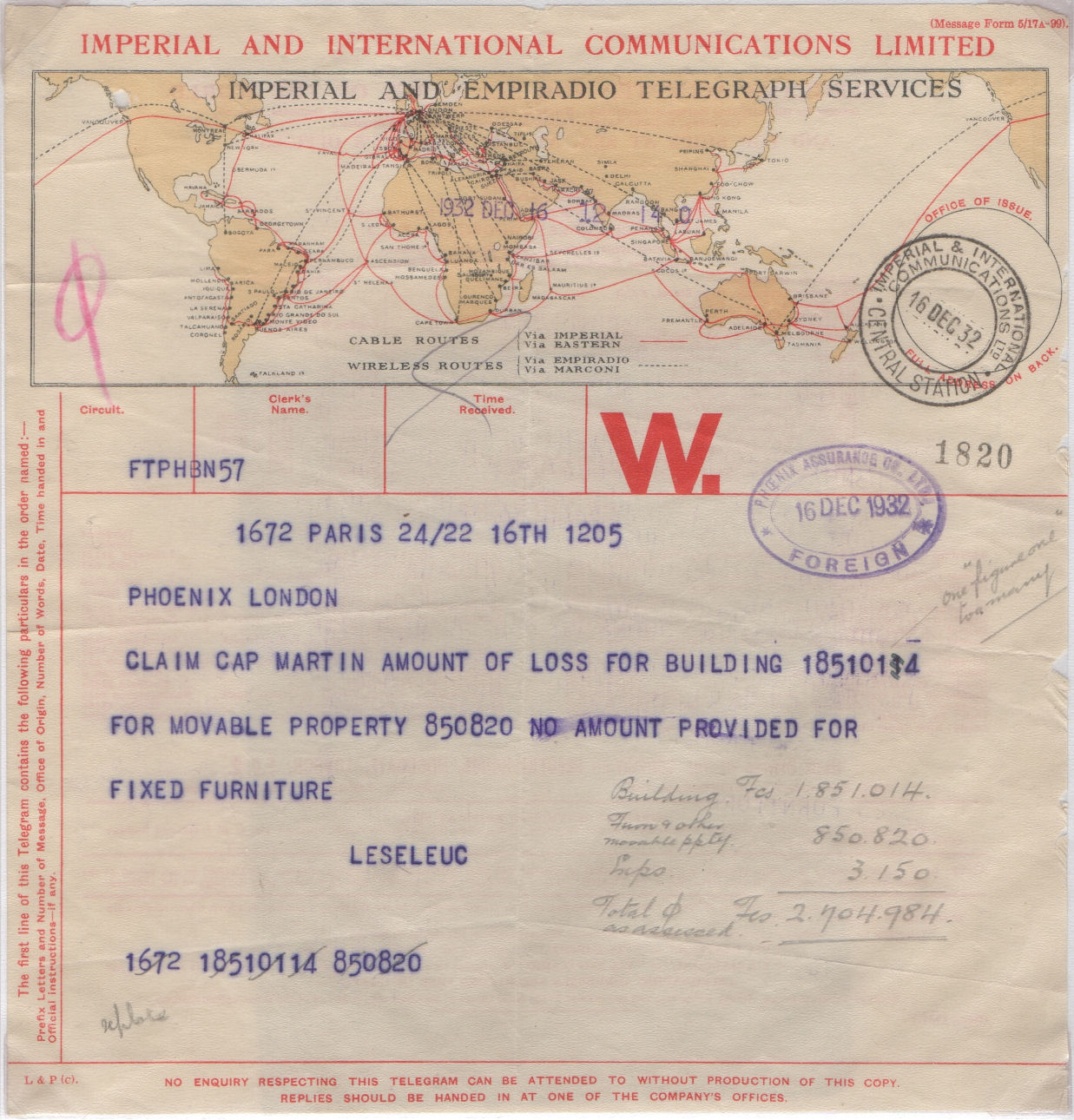
"L & P (c)." at bottom-left. Could the large red "W" stand for "Wireless" ? Courtesy of Les Bottomley.
A similar form dated 11 April 1933 received at Pinfold, Birmingham from Durban.
The form number at top-right is now "Message Form 5/17A-161".
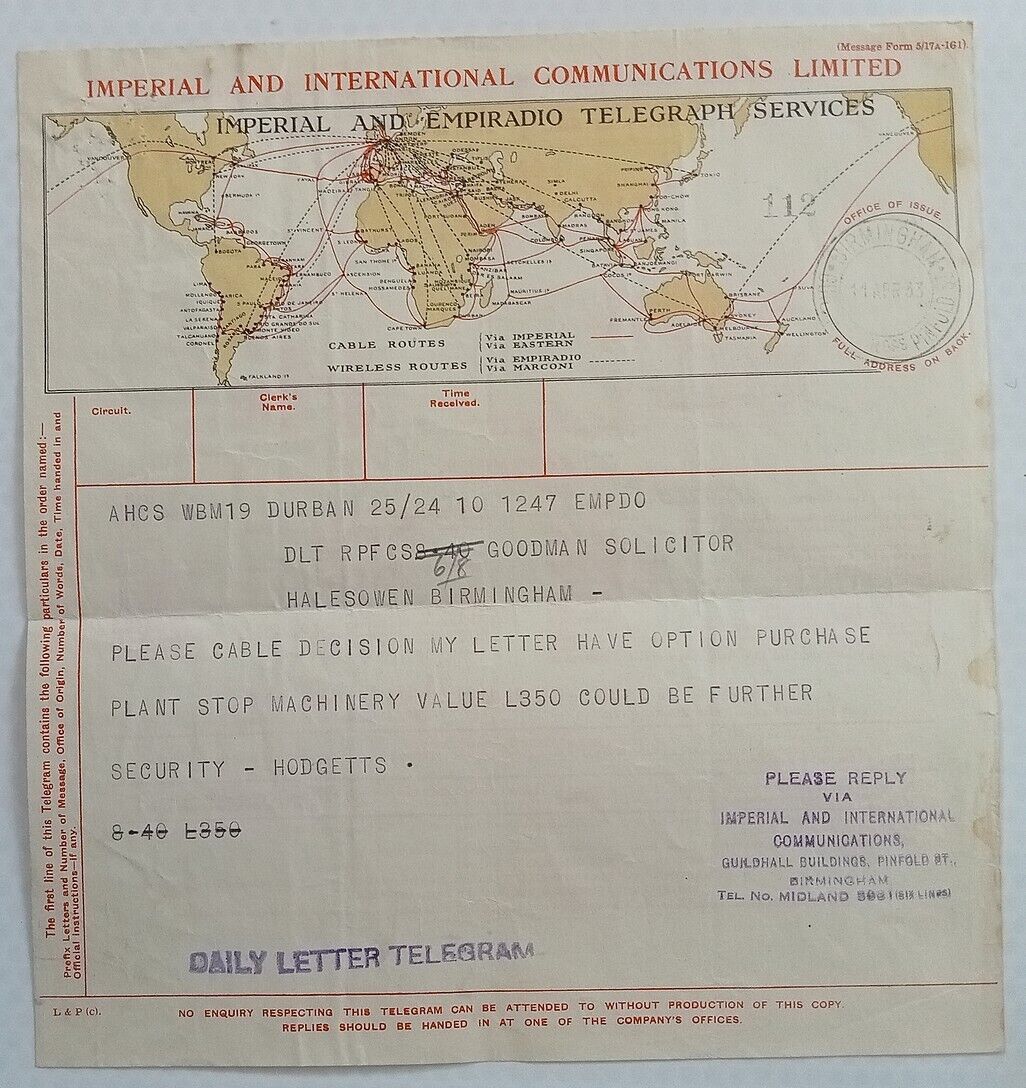
"L & P (c)." at bottom-left. Marked "Daily Letter Telegram ".
Image courtesy of AlphaOmegaPhilately on eBay. (Click on image for listing)
A "Letter Telegram" envelope used 10 February 1931 with no apparent form number. It was delivered by registered mail.
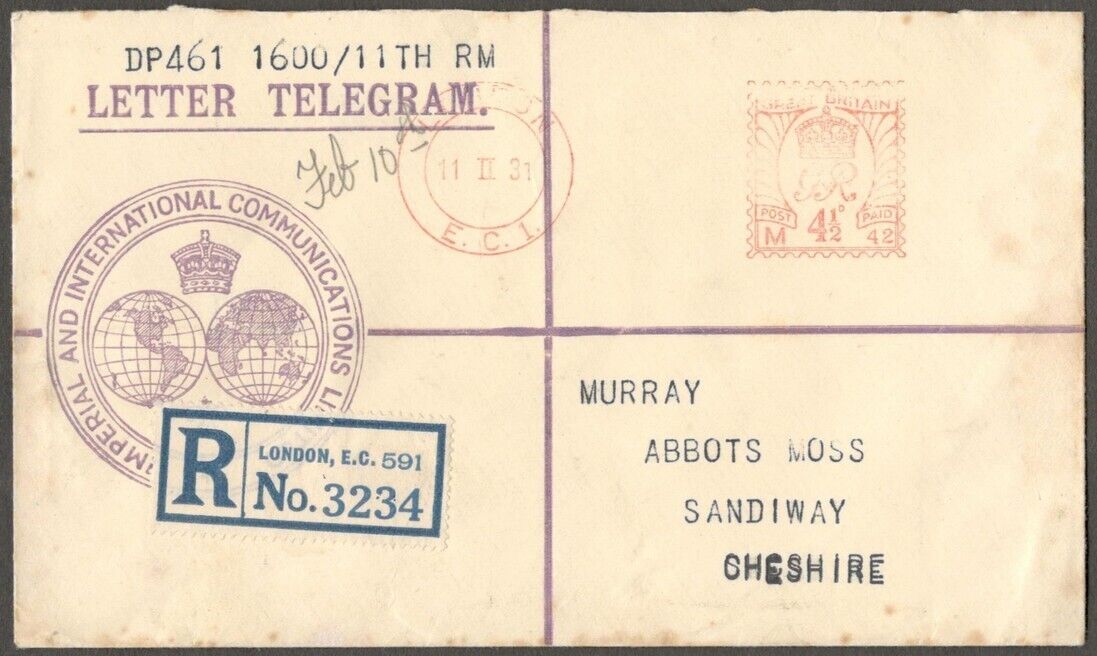
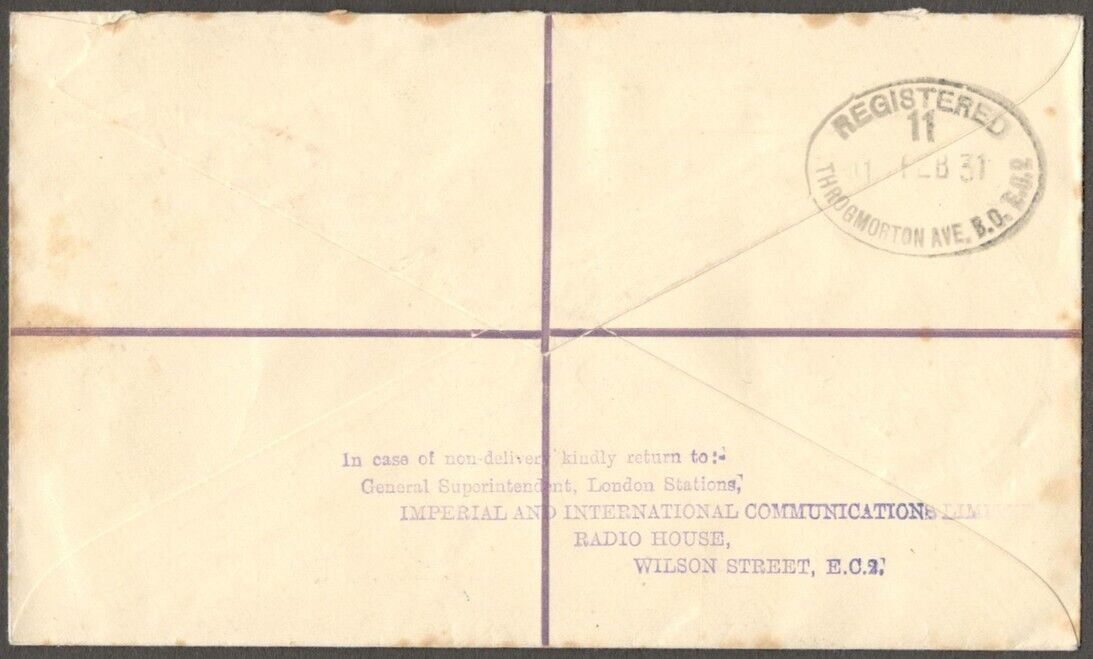
The back gives an address of Radio House, Wilson Street, London E.C.2.
Images courtesy of AlphaOmegaPhilately on eBay. (Click on image for listing)
The History of Cable & Wireless
Post Office Telegraphs Via Imperial with a map of the world. The form is dated June 1934 at top-left, and it was used 15 January 1935. Message Form 5/—158
Madagascar now connected to Mauritius. Size 210 x 218mm.
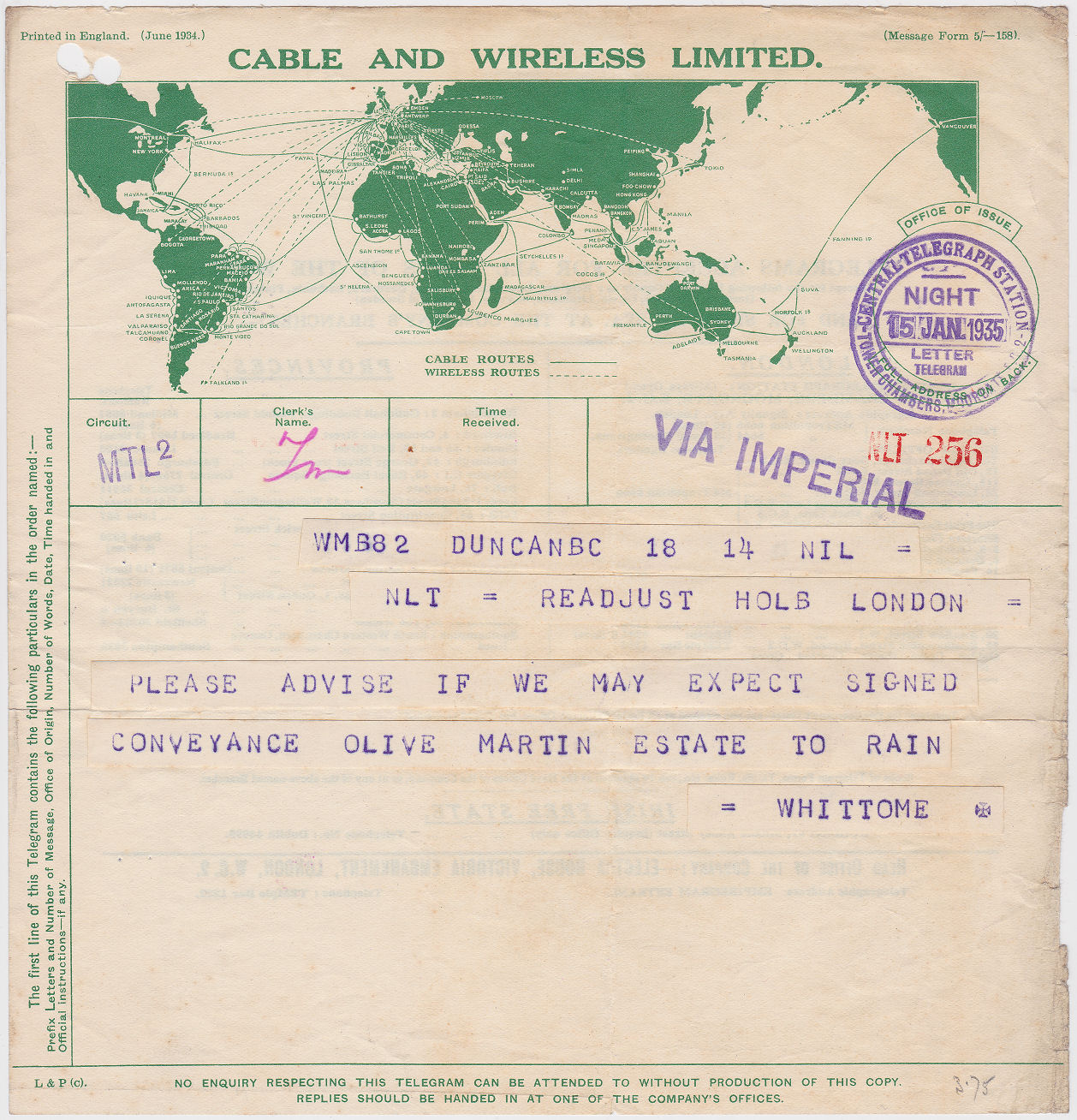
The back has information about the location of Telegraph Offices.
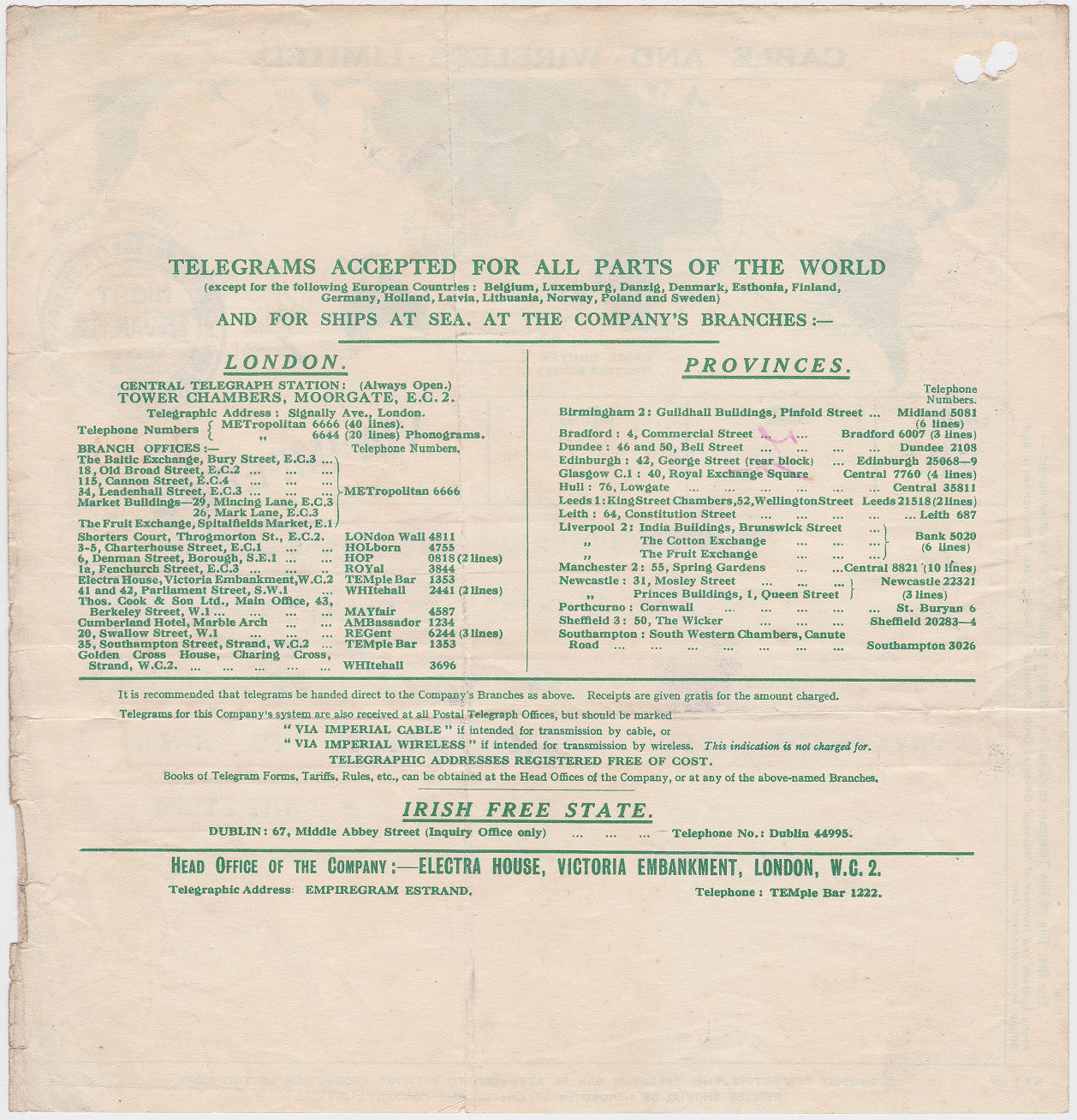
Interestingly their Head Office telephone number is given differently at the bottom to what it has in the list above. Also Porthcurno has a St. Buryan number.
A similar form dated September 1935 at top-left, and used 1 February 1936. Message Form 5/—158
The only difference I can see is the date of printing.
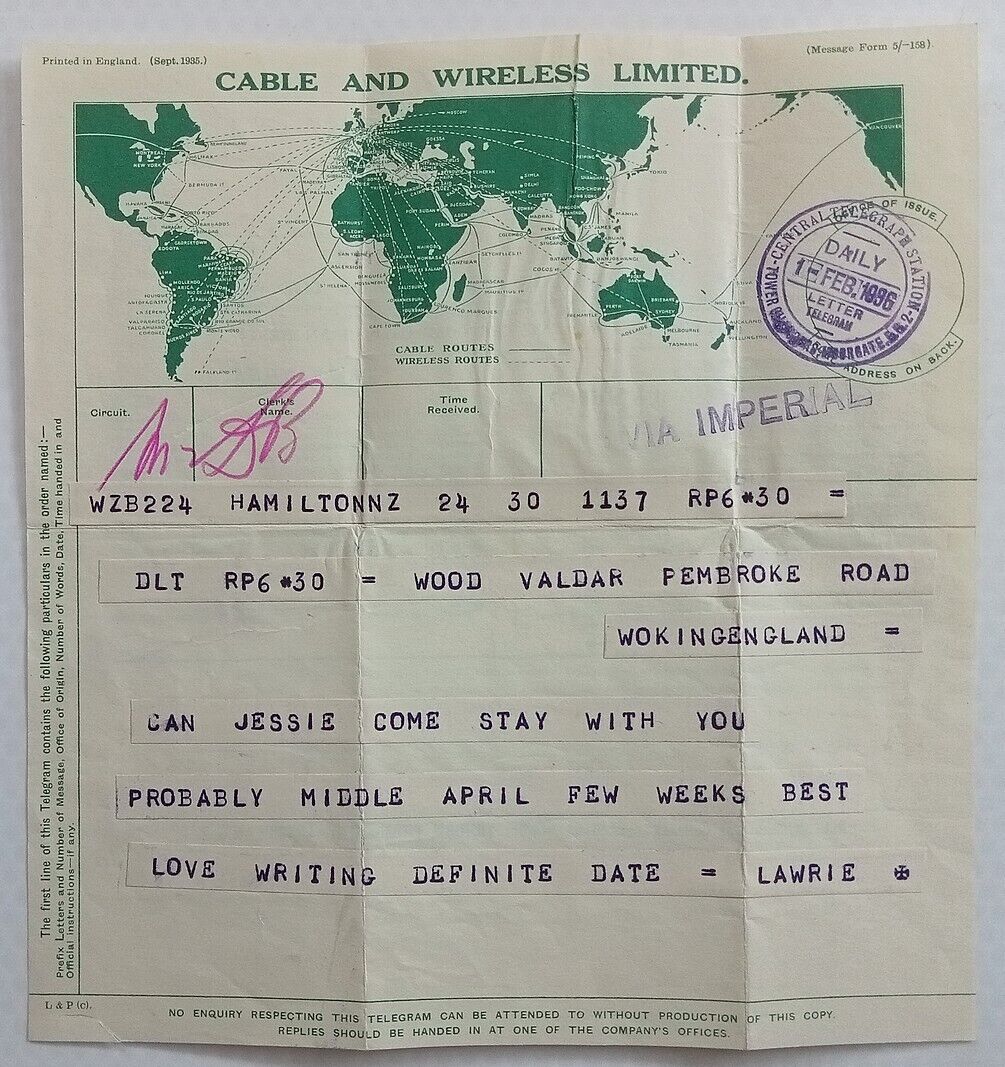
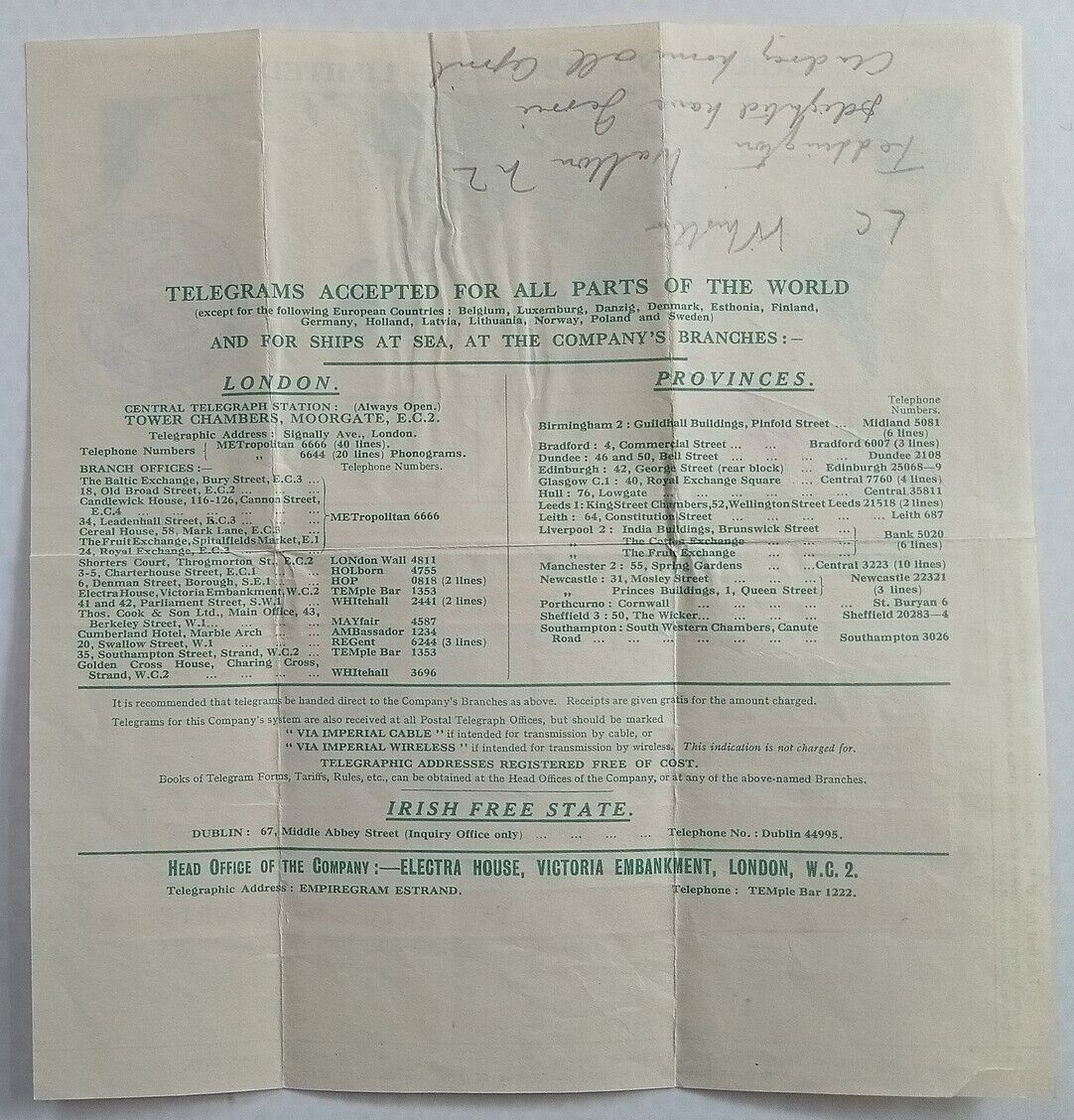
Images courtesy of AlphaOmegaPhilately on eBay (click image for listing).
A similar form dated September 1938 at top-left, and used 15 December 1939. Message Form changed to 5/—159 (/) —159A
The map has changed in the area of Newfoundland. The box below the datestamp is labelled "A.", I think the "NLT" in the code therein stands for "Night Letter Telegram".
This appears to be from the Viceroys Camp in Calcutta, to London. It has a "PASSED BY CENSOR" mark.

Hold on until 29th December - nice! Courtesy of Les Bottomley.
Cable and Wireless Via Imperial wartime telegram. The form is dated September 1942 and it was used 15 August 1943.
It is stamped "OVERSEA" and the origin is coded as ISA1069. It has a "Passed by Censor" mark. Size 185 x 209mm.
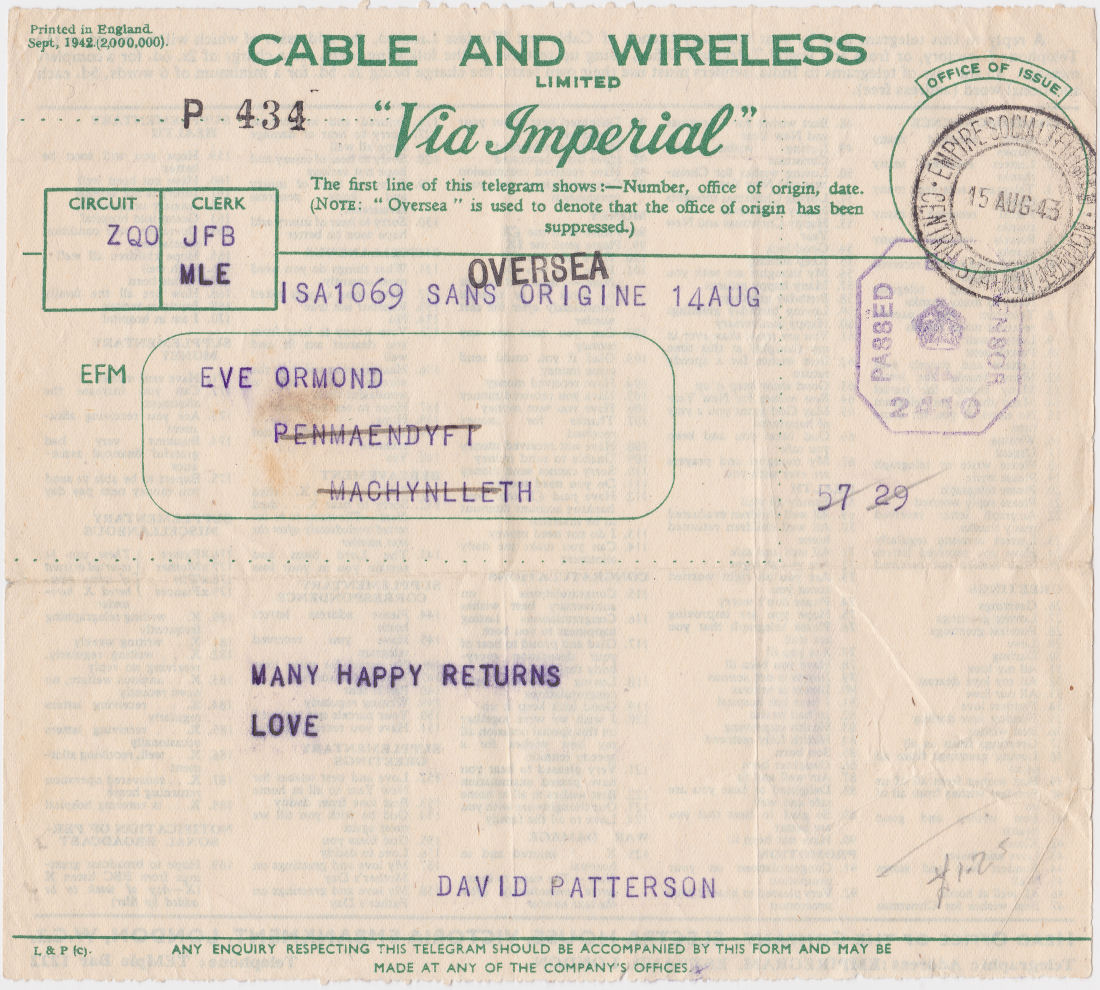
L & P (c) at bottom-left.
The back has a list of 189 codes to reduce the word-count on messages.
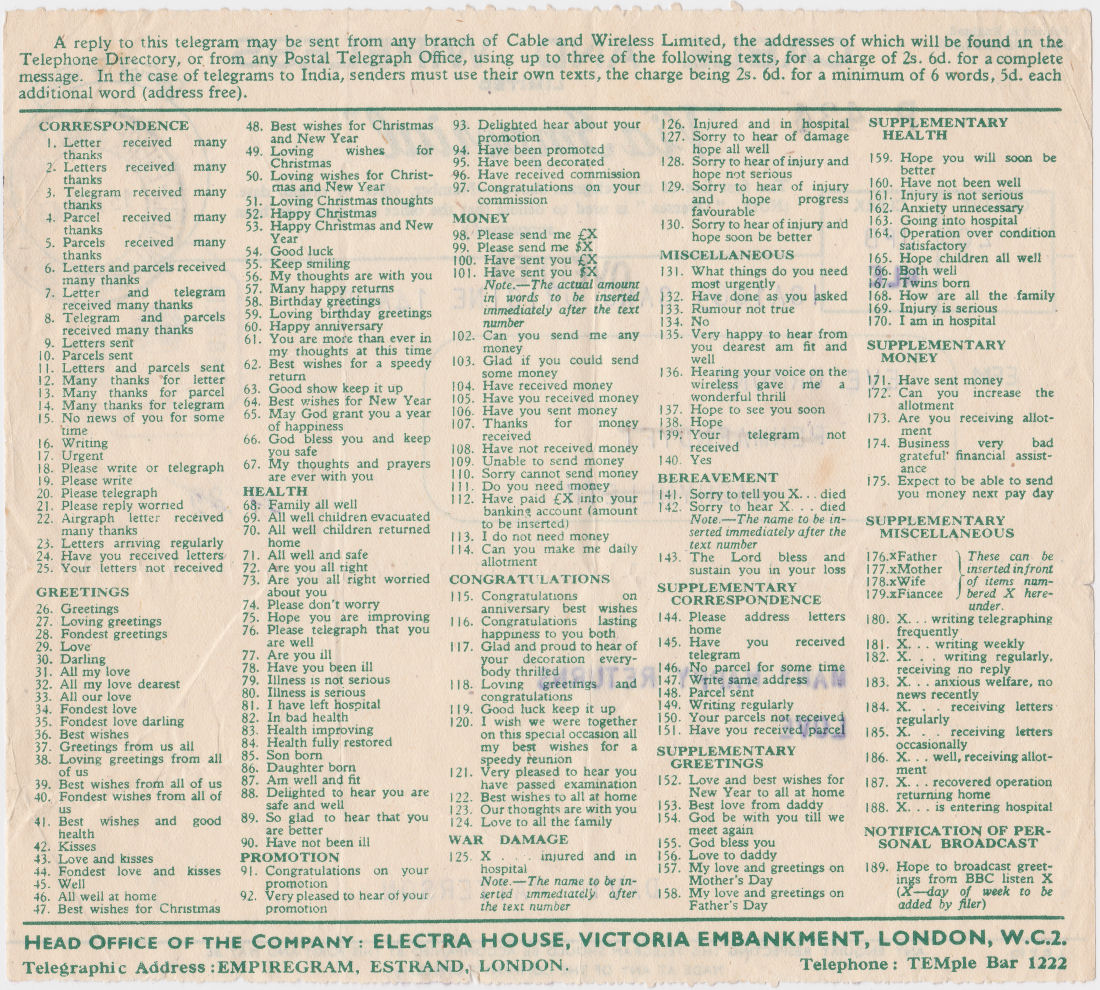
Cable and Wireless Limited wartime telegram. The form was used 5 January 1944.
It has a "Passed by Censor" mark. Smaller size of 132 x 154mm.
Notice the part of a red "BRITAIN" cancel above the "EFM" box, and the feint horizontal dots below the box.
It looks like the form was intended to be folded in half and put in an envelope with a section cut out to show the address.
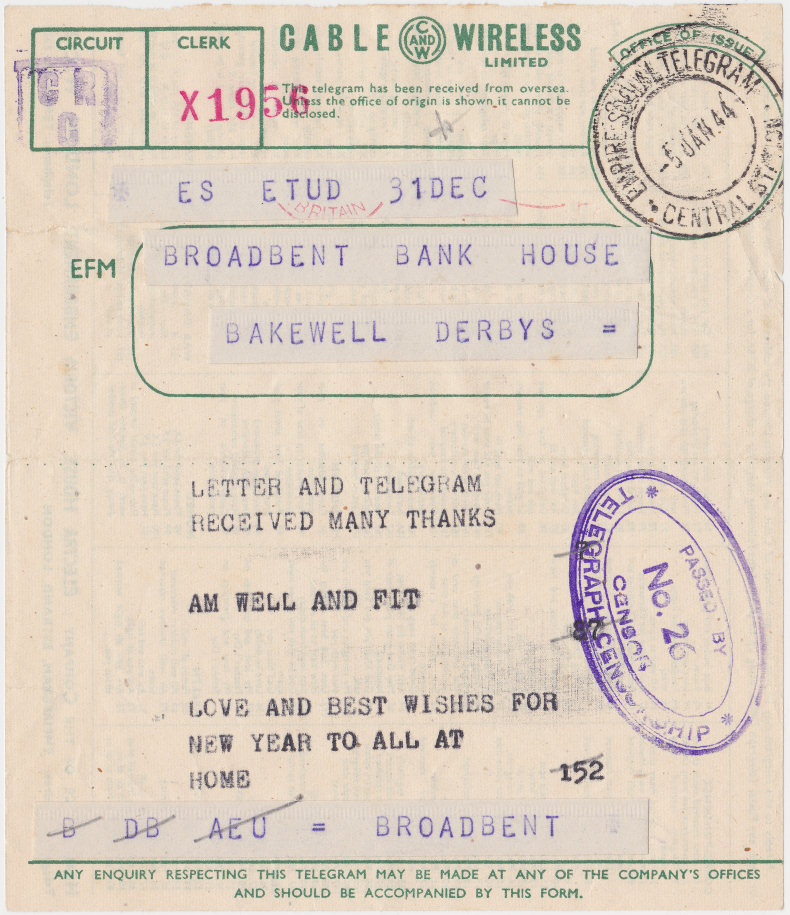
No mention of L & P or where printed.
The back (sideways) has a re-arranged list of the same 189 codes to reduce the word-count on messages.
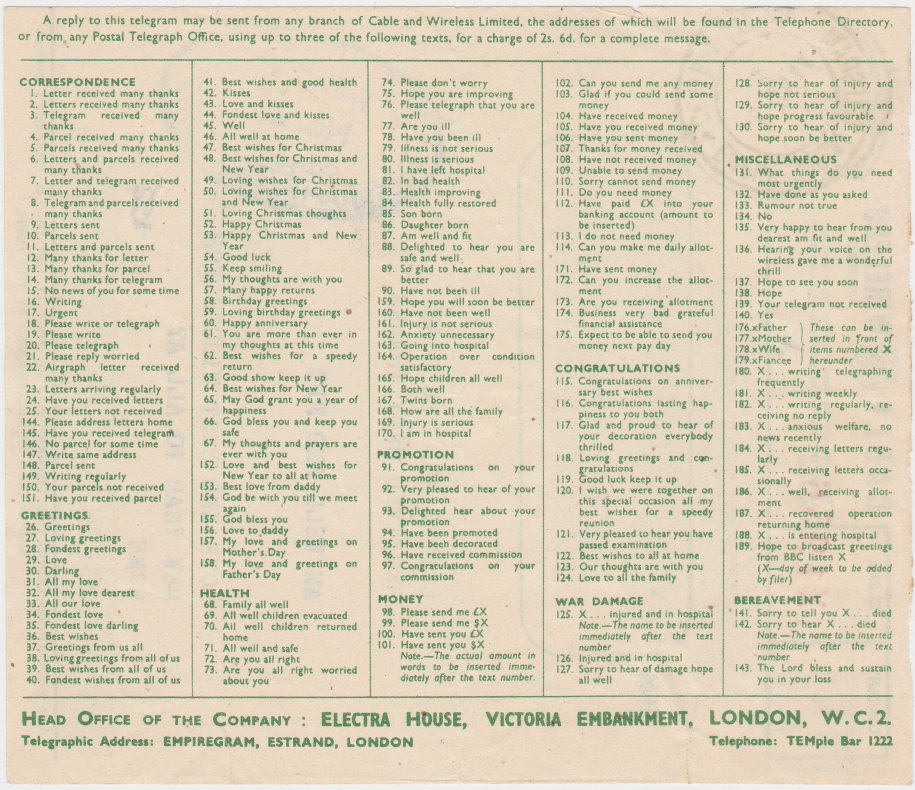
Additionally forms printed in red, were produced for use in other countries such as Hong Kong, Malta or Australia.
Here is a delivery envelope used in Liverpool on 6 May 1940
The imprint gives the printing date as July 1938.
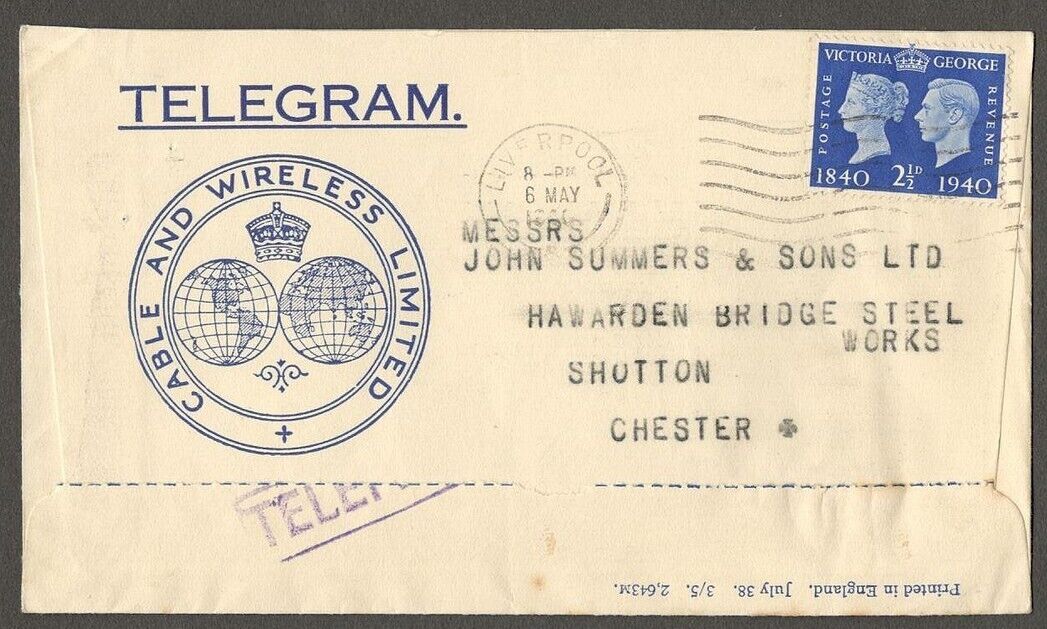
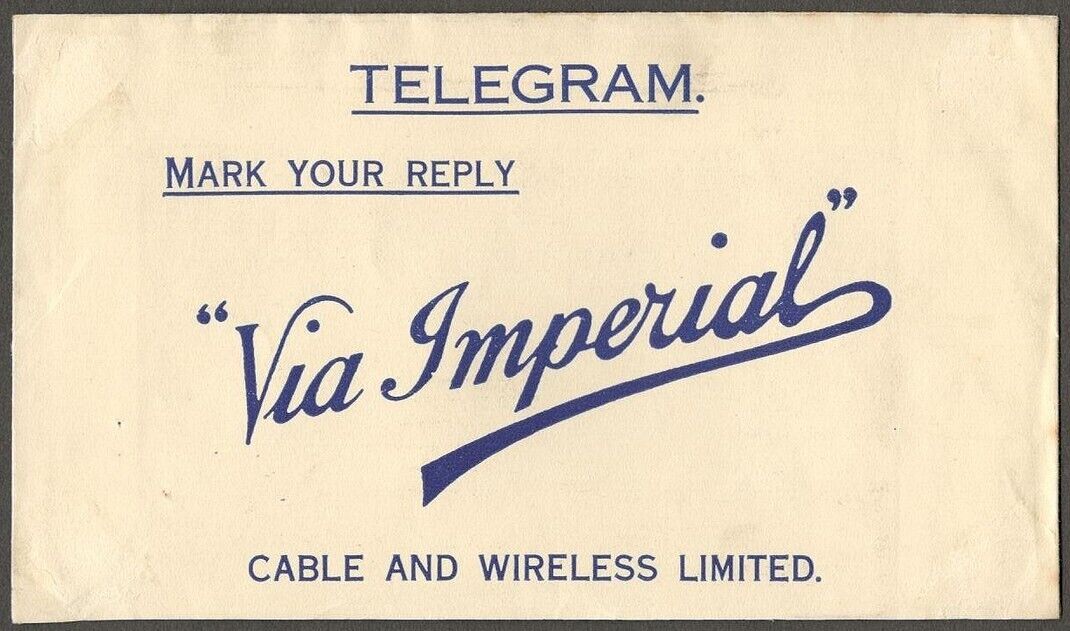
July 1938 imprint

Images courtesy of AlphaOmegaPhilately on eBay. (Click on image for listing)
Here is a delivery envelope used in Newcastle on Tyne on 7 February 1941
The imprint gives the printing date as September 1939.
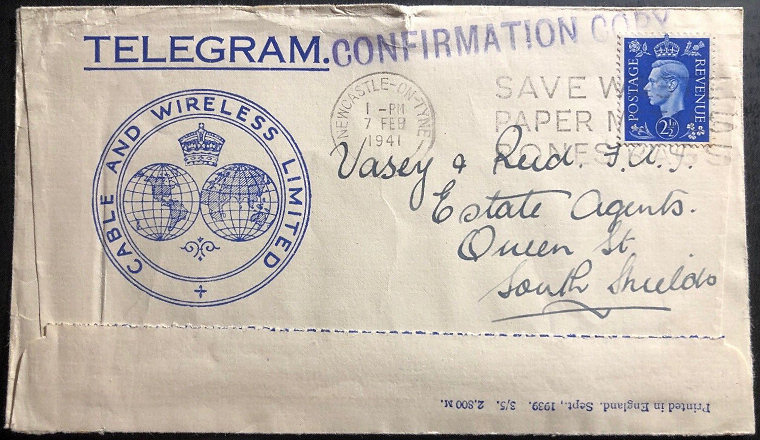
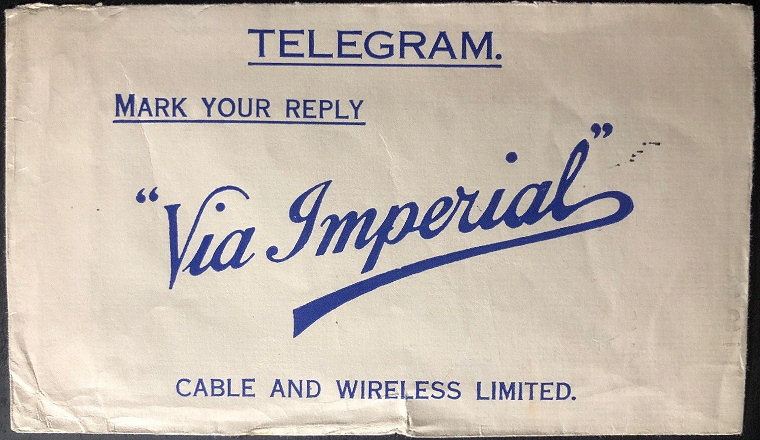
September 1939 imprint

Photos courtesy of Aztec Collectables, click on one for the listing.
Here is an undated delivery envelope printed on gold. No imprints, and reduced wording. Also no stamp so hand-delivered to London S.W.1.
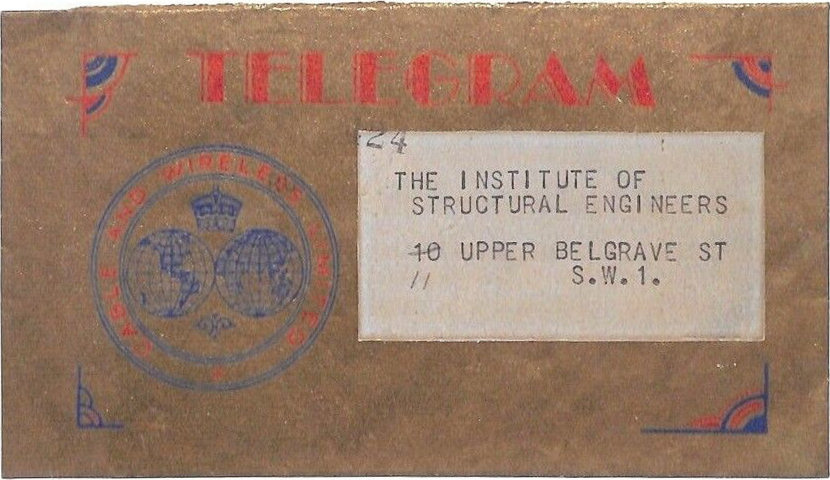
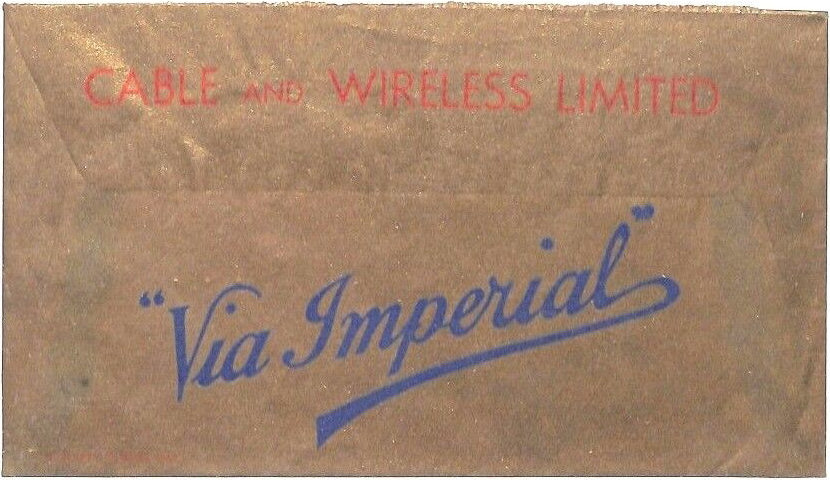
Images courtesy of Samwells Ltd., click on one for the listing.
Here is an "Overseas Telegram" delivery envelope with a GPO Logo. No imprints, but "No. 11." at top-right.
No stamp so presumably free postage. CDS of 2 February 1963 at Croydon, Surrey.
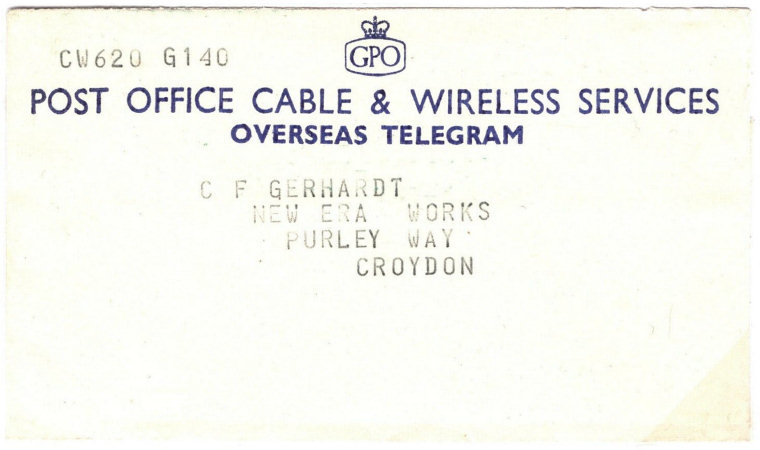
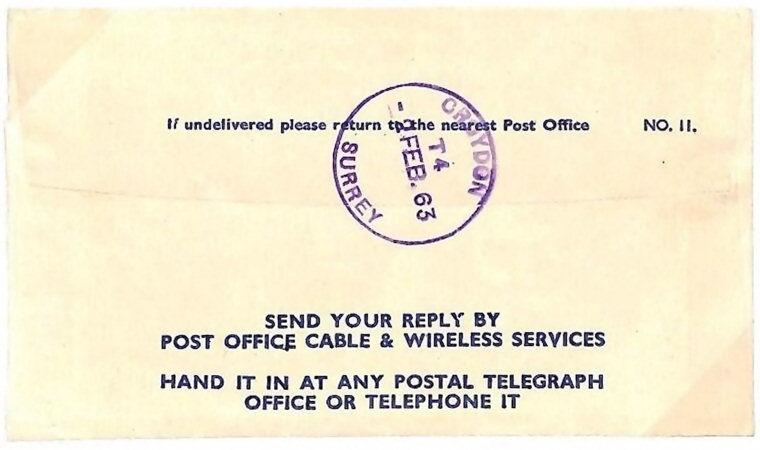
Images courtesy of Samwells Ltd., click on one for the listing.
This is undated, unused form, giving connections and conditions on the front.
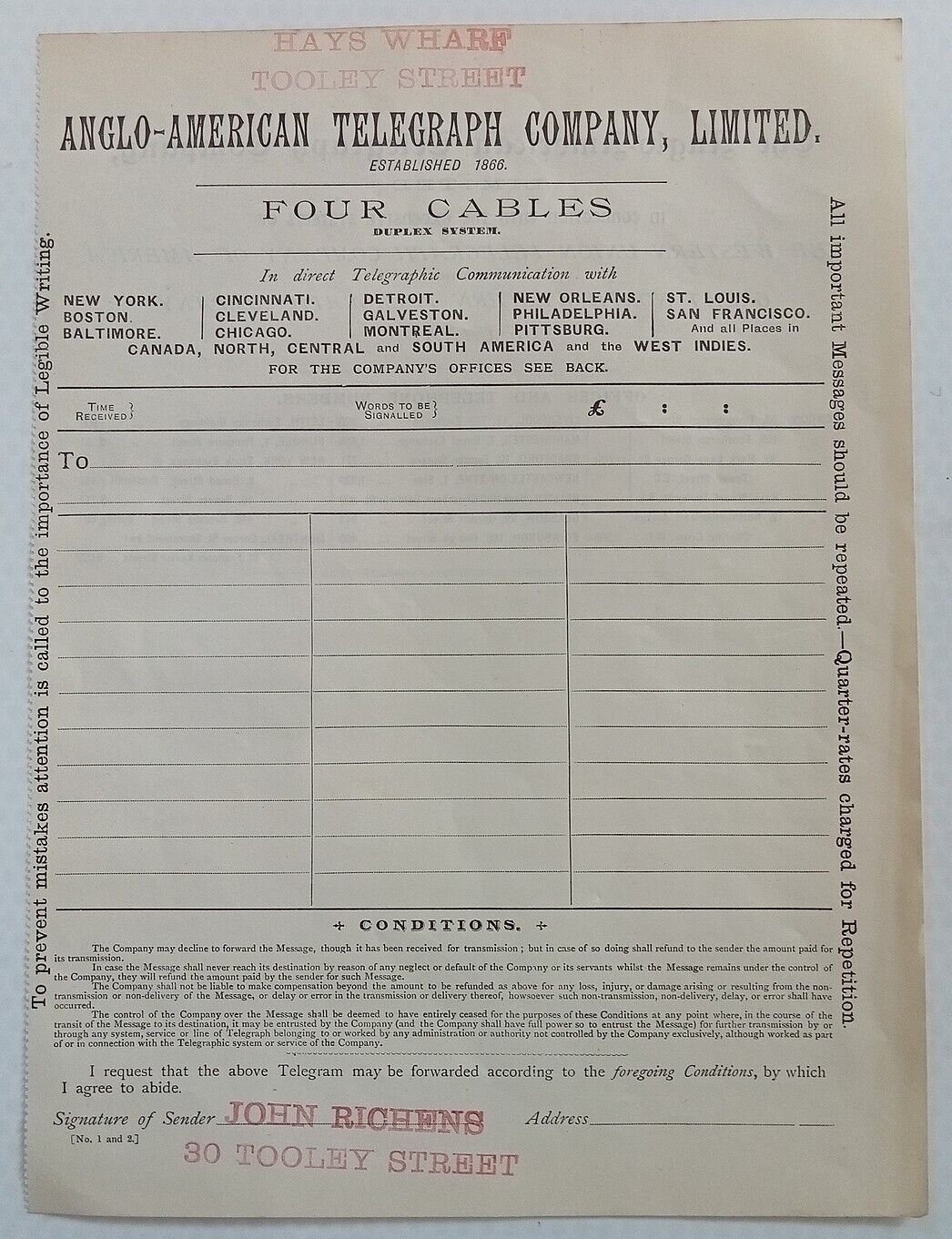
The form appears to have been distributed by John Richens of Hays Wharf, 30 Tooley Street (London, S.E.)
The back lists 5 offices in London, including Hays Wharf; plus 9 other British cities, 4 in New York and 1 in Montreal.
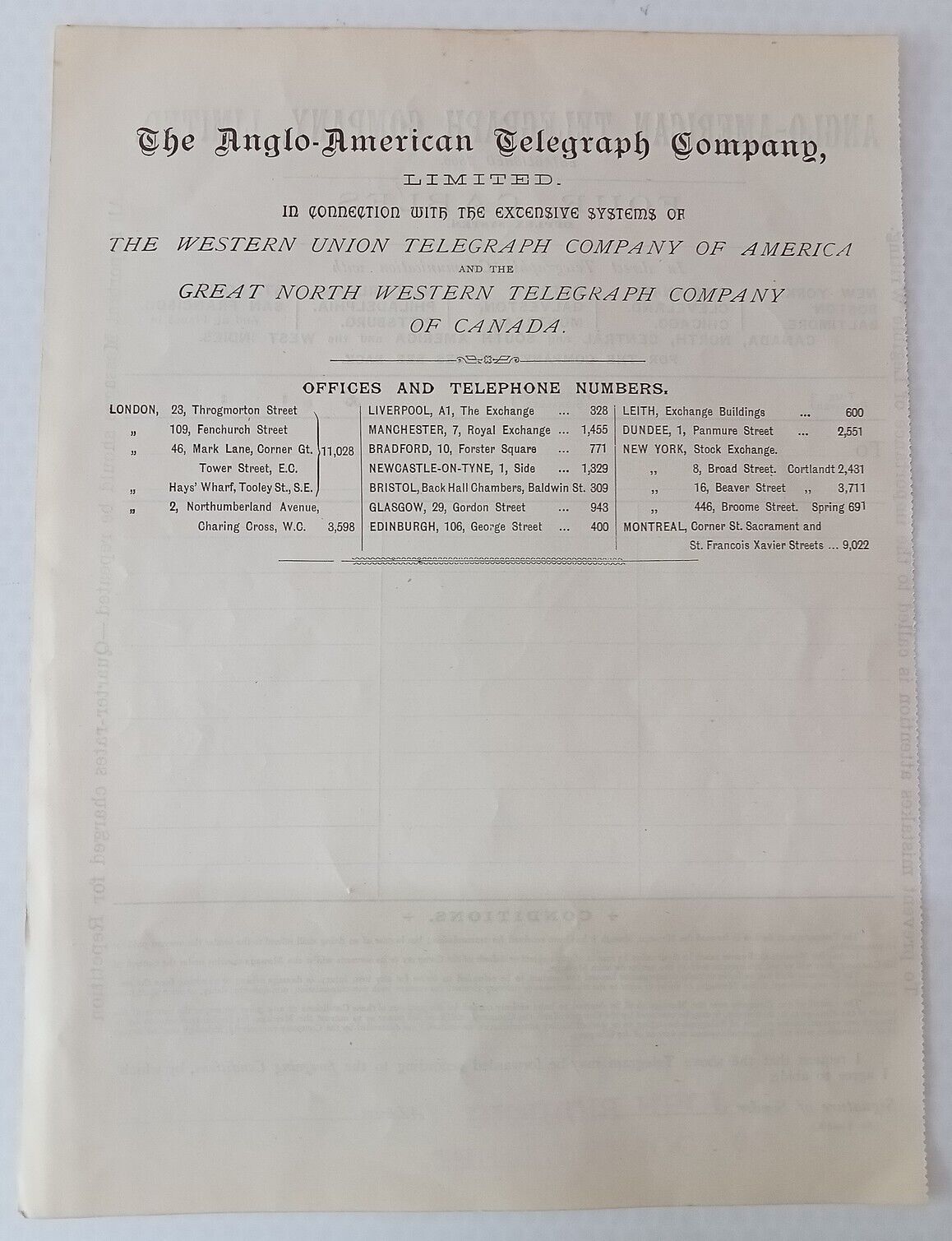
Images courtesy of AlphaOmegaPhilately on eBay. (Click on image for listing)
A Spanish Company that came under the control of the Eastern Telegraph Co. in 1885.
Another Form 2A. - This is dated 4 January 1933 and it was used in Frederick Street, London for a telegram from Buenos Aires.
This lists the London Station as now at Electra House, Moorgate, E.C.2 and others are listed on the back. - Size 214 x 214mm.
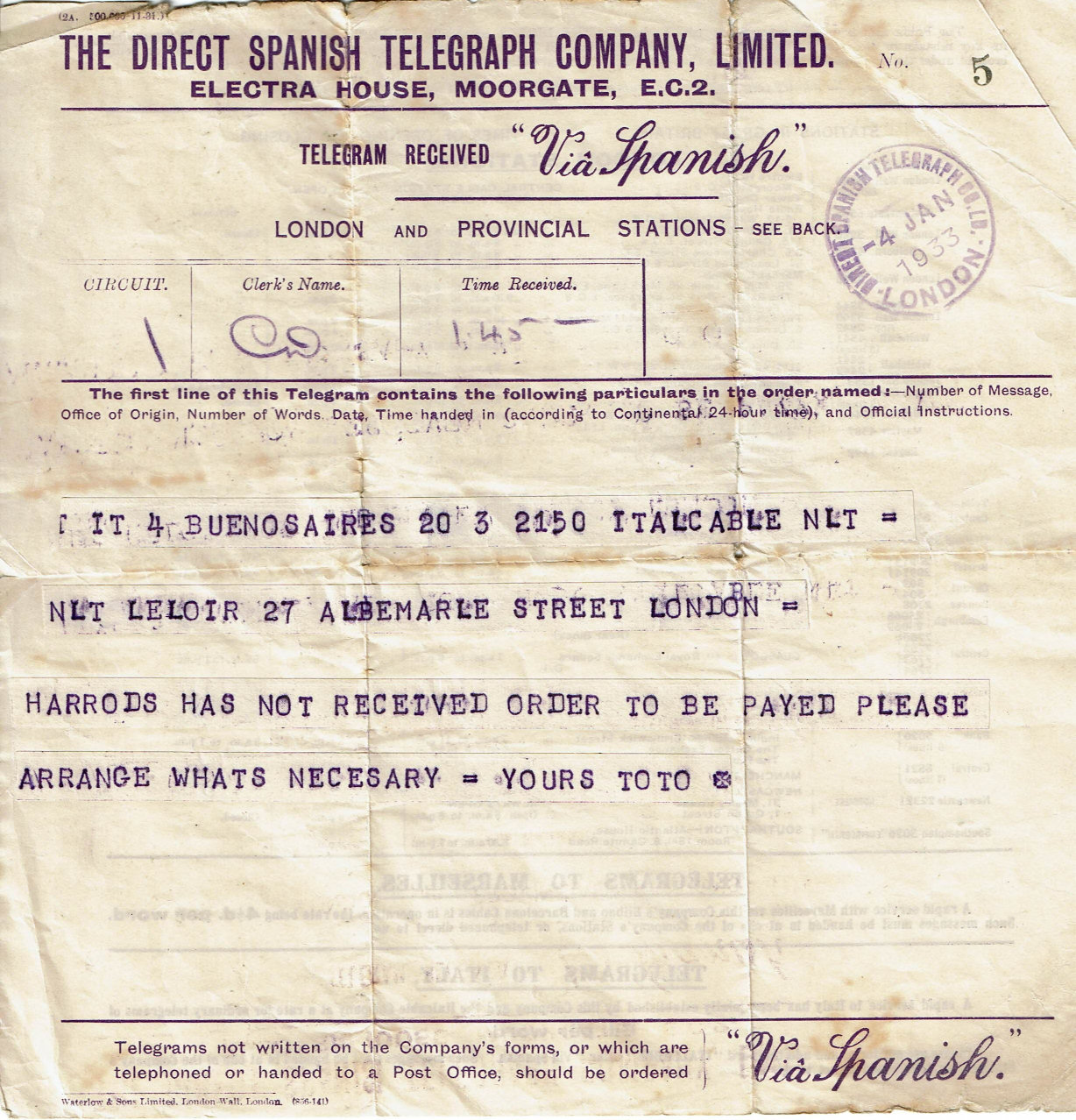

Again printed by Waterlow & Sons Ltd.
On the back it now lists numerous London Stations as well as 14 other cities.
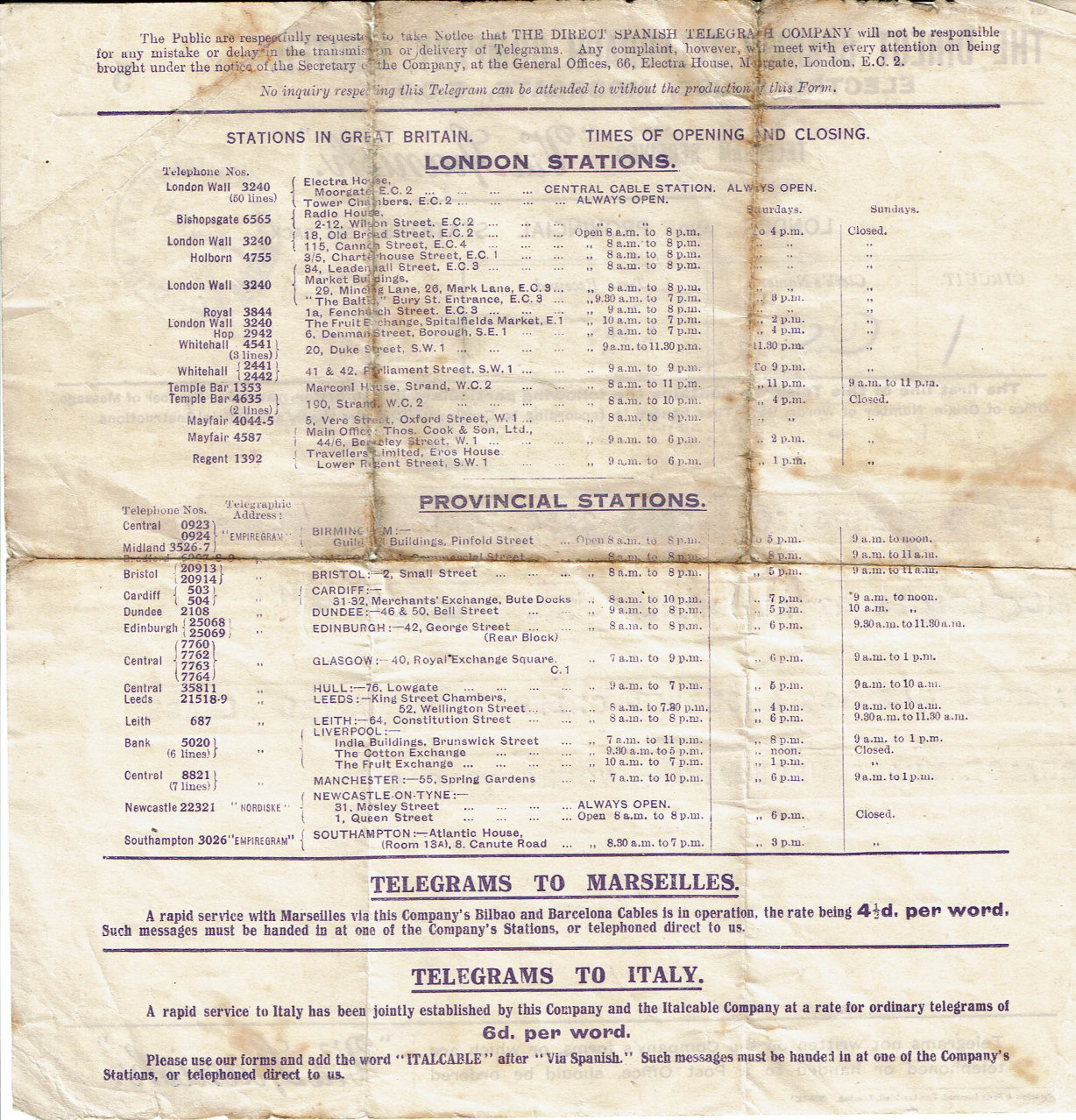
It also quotes prices for telegrams to Marseilles and Italy. - Image courtesy of Edward Coombes.
A Danish Company that had plans to use Telegraph Stamps in China, Japan, Vladivostock and places between.
This is dated 12 July 1880 and it was used in Newcastle for a telegram from Gothenburg, Sweden.
A cable was laid between Newbiggin by the Sea, about 17 miles (27km) from Newcastle, and Marstrand, Sweden.
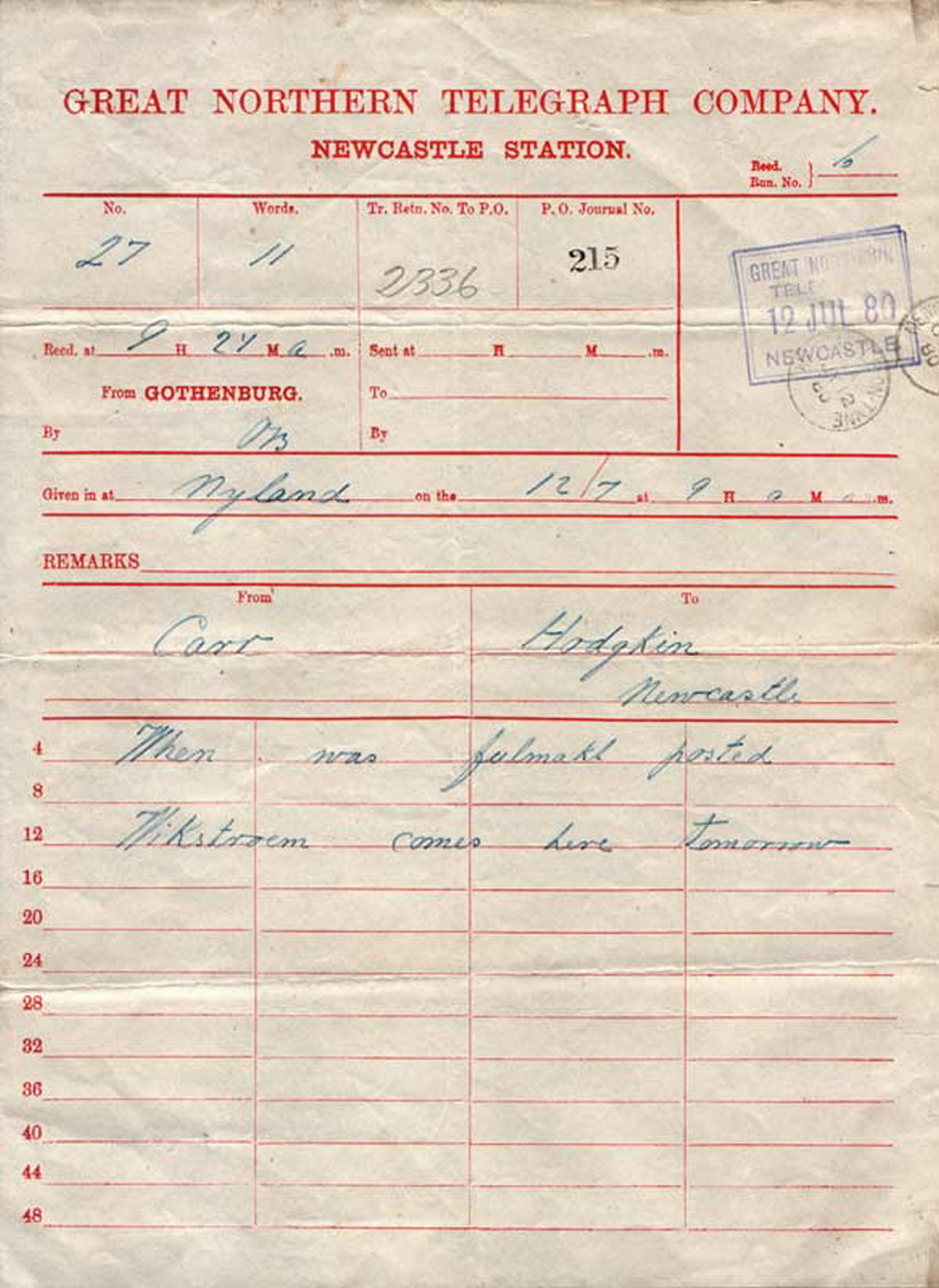
This has lines and word numbering up to 48 at the bottom. - Image courtesy of Bill Glover.
This is dated 19 November 1880 and it was also used in Newcastle for a telegram from Gothenburg, Sweden.
This is very similar to the last, except at the bottom. Size 200 x 284mm.
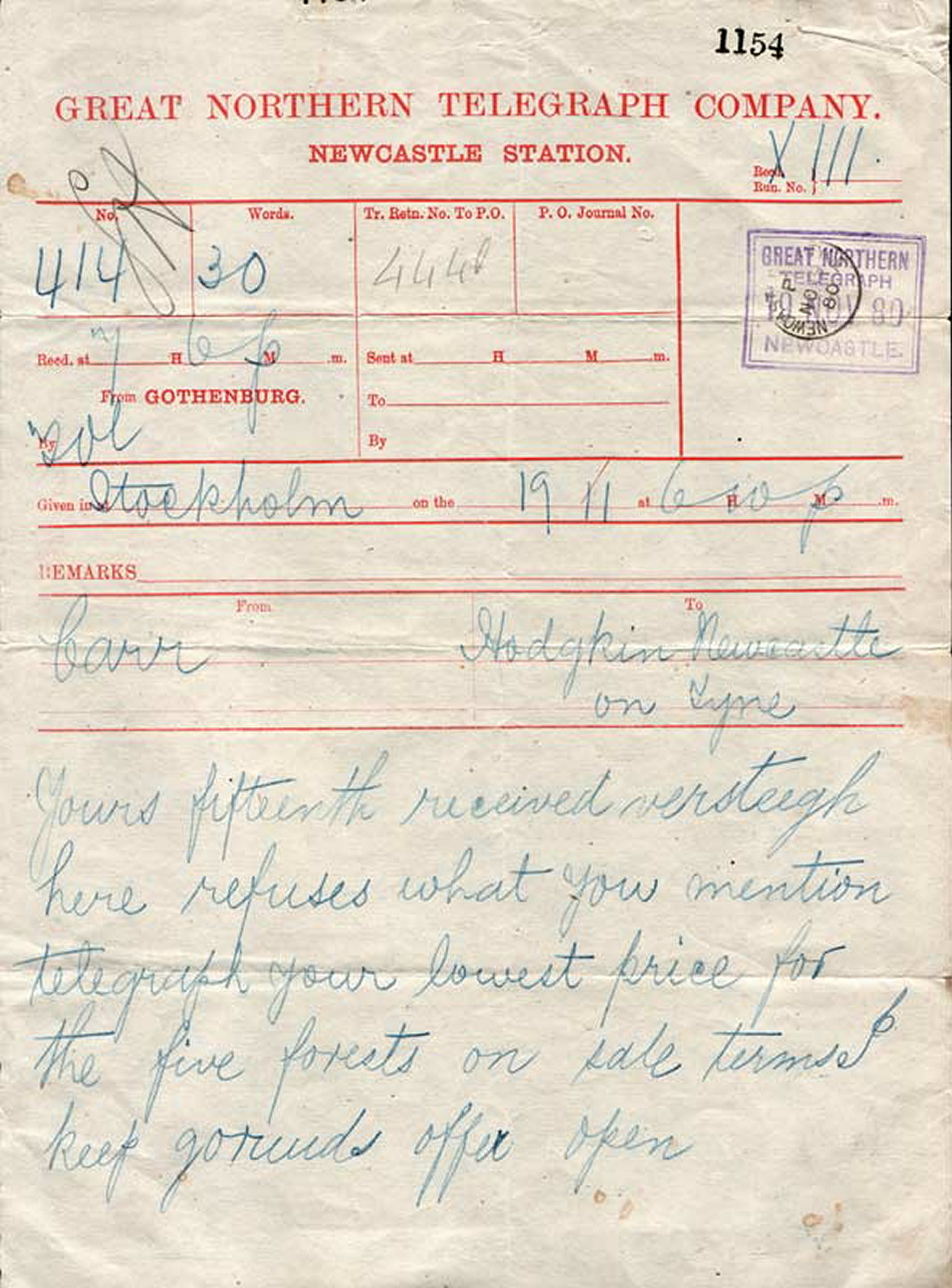
This has no lines or word numbering at the bottom. - Image courtesy of Bill Glover.
This form is dated 16 March 1908 and was used in London for a telegram from Moscow.
It gives their address as 3, St. Helen's Place, London E.C.
It states "Accepts Telegrams for Denmark, Norway, Sweden, Russia, China, Manila, Japan &c.
Telegrams are also accepted at all Postal Telegraph Offices and should be marked - VIA NORTHERN."
In this year, 1908, Their building at No: 7, the Bund, was opened in 1908 and the Great Northern Telegraph Company
was the first to provide telephone and telegraph services here in Shanghai.
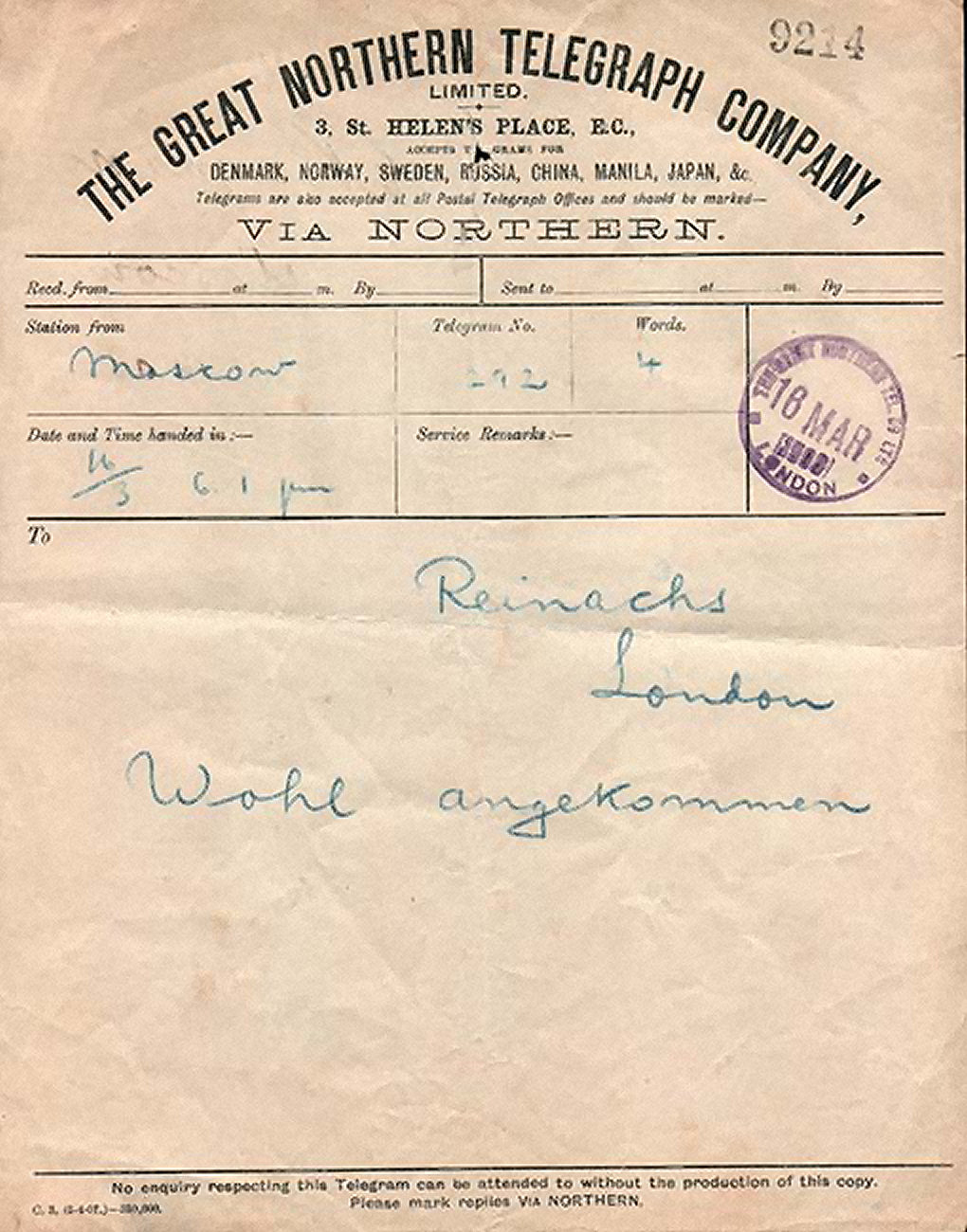
The imprint looks like "G. N. (3-1-01)-300,000." - Image courtesy of Bill Glover.
This recent envelope is dated 31 January 1978 and was used in London for a "Cablegram Via Northern". Their address on the back is the same place.
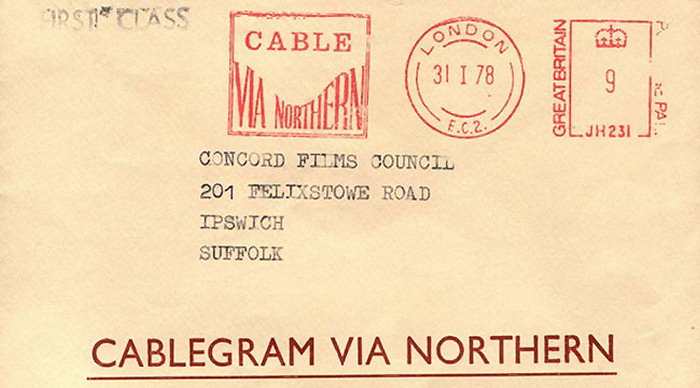
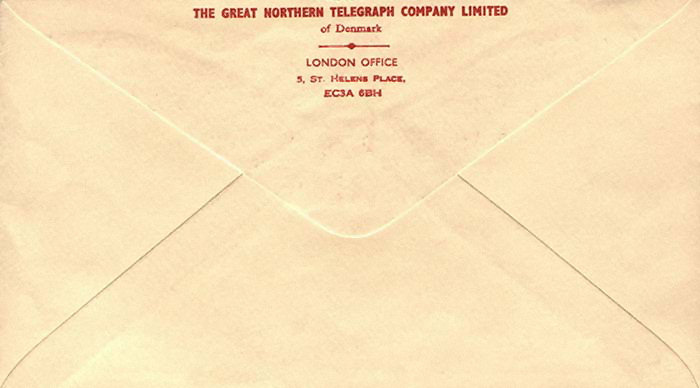
Images courtesy of Bill Glover.
Many of the Victorian and Edwardian Telegraph forms were printed by a company called Griffiths & Sons, that may or may not be related.
The Secretary of Reuter's in 1878 was Frederick J. Griffiths.
The company appears to have their main office at 49, Spring Gardens, Manchester and another office at 62-3 Mark Lane, London.
They advertise a "Special Service to and from India", with offices at Calcutta, Bombay, Madras, Karachi, Delhi, Rangoon[Burma] and Colombo[Ceylon].
This was sent from Calcutta on 4 January 1916 and received at London 2 days later. On the left is a cachet for the London Commercial Sale Rooms (30 Mincing Lane), where
the London District Telegraph Company also had an office. - Image courtesy of Jim Hammond.
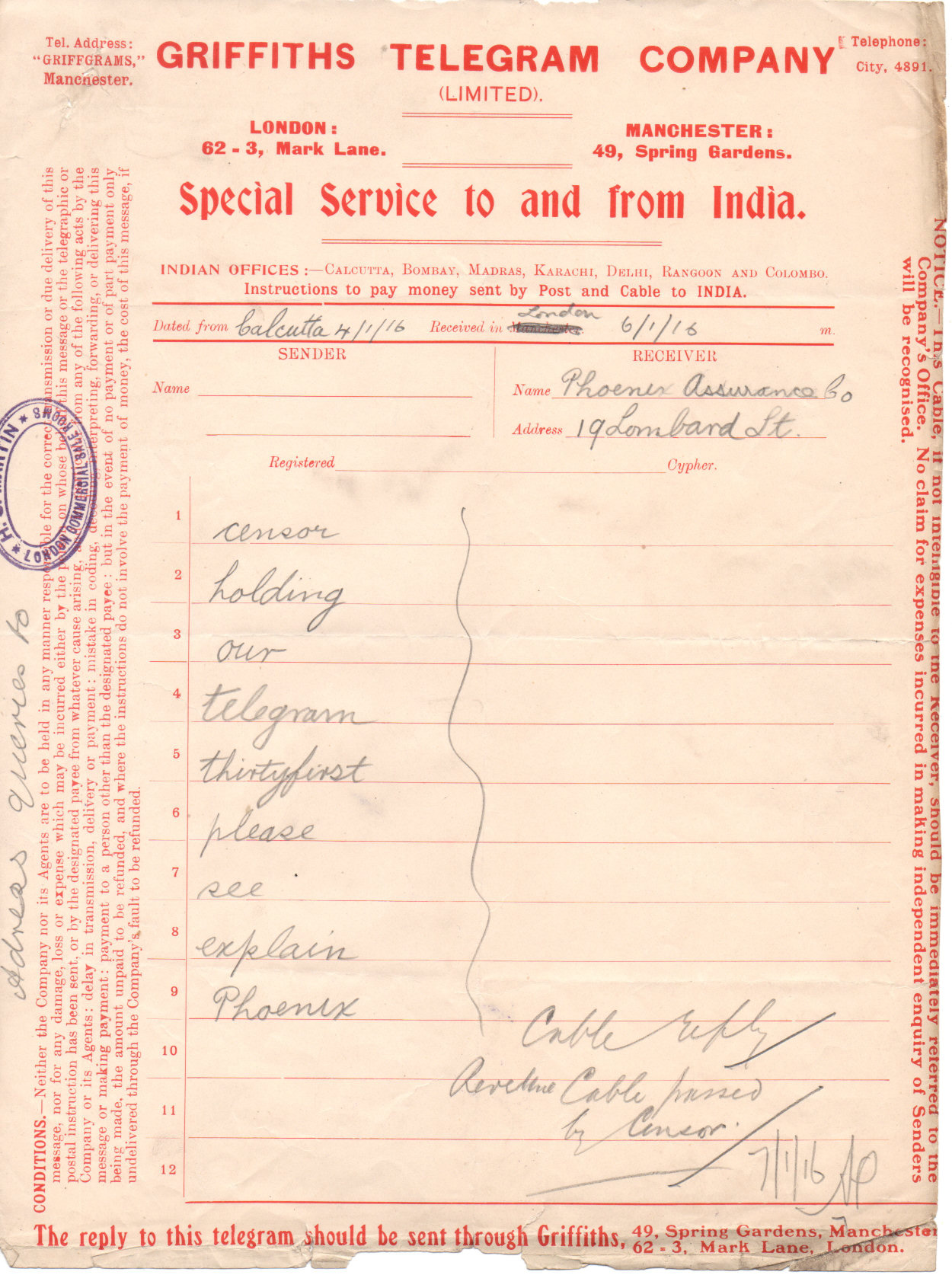
This company was initially set up to connect with India via Russia and Persia, but of course that enabled connections to places further afield.
A Form 23 (Delivery Form) of 1900 for use in London, with Head Office at 18, Old Broad Street, London EC.
There is a long list of places to the east, as far as Australia. This was from Calcutta. Images courtesy of Jim Hammond.
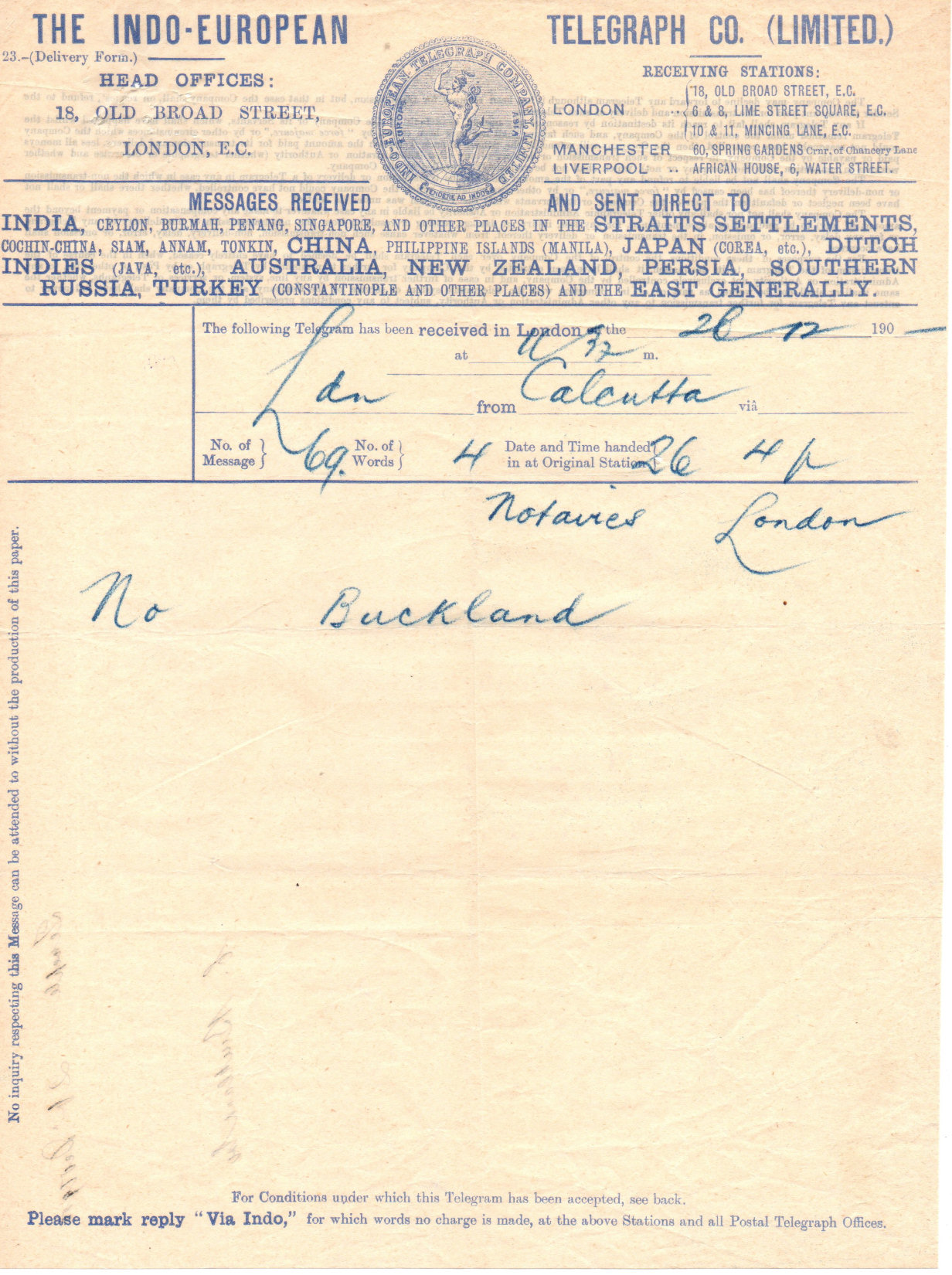
Back
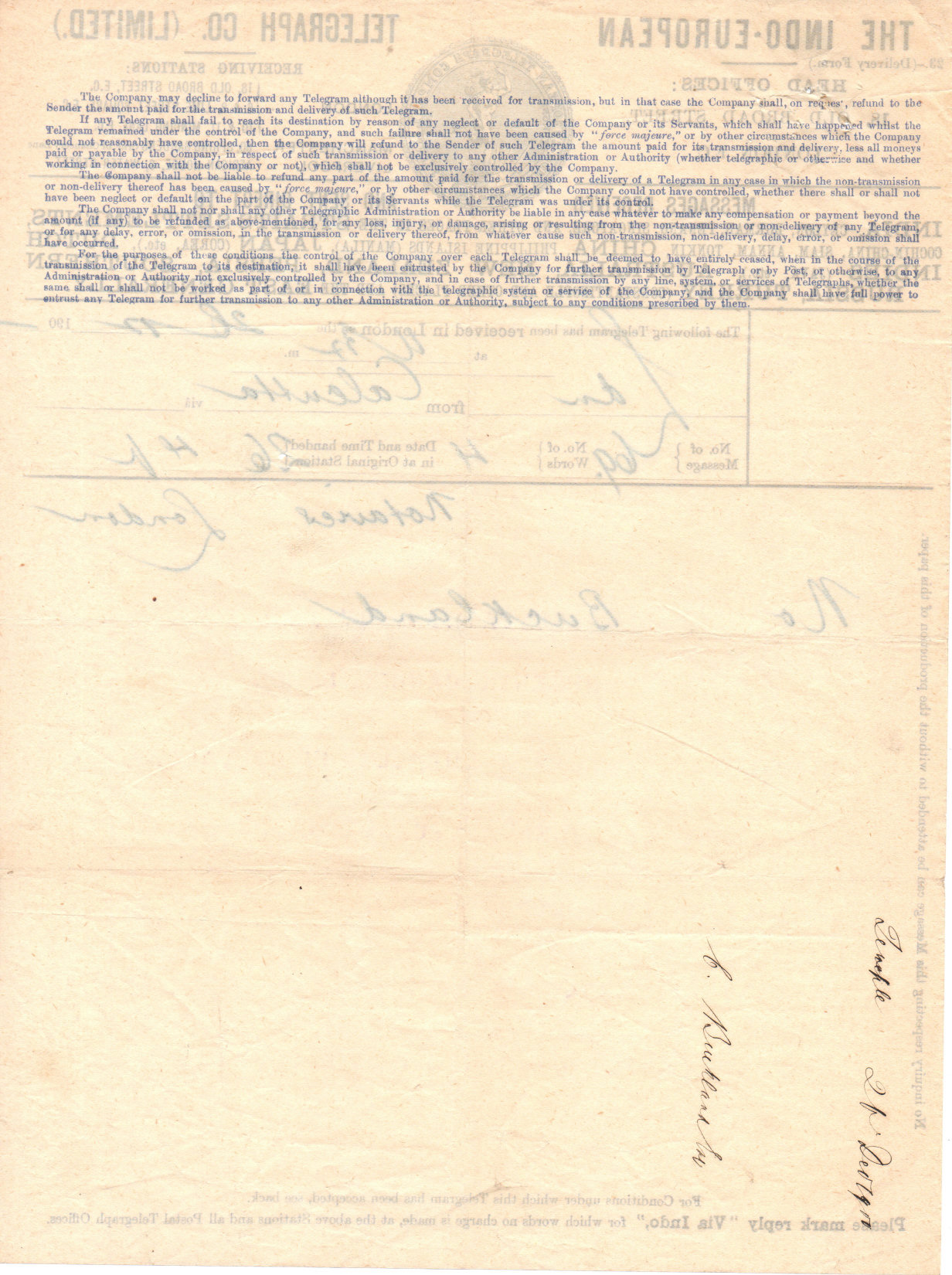
Conditions and limitations on the back.
Below is a carbon-copy with date-stamp.
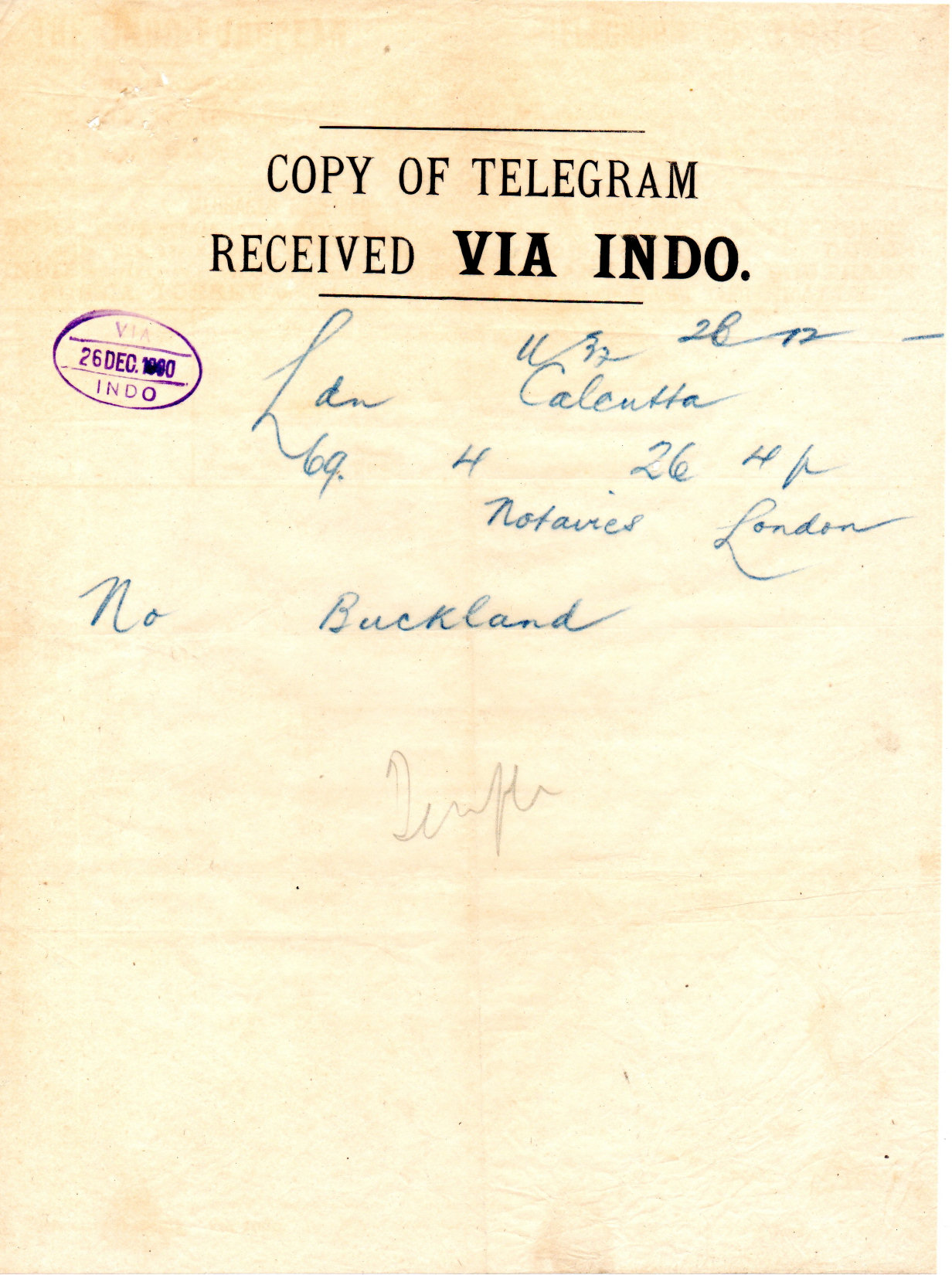
A Form 23 (Delivery Form) of 1902 for use in Liverpool, with Head Office at African House, 6 Water Street.
There is a long list of places to the east, as far as Australia. This was also from Calcutta. Images courtesy of Jim Hammond.
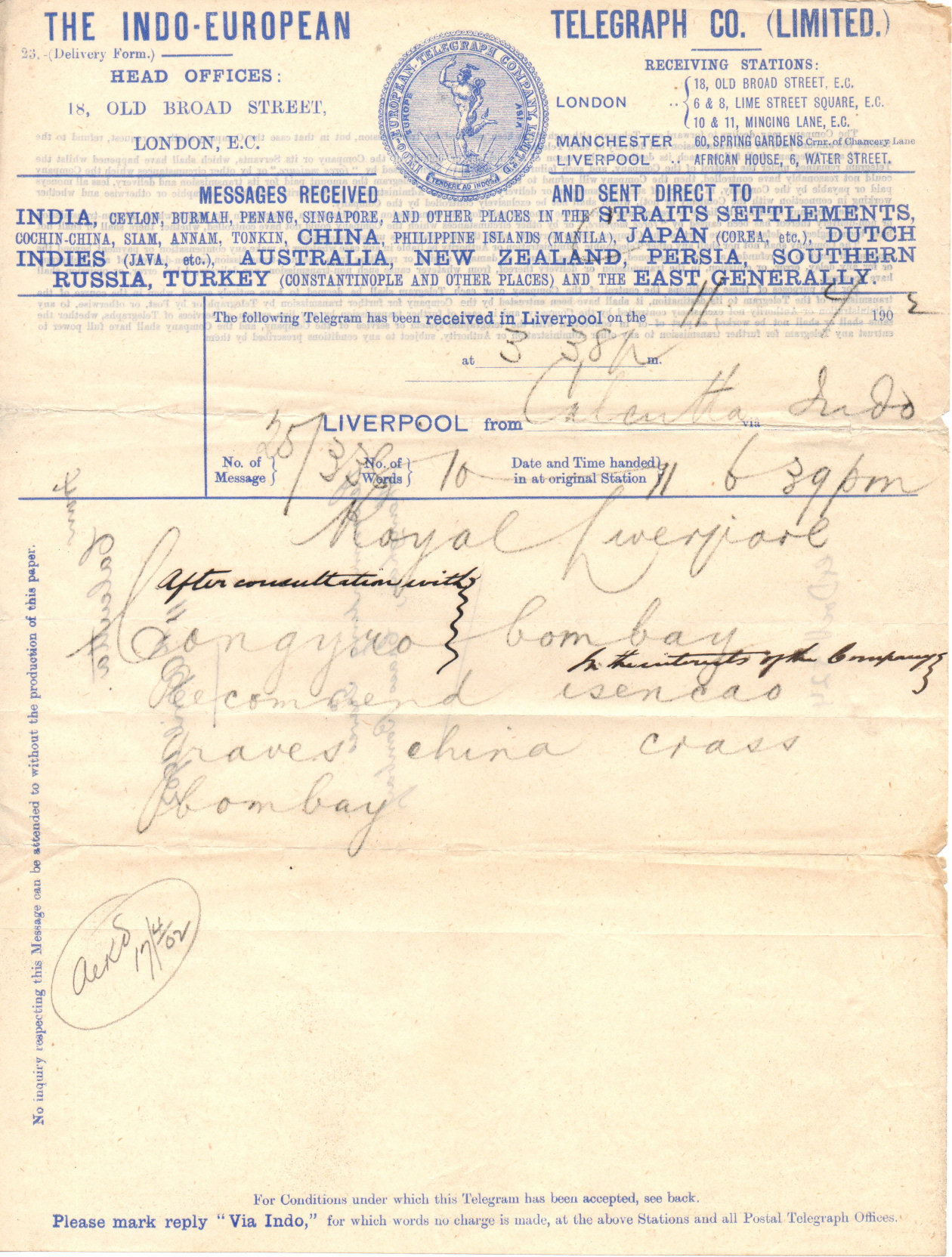
Back
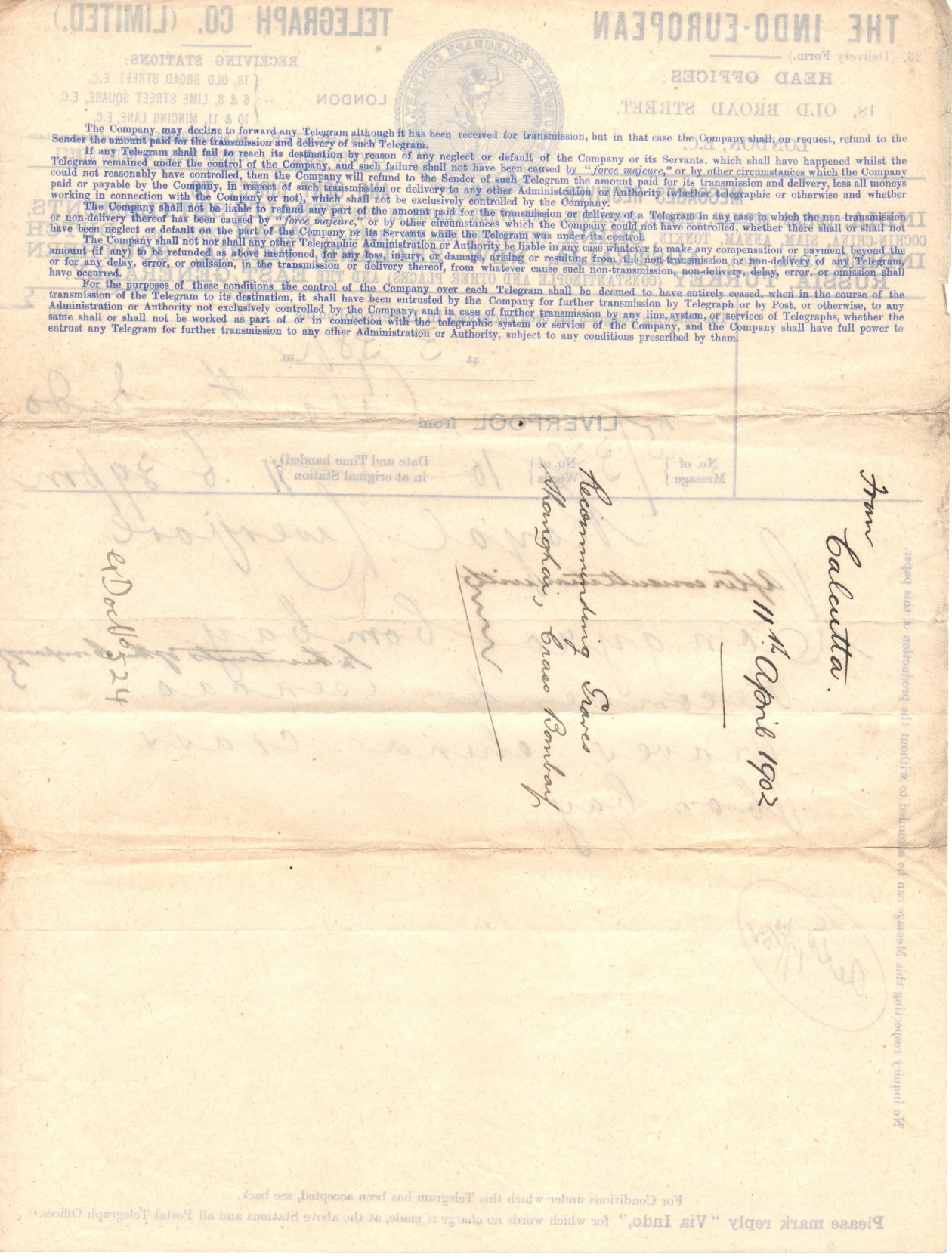
Conditions and limitations on the back.
A Delivery Form with no form number, received in London 13 July 1912 Via Indo. Registered Office at 18, Old Broad Street, London, E.C..
with two more offices in London, Lime Street Square and Mincing Lane, as well as offices in Liverpool and Manchester. Image courtesy of Edward Coombes.
Size 206 x 271 mm.
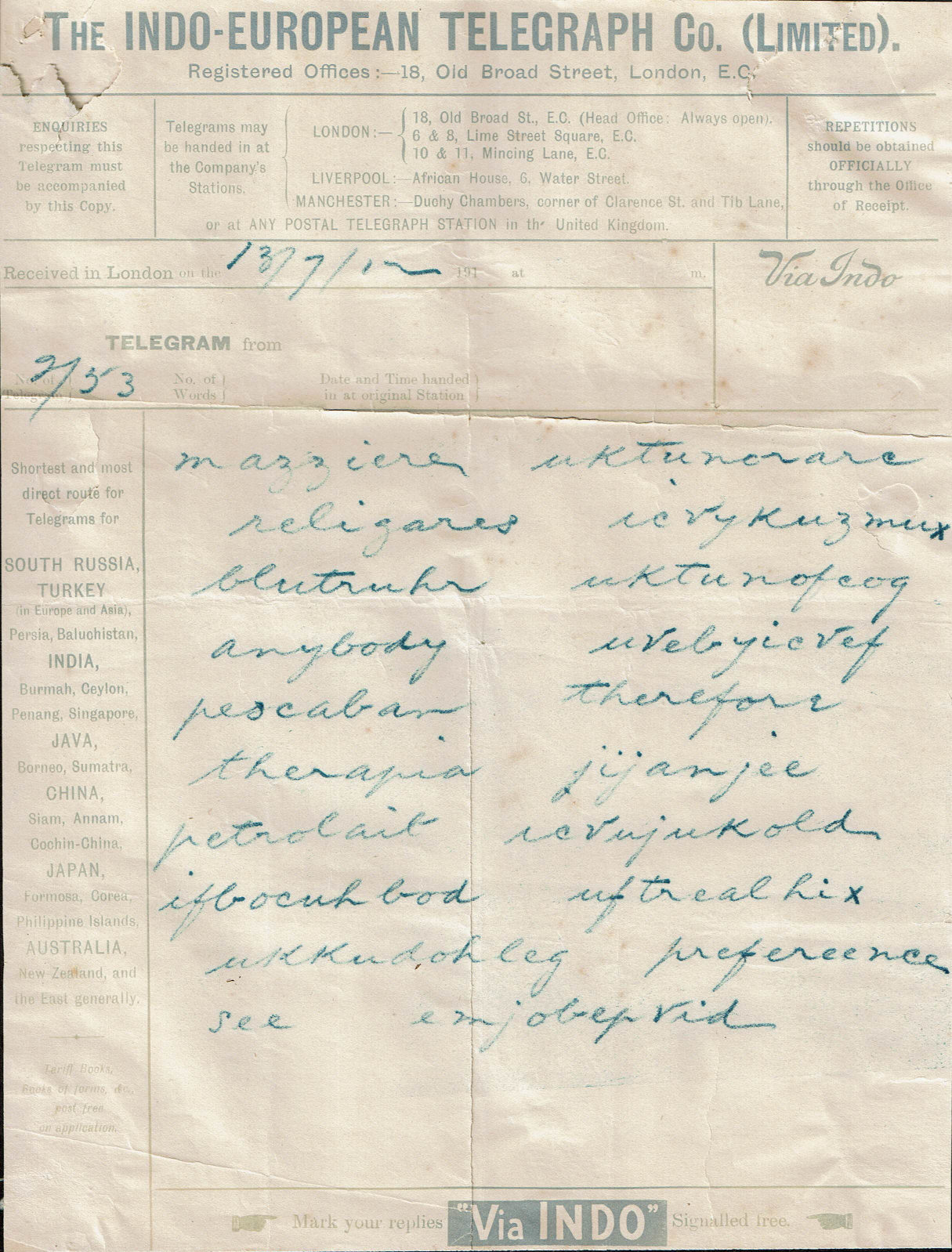
A list of other countries with offices down the left side.
An S.T. Repetition Form with "(S. T. Form.)" at top-left. Used in London 20 June 1912 for a message from Kinari (Nepal)
Image courtesy of Edward Coombes. Size 175 x 203 mm.
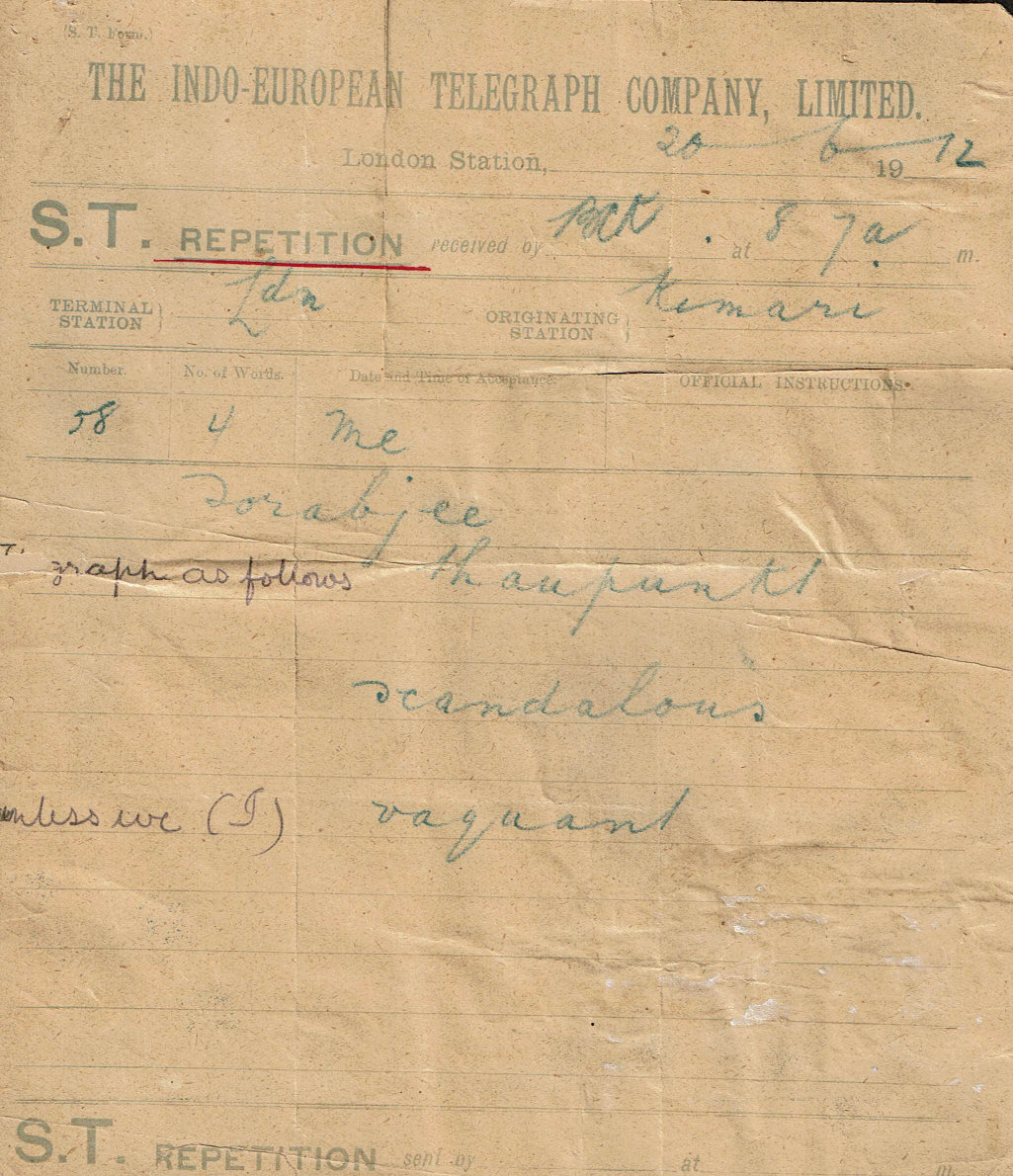
"S.T. Repetition" repeated at the bottom. Anyone know what the S. T. means ?
An Christmas / New Year Form to be used at one of their offices or mailed to their Head Office.
It was printed foruse in 1928-9, but changed for use the following year with price reductions for Hongkong, China, Japan, Formosa and Philippines.
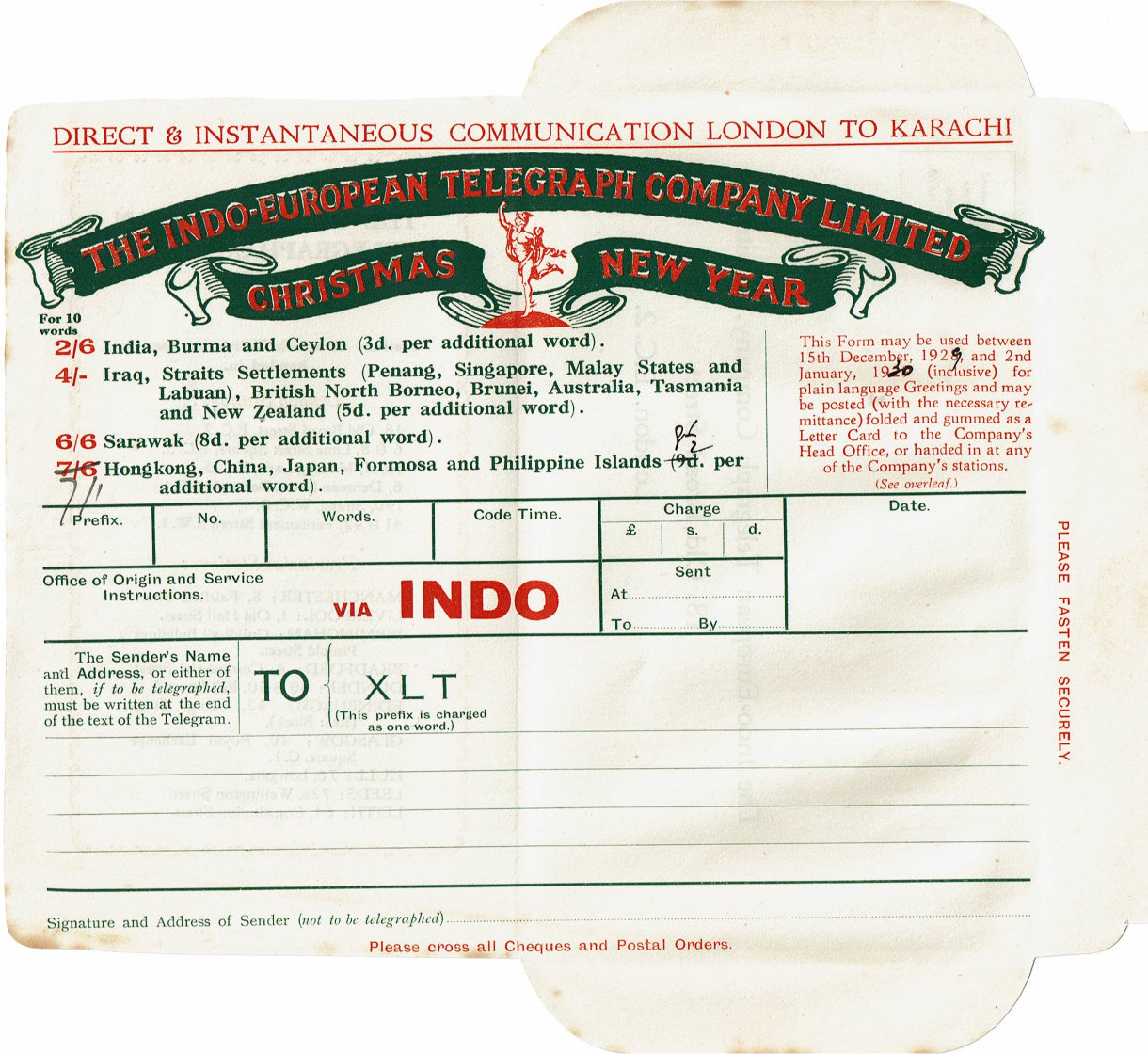
The back has space for a 1½d postage stamp with a list of 6 London Stations and 10 Provincial Stations, now extending to Scotland.
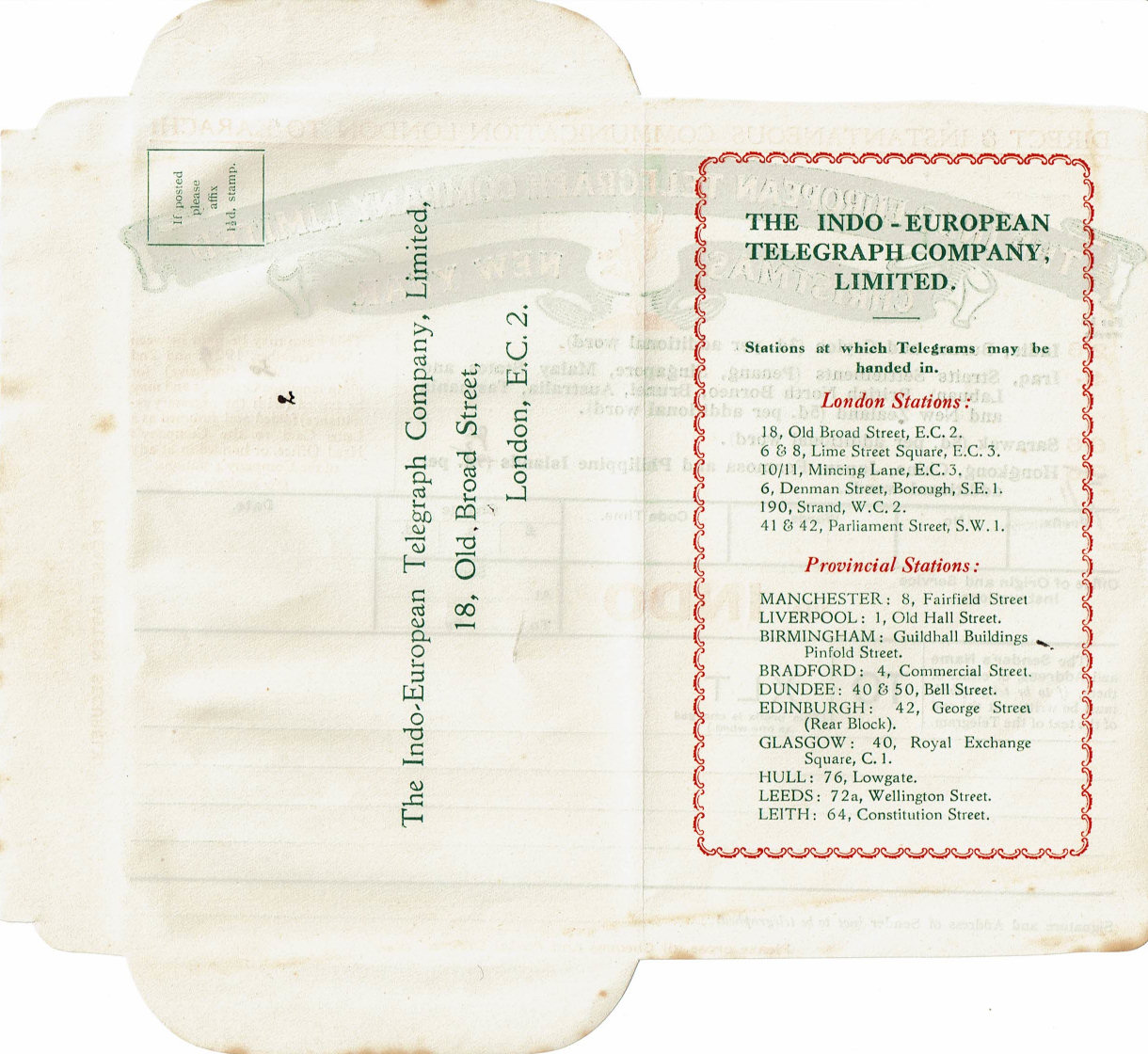
Images courtesy of Edward Coombes.
A later Delivery Form of 8 January 1931 without form number. This shows a move to Electra House in Moorgate, London.
This was also from Calcutta, but now in code and on strips. Image courtesy of Jim Hammond.
The date-stamp is marked "Imperial & International Communications"
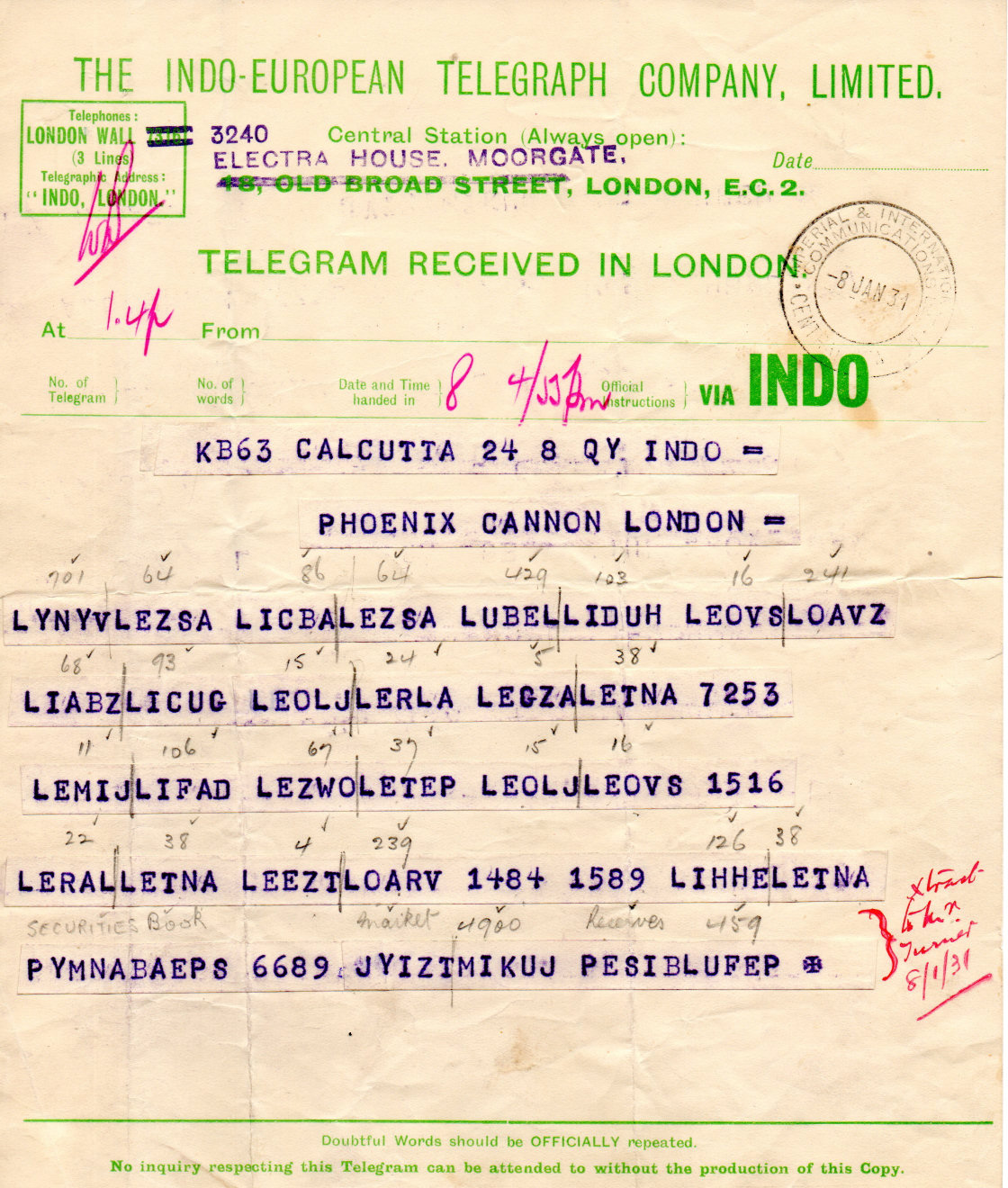
An undated Delivery envelope without form number. Courtesy of Jim Hammond.
Front.
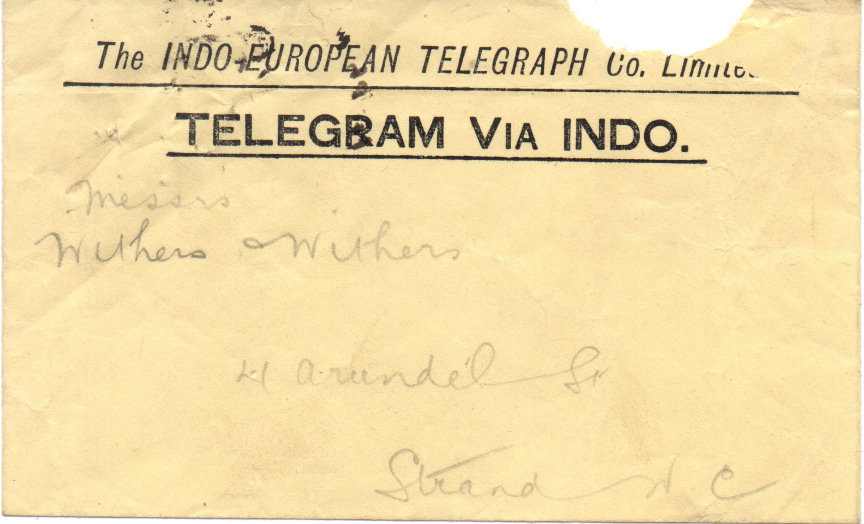
Back.
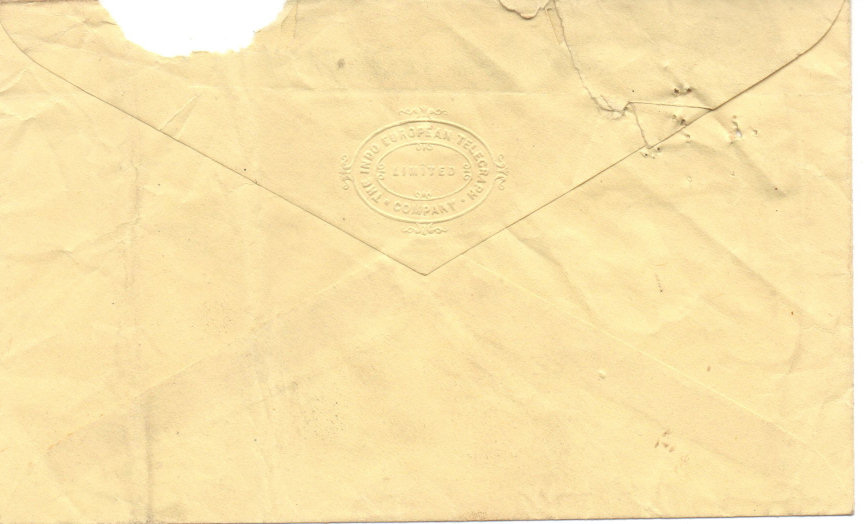
Embossing detail.
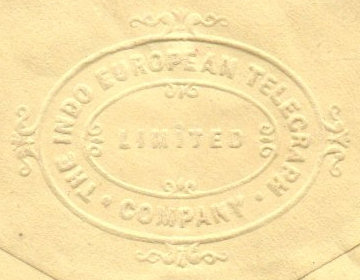
Progress Way, Croydon, Surrey.
A Radiogram of unknown date.
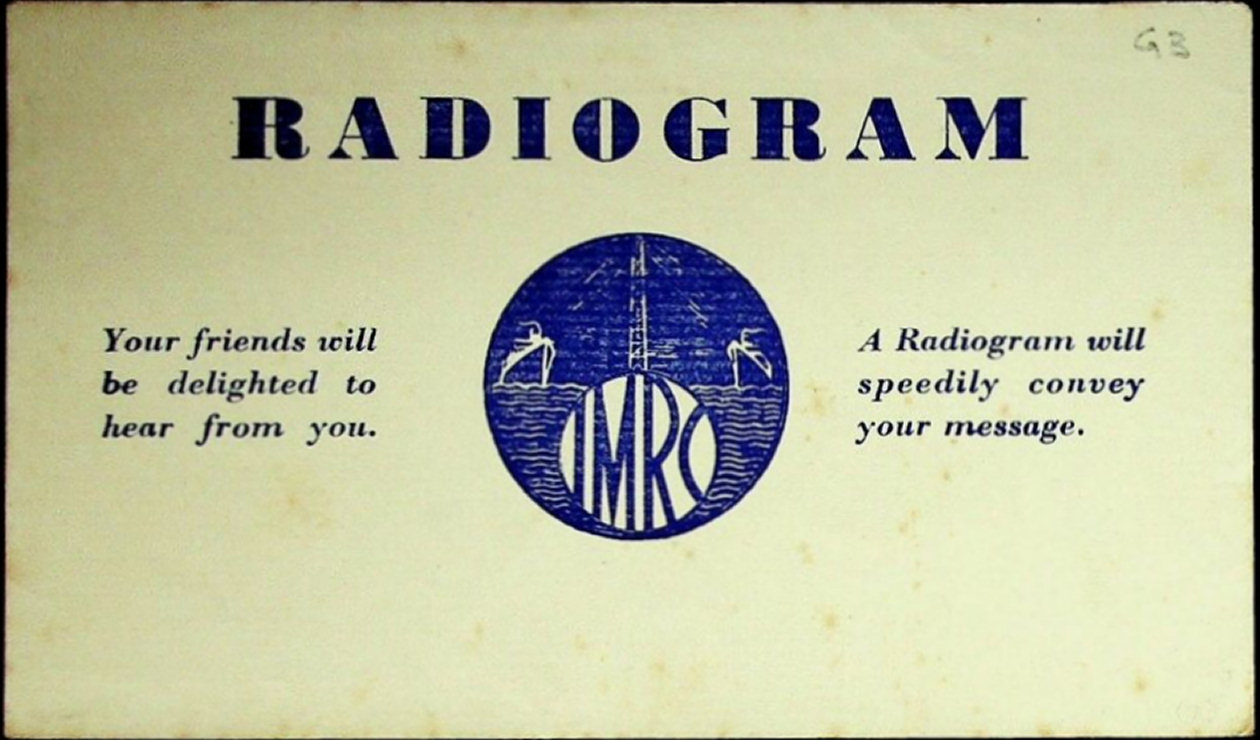
Back of Form B.3. with Company address and information.
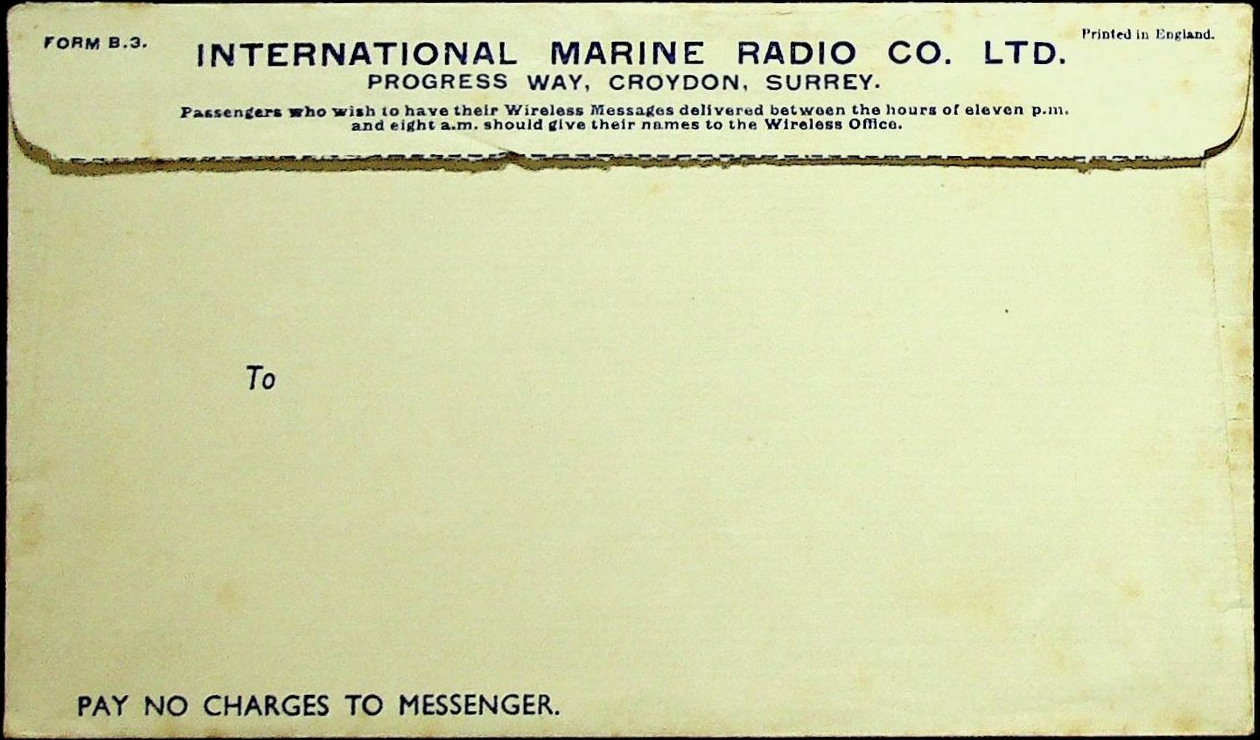
courtesy of AsianStamp - (click for listing).
Images for this section are proving to be elusive. Given that they did enough business to cause a major re-shuffling of the cable companies, you would have thought that their stationery would be abundant, but apparently not.
That is probably because they mostly enabled other pre-existing companies to sell telegraphic services to the end user. However they did sell equipment to ships at sea that had no previous supplier and needed stationery.
I can show you this, it is headed "The Marconi International Marine Communication Co., Ltd.", giving the Head Office as being in Finch Lane, London, E.C.
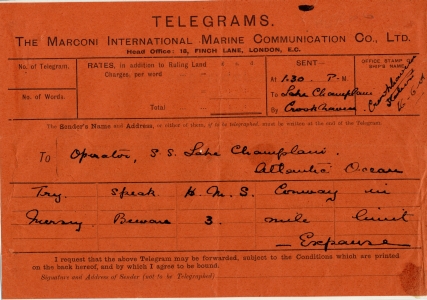
This was sent to the Steam Ship Champlain on 26 June 1901 while in the Atlantic Ocean. Not a wonderful image, it is from this web search.
I have obtained permission to use the image from HSM Images at Oxford University. (on loan from Bodleian. Image Ref: Shelfmark MS. Marconi 249, 779a Marconigram June 1901)
A "Marconigram" of 20 May 1925, received in London, to mail to Germany.
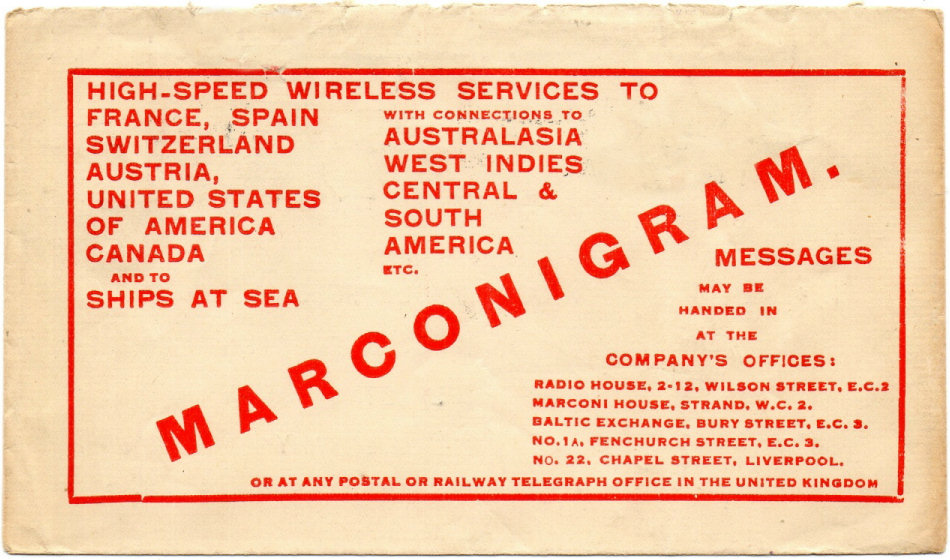
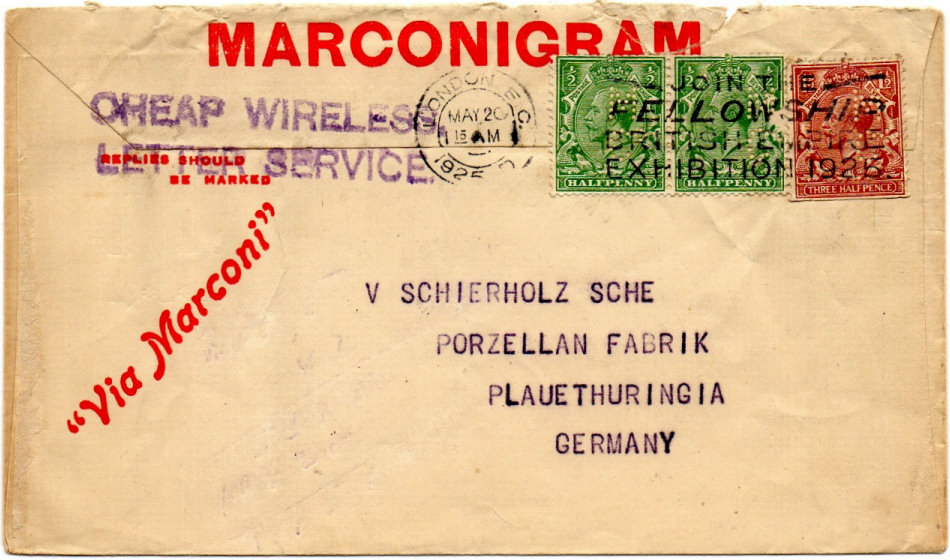
The actual front of the envelope is covered with information, including the addresses of 4 offices in London, plus an office in Liverpool.
The address is on the back, with the stamp. and an advertisement for a "Cheap Wireless Letter Service".
A "Marconigram" of 8 April 1926, received in London, to mail to Germany.
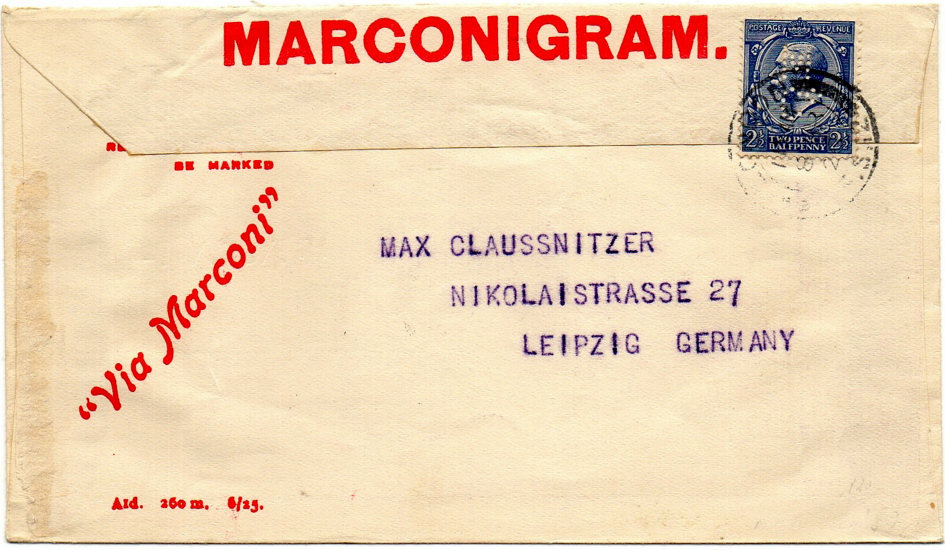
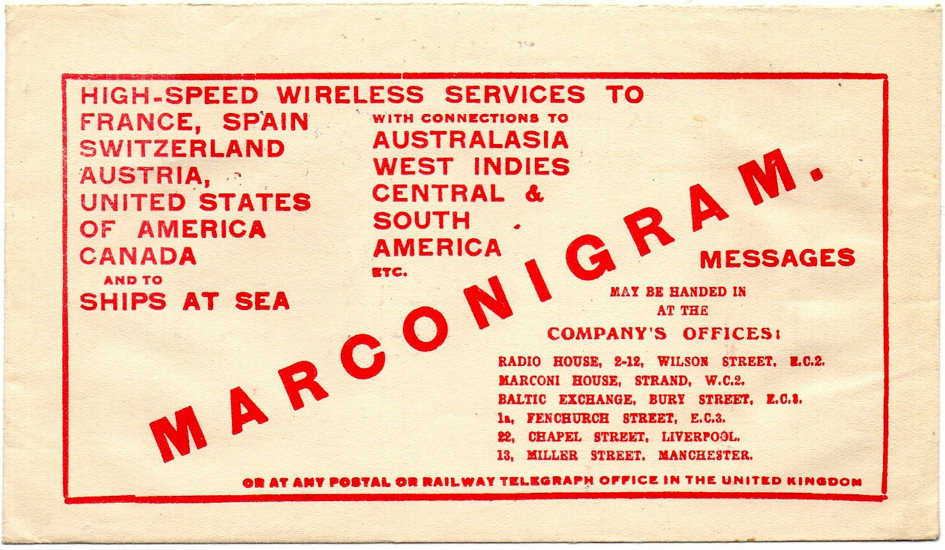
The actual front of the envelope is covered with information, including the addresses of 4 offices in London, one in Liverpool and one in Manchester.
The address is on the back, with the stamp, and an imprint of "A1d. 260m. 6/25." which I take to imply a printing date of June 1925.
A "Marconigram" of May 1928, received in London, to mail to Czechoslovakia.
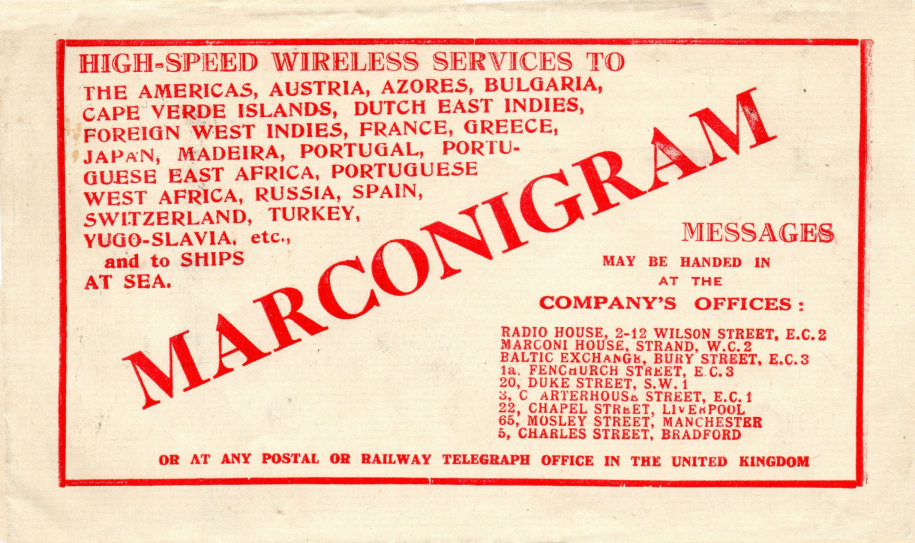
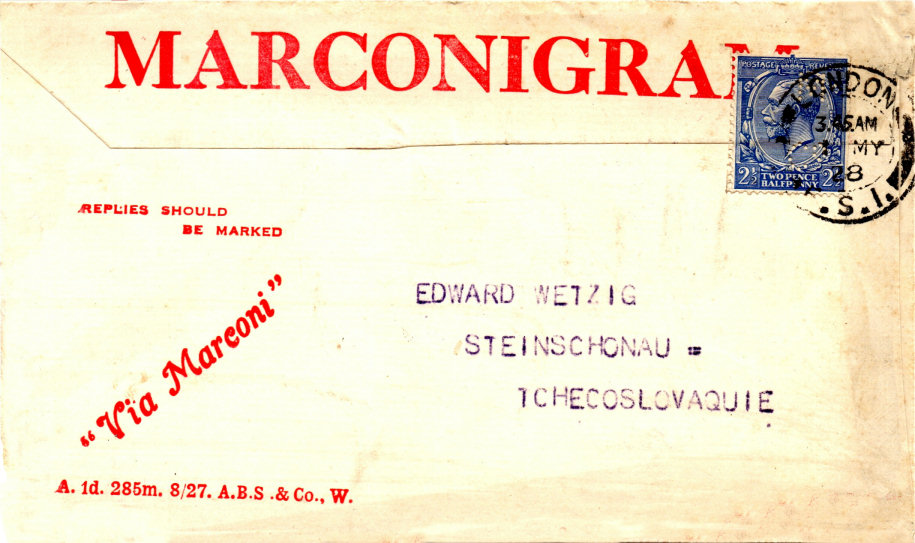
The actual front of the envelope is covered with information, including the addresses of 6 offices in London, plus offices in Liverpool, Manchester and Bradford.
The address is on the back, with the stamp which is effectively used as a seal (intentionally or not). There is also an imprint of "A. 1d. 285m. 8/27. A.B.S .& Co., W."
suggesting it was printed August 1927.
I can also show you a United States Envelope.
This company operated largely in the Americas, but was based at Elecrtra House, Moorgate, London, E.C.2.
A Telegram used in Rio-de-Janeiro on 18 December 1934 marked "(1030) (Cread Port)" at top-left.
At top-right, it has a time-code disk very similar to that used by the Eastern Telegraph Co.
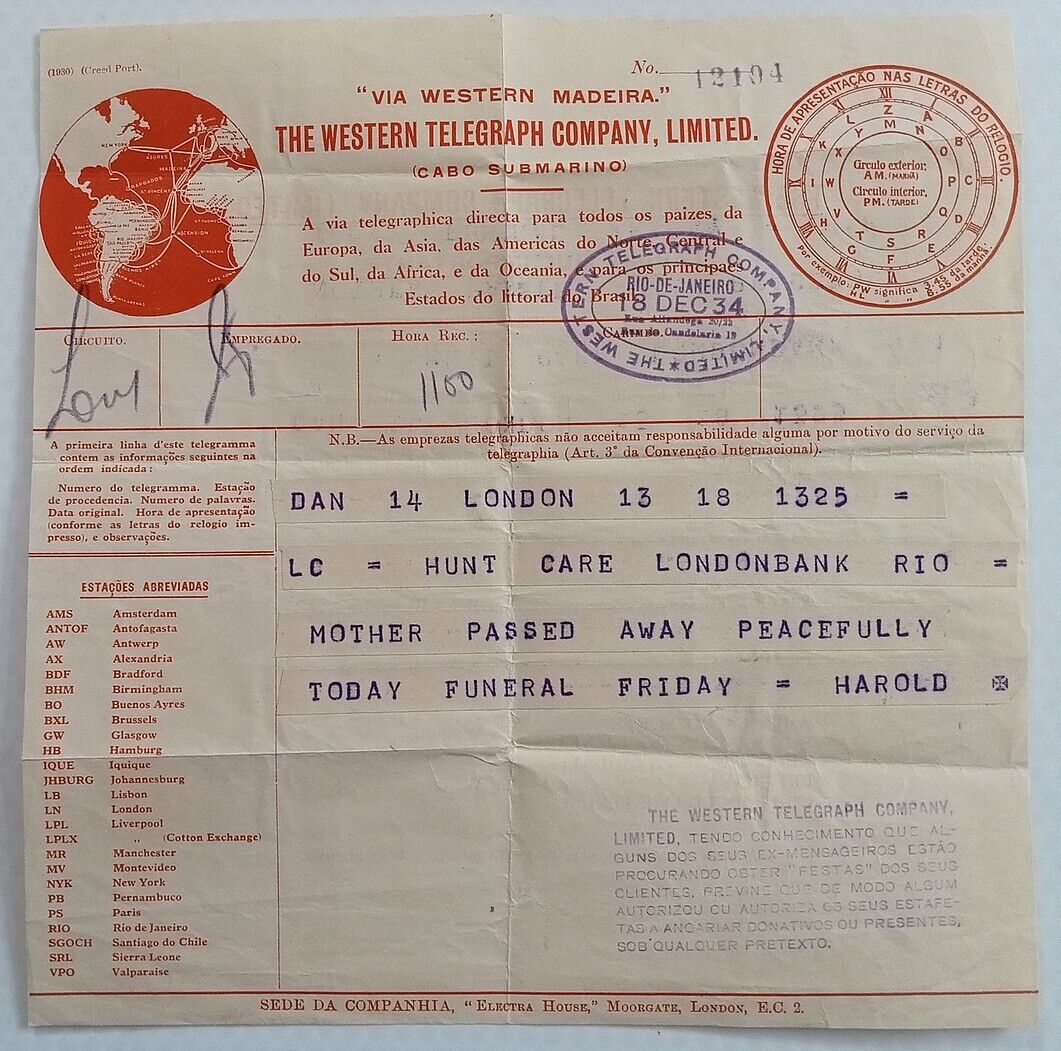
There is a list of Station Abbreviations, many in Britain and Europe, with the London address at the bottom.
Image courtesy of AlphaOmegaPhilately on eBay (click image for listing).
Though this is actually a form for use in the Americas, there should have been forms for use in Britain too. Anyone have any ?
This does not appear to quite fit the definition of a Telegraph company in that, as far as I know, it did not have any lines of its own, but simply used existing telegraph lines.
For example by 1860 they were using private lines of the Universal Private Telegraph. It was though influential and did cause the creation of new lines.
For example, according to Atlantic-Cable.com "... Lowestoft to Norderney and was operated by the Submarine Telegraph Company for Reuters Telegraph Company;
it formed the first leg of the Indo-European Telegraph Company's line to India."
Additionally, three items shown here appear to be personal and one Business correspondence rather than news items, and their Rules do include the use for Private Telegrams.
Paul Julius Reuter, a Canadian, founded Reuter’s Telegram Company in Britain in 1851.
This has "Rules to be observed in forwarding Private Telegrams from the Provinces or Abroad to Reuter's ..." it is by Order of the Secretary Frederick J. Griffiths (a surname I keep seeing)
it has an imrint at bottom-left dating it at 8 December 1878 - Size 205 x 262mm, nothing on the back.
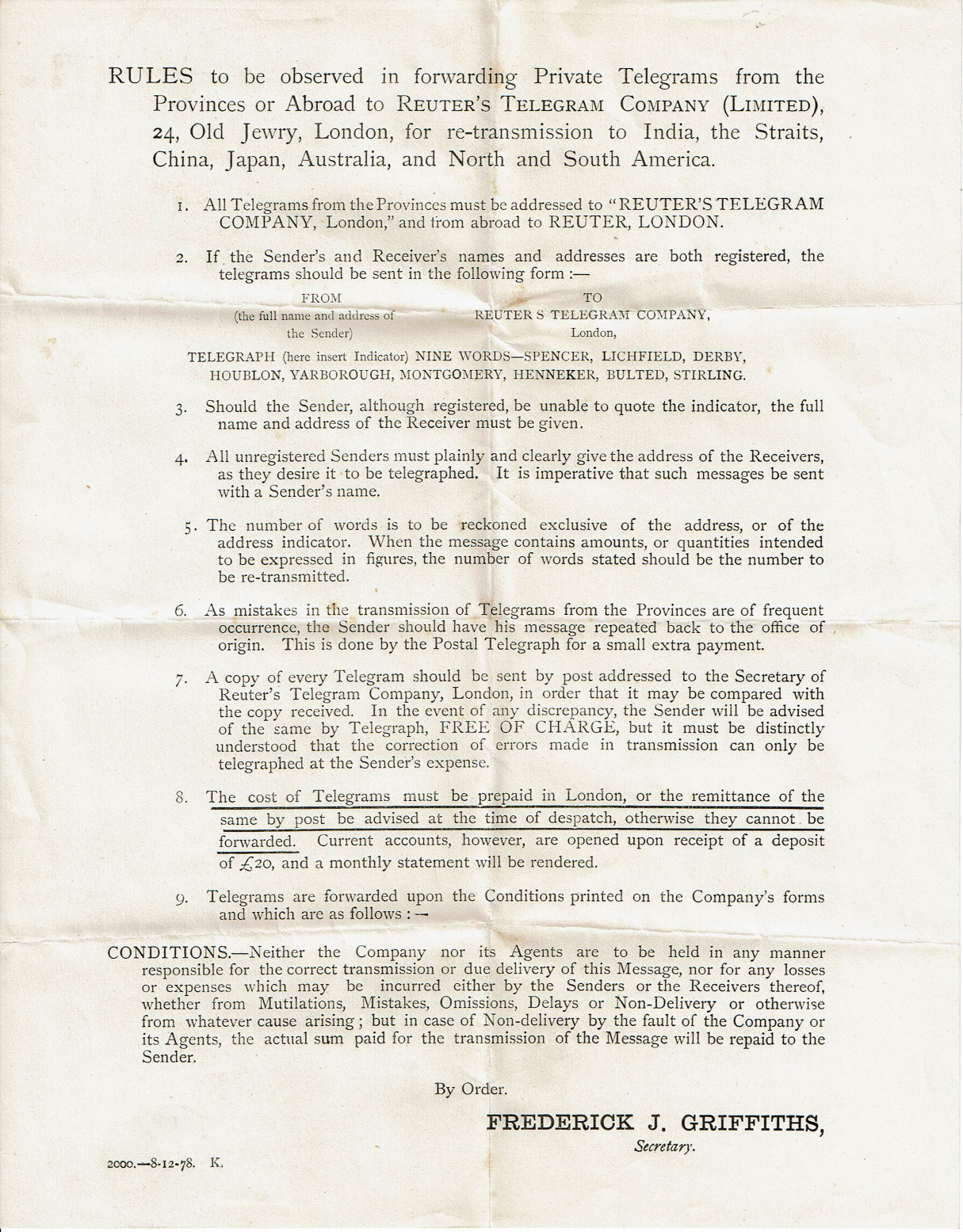
These are signed by the Secretary, Frederick J. Griffiths with the form dated 8 December 1878.
![]()
Images courtesy of Edward Coombes.
This is dated 1 March 1883 and it was used in Colombo for a telegram from London.
This is for "Eastern Branch" and lists cities within it. - Size 205 x 296mm, nothing on the back.
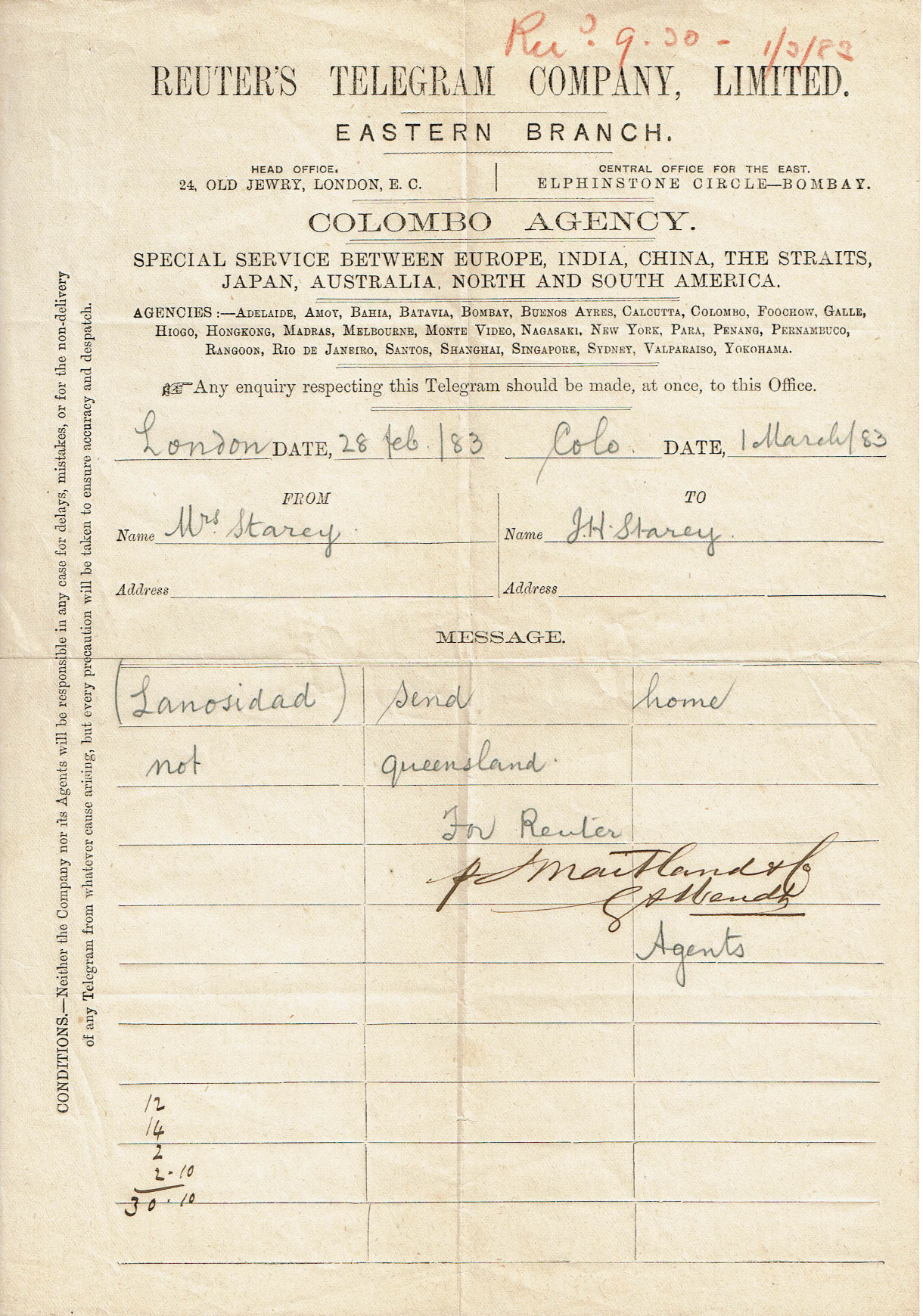
Image courtesy of Edward Coombes.
This is a "Tariff for Telegrams." it is by Order of the Secretary Walter F. Bradshaw
it has an imrint at bottom-left dating it at May 1893.
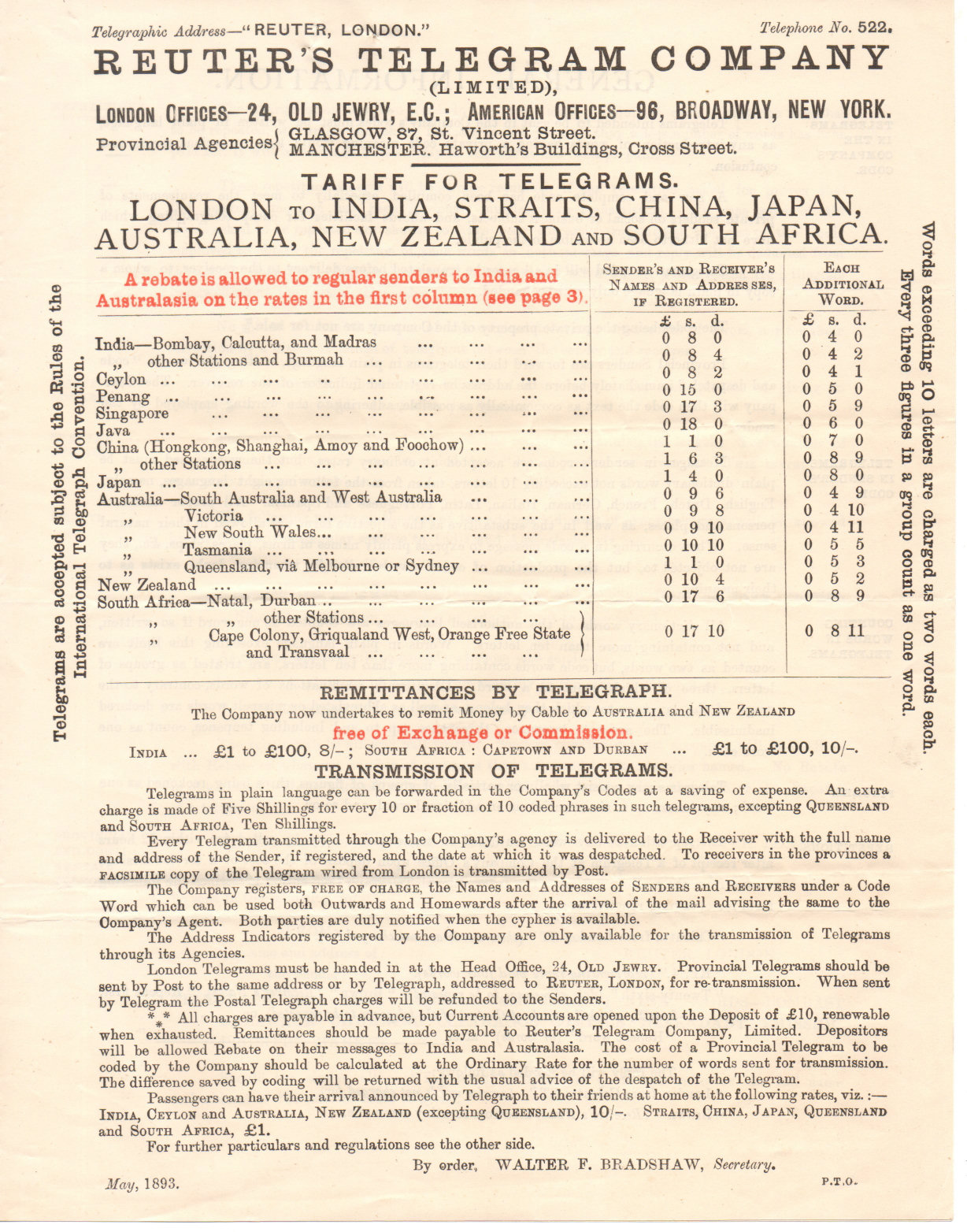
Note the "P.T.O." at the bottom-right. There are actually 3 more pages of "General Information", with the last having an imrint at bottom-left saying "2,000 / 21-4-93."
Image courtesy of James Hammond.
An unused Money Transfer form of 1910, in red, for a Money Transfer. For use at Waterloo Chambers, 19, Waterloo Street, Glasgow. Size 217 x 280 mm & plain on reverse.
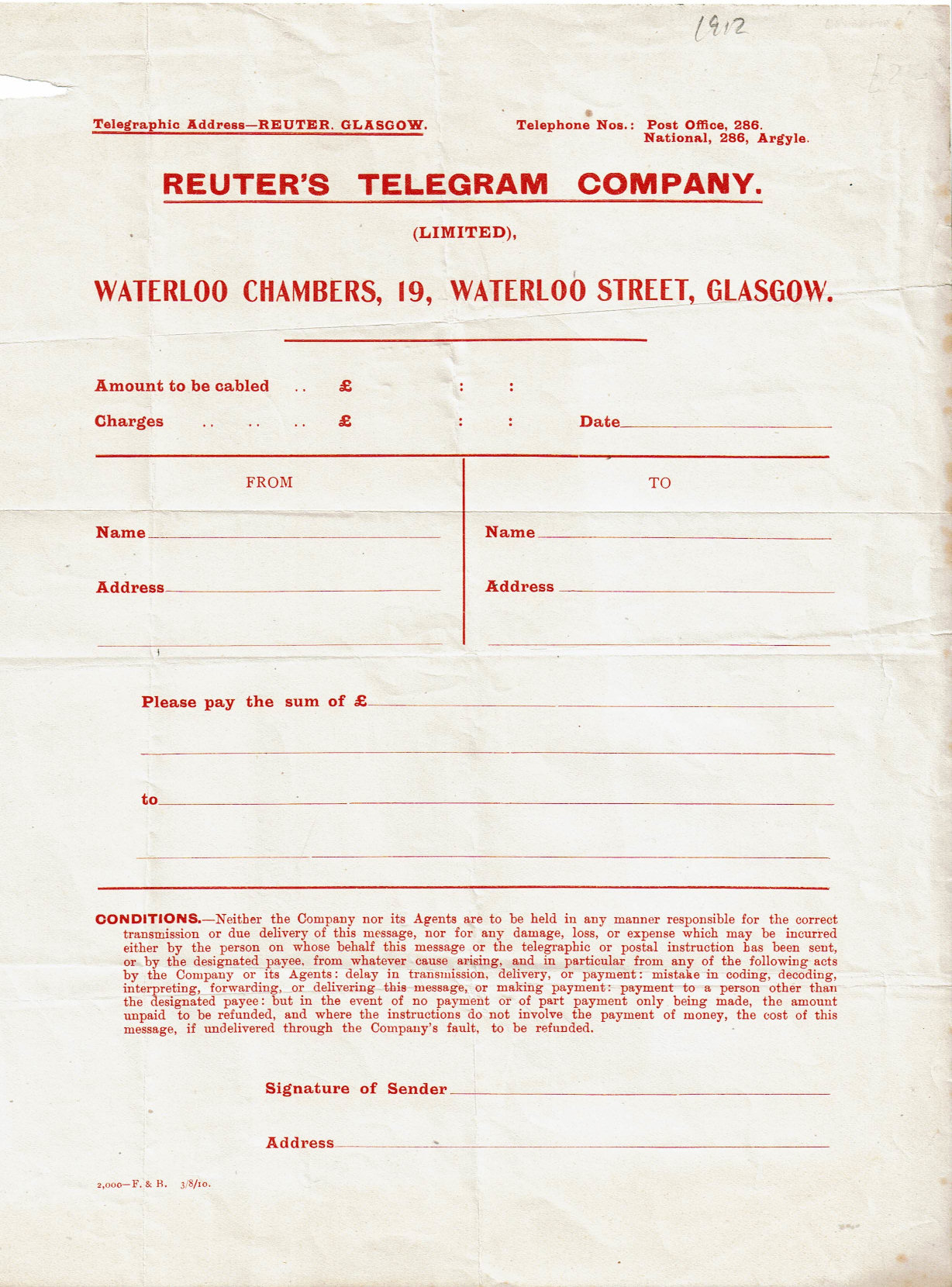
The imprint at the bottom-left indicates a date of 3 August 1910 and printing by F. & B.

Images courtesy of Edward Coombes.
A telegram sent in code from Calcutta, received in London on 1 January 1913.
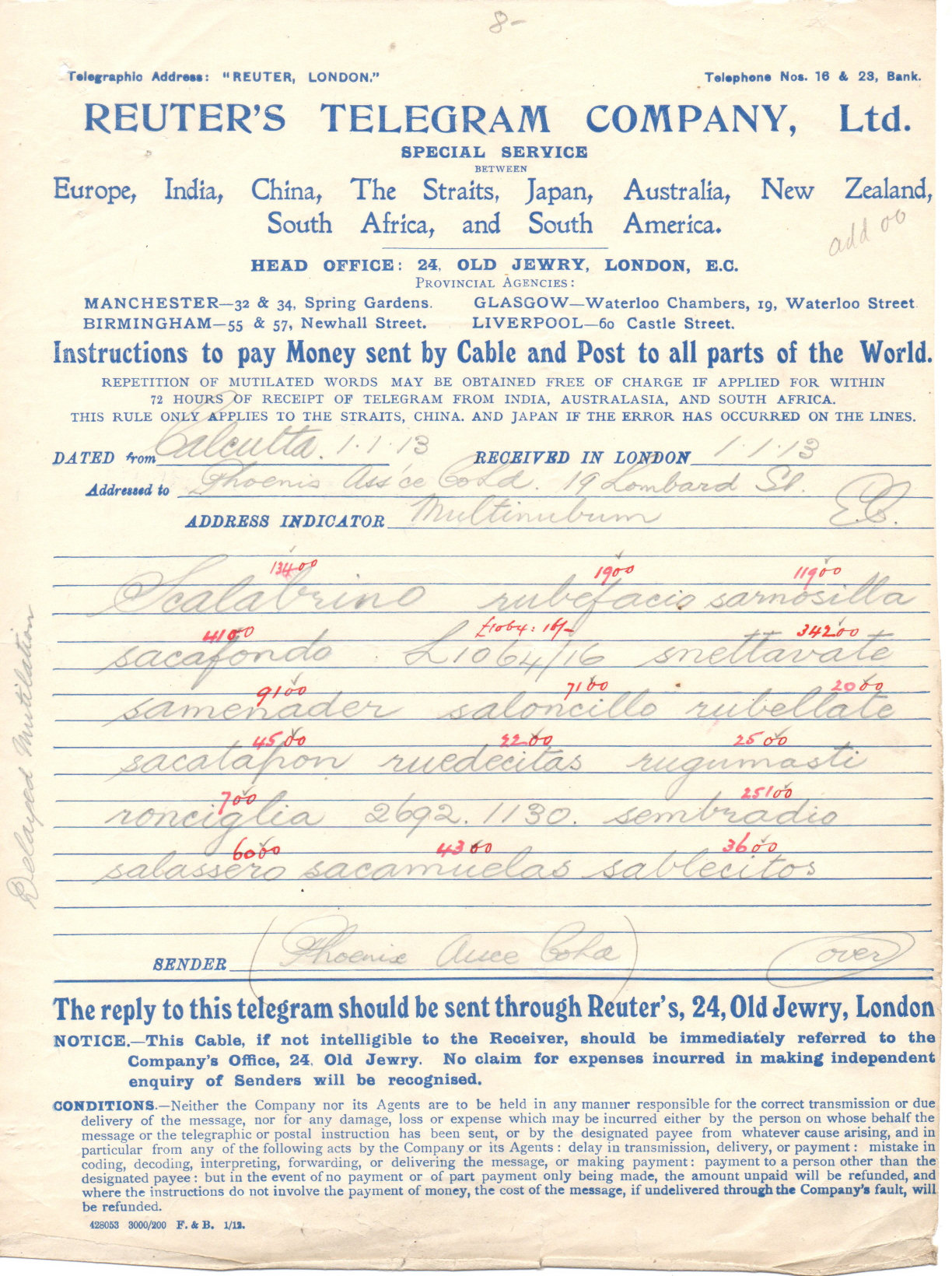
The imprint at bottom-left indicates it was printed by "F. & B." in January 1912.
Image courtesy of James Hammond.
A sympathy "Reuters Limited" telegram from Melbourne to London dated 4 July 1918. size 217 x 272 mm & plain on reverse.
Advertising "Special Service". Head Office at 24 Old Jewry, London, E. C. 2. With instructions for Money transfers.
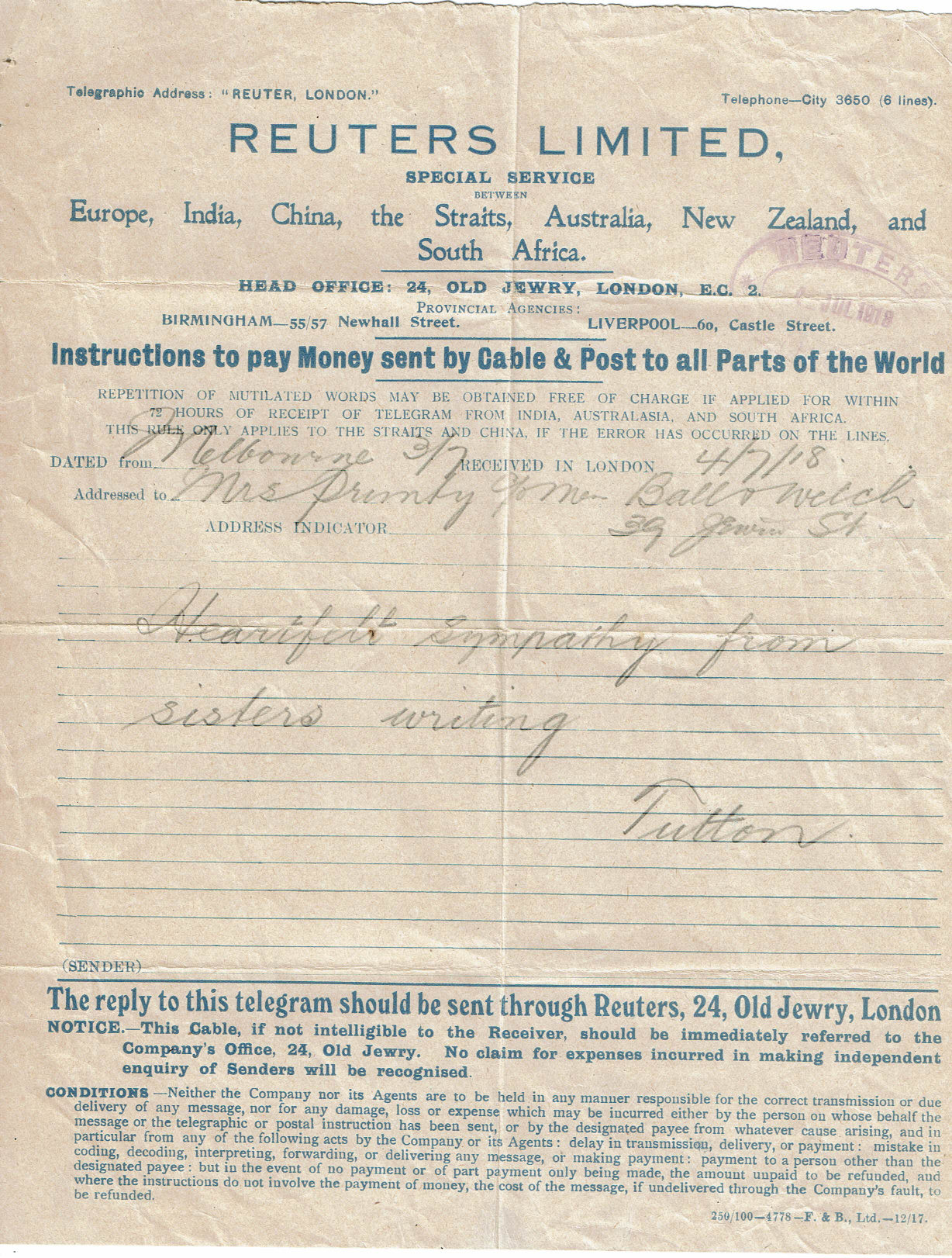
The imprint at the bottom indicates a date of December 1917, with printing by F. & B. Ltd.

Images courtesy of Edward Coombes.
Similar to last, dated 6 July 1923. size 210 x 274 mm & plain on reverse.
Advertising "Special Service". Head Office at 24 Old Jewry, London, E. C. 2. With instructions for Money transfers.
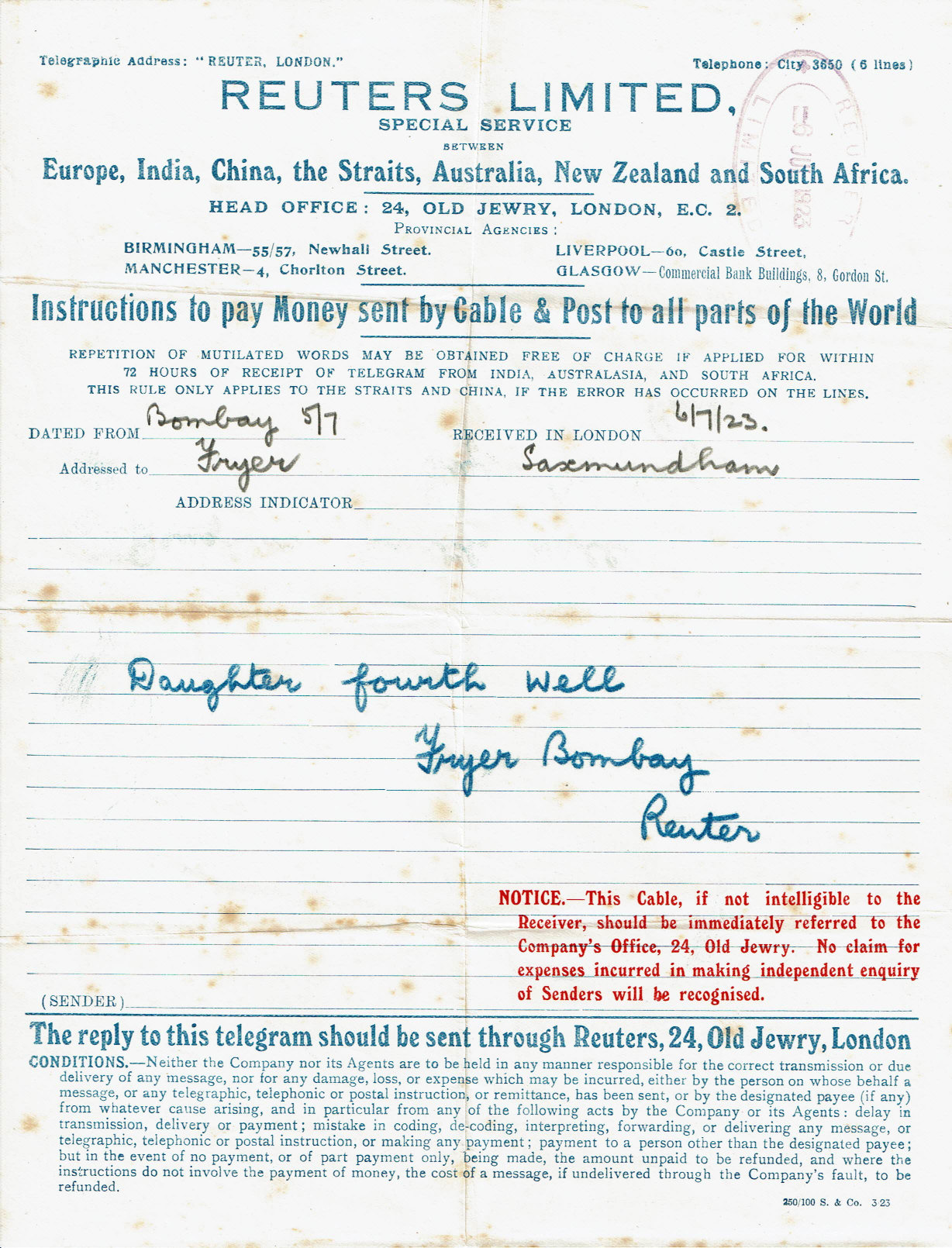
A large red Notice about what to do if "This Cable, if not intelligible".
The imprint at the bottom indicates a date of March 1923, with printing by S. & Co.

Images courtesy of Edward Coombes.
Apparently identical to the last apart from the imprint. Dated 26 July 1923. size 210 x 274 mm & plain on reverse.
This has an added label in red with 'THE REPLY TO THIS TELEGRAM SHOULD BE HANDED IN AT etc'.
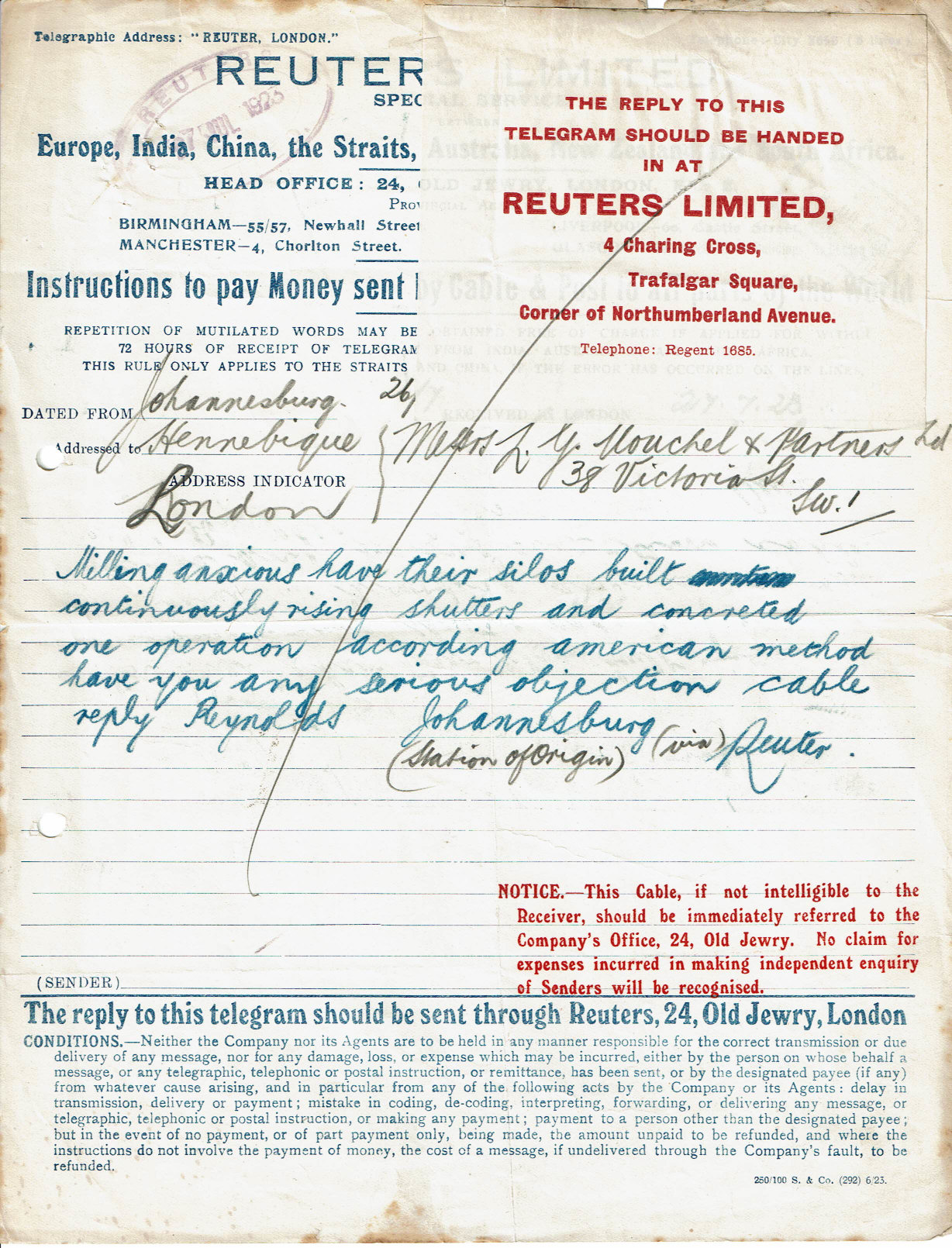
The imprint at the bottom now indicates a date of June 1923 and printing by S. & Co., and an added "(292)".

Images courtesy of Edward Coombes.
An unused envelope in black for Reuter's at 24, Old Jewry, London, E.C. with "REGISTRATION."
Plain on reverse.
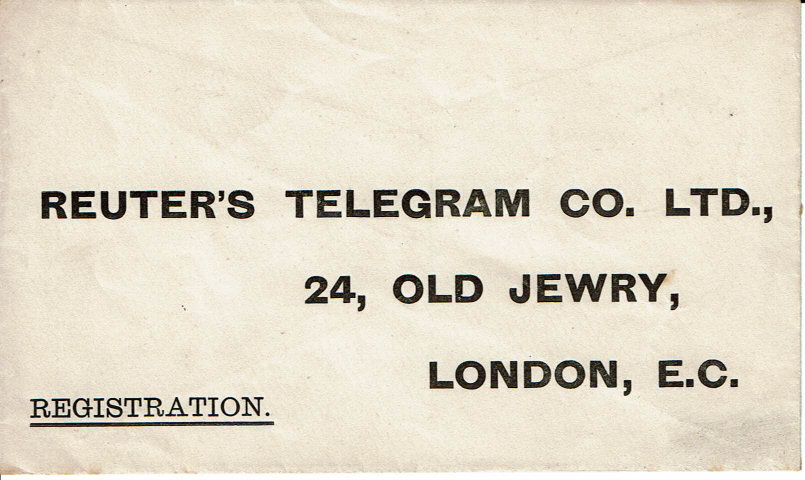
Image courtesy of Edward Coombes.
An envelope in red Headed 'PRIVATE TELEGRAM' with 'IMMEDIATE at base. Size 135 x 80 mm.
The back is printed in mauve 'TELEGRAMS CODED FOR SENDERS'. Circular cachet 'RTC Ltd Calcutta', date unreadable.
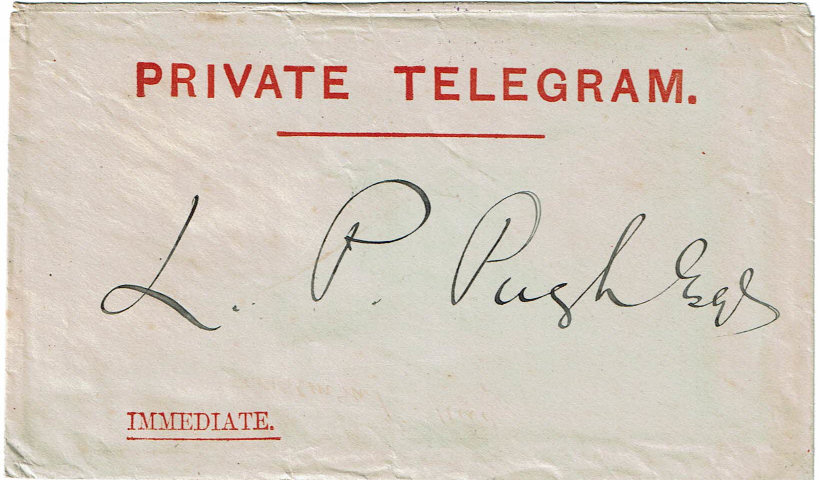
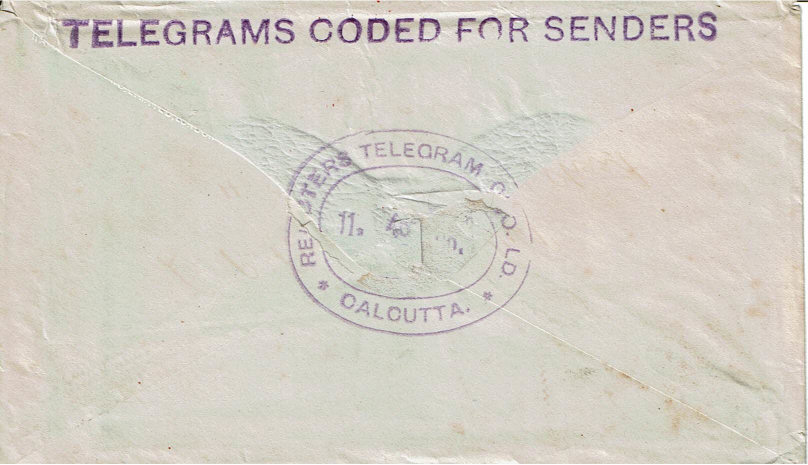
The envelope is like the envelopes of the Private Telegraph Companies pre 1870. Printer (on flap) is Waterlow & Sons Ltd. London Wall. Images courtesy of Edward Coombes.
A receipt for £43/18/- for money transfer, printed by Waterlow & Sons on 13 August 1907 and used 5 January 1910."
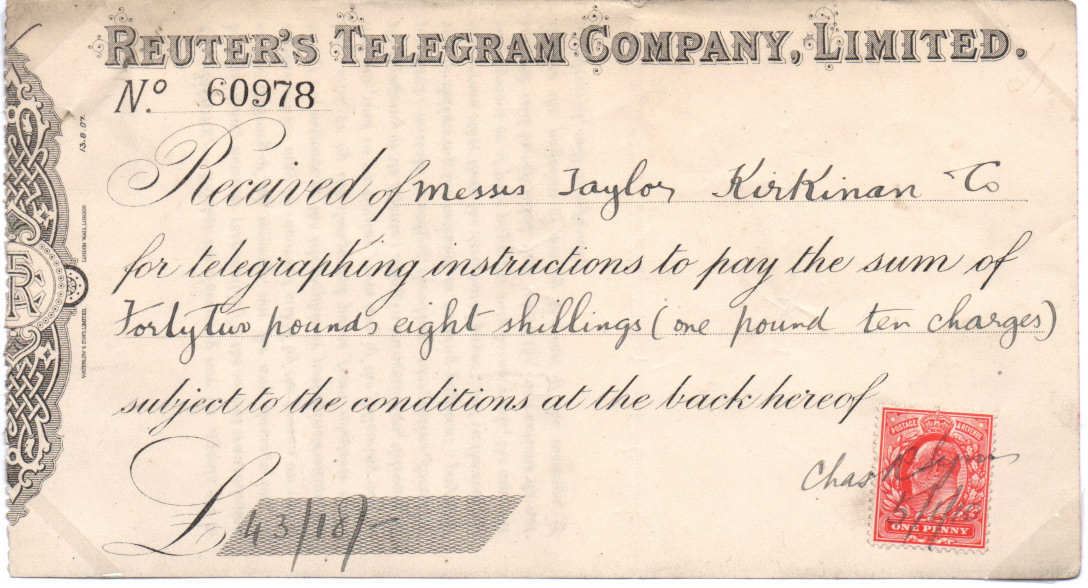
Detail from left side.
![]()
Images courtesy of James Hammond.
There are a number of items that do not fit into conventional categories, but do offer an insight into the inner workings of the G. P. O.
I will list them in date order.
This is dated March 1870
It was intended to accompany a numbered Railway cancel to the intended station. The back had directions for use.
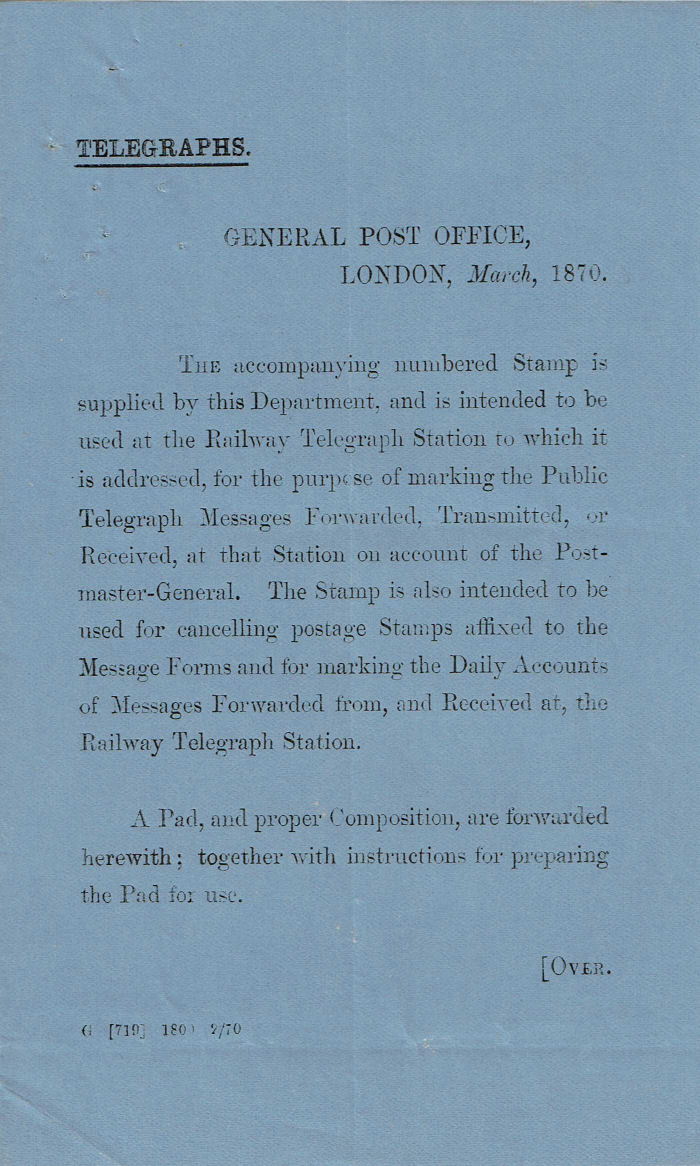
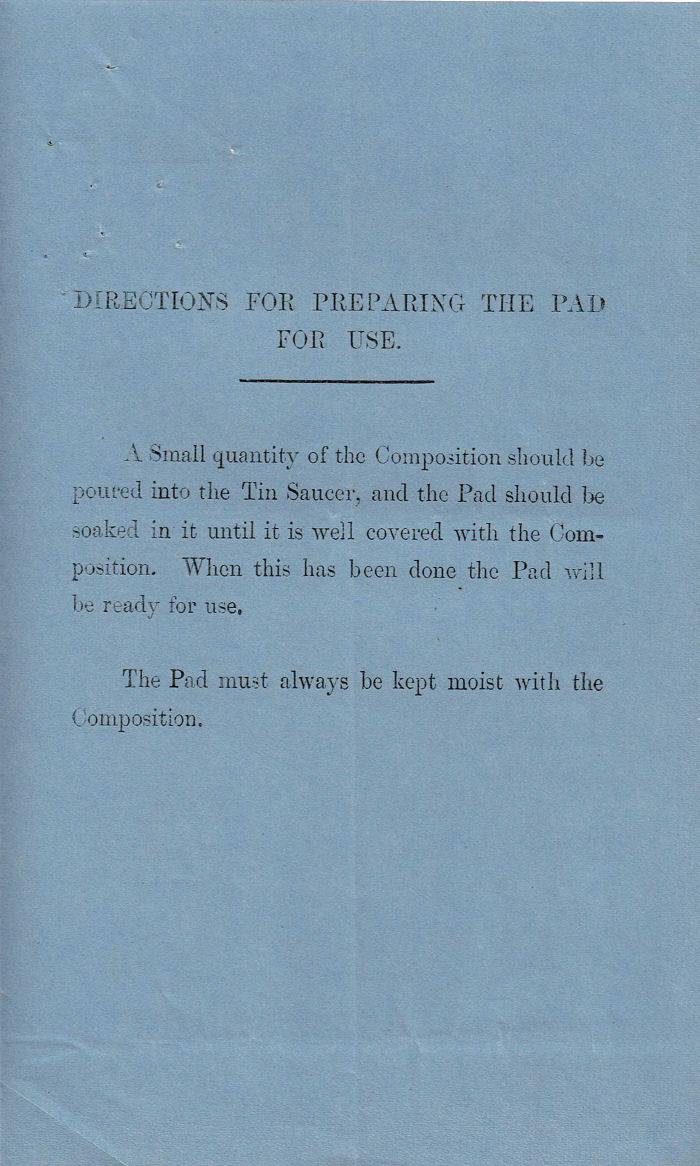
The bottom of the front has the imprint "G [719] 1800 2/70" which I take to imply that 1800 were printed in February 1870. Images courtesy of Edward Coombes.
A letter dated 7 February 1877 regarding charges relating to property.
This is an O.H.M.S. response from R.S.Culley (Richard Spelman Culley), the Engineer in Chief, GPO, London.
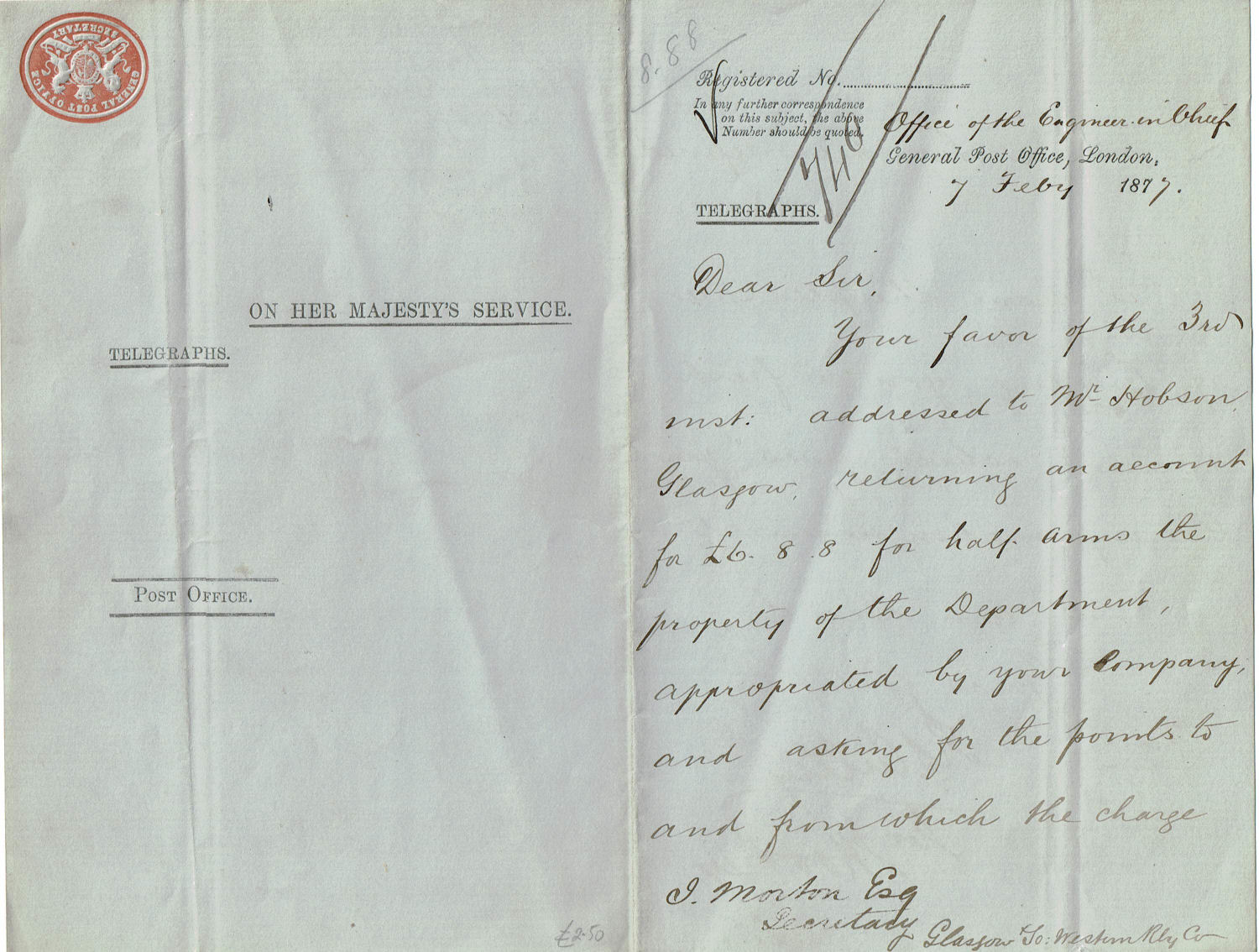
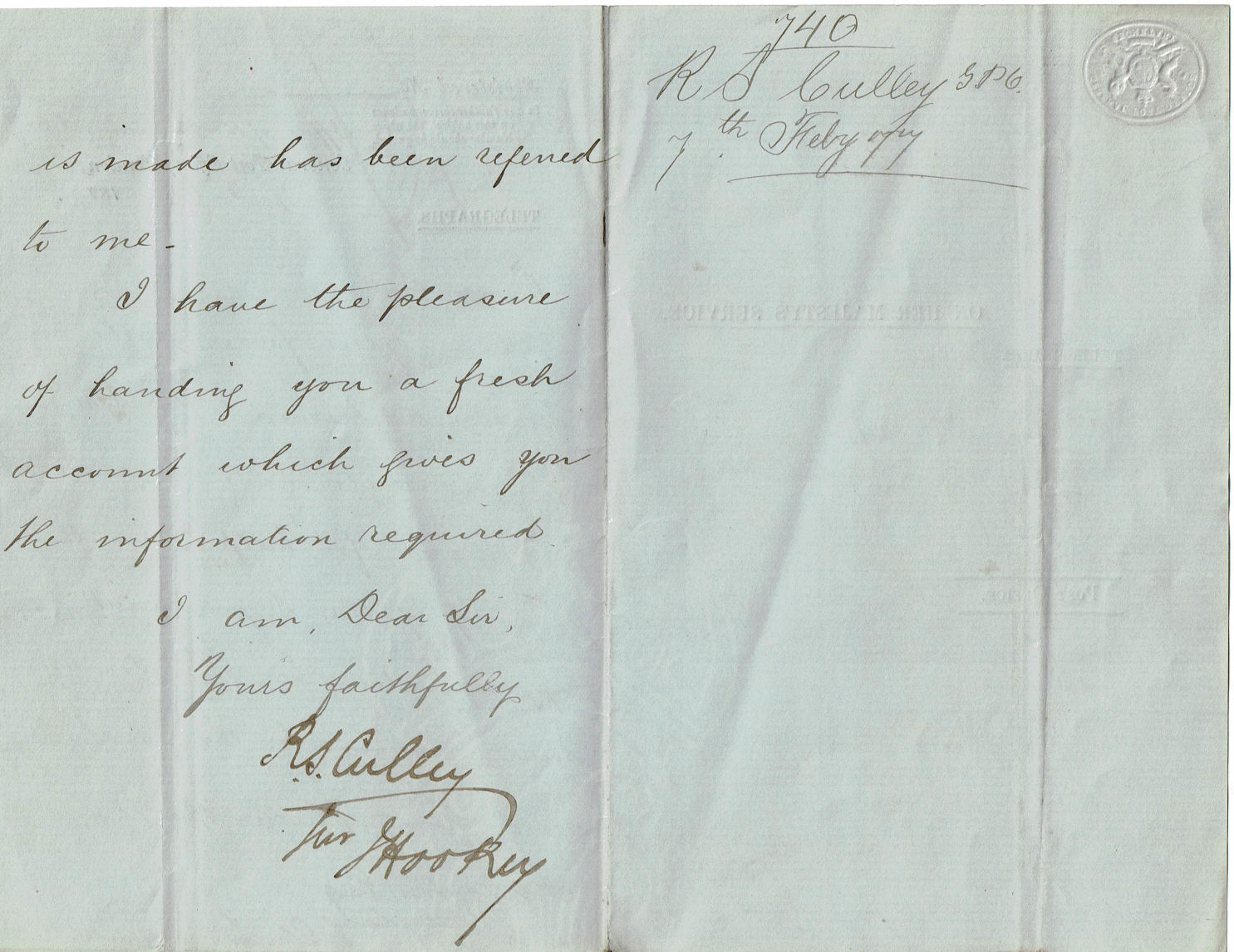
Someone has added at the bottom of the back "R.S.Culley / for Hookey", Hookey was the Secretary of the GPO". Images courtesy of Edward Coombes.
Post Office Telegraphs.—No. 103. Printed April 1872, but used in Barnsley 27 March 1877, regarding telegraph poles.
Written by Frank Ives Scudamore, Second Secretary, did the preparatory work on the nationalisation of the Private Telegraph Companies in 1868-70
as well as the financial costs and compensation schemes.
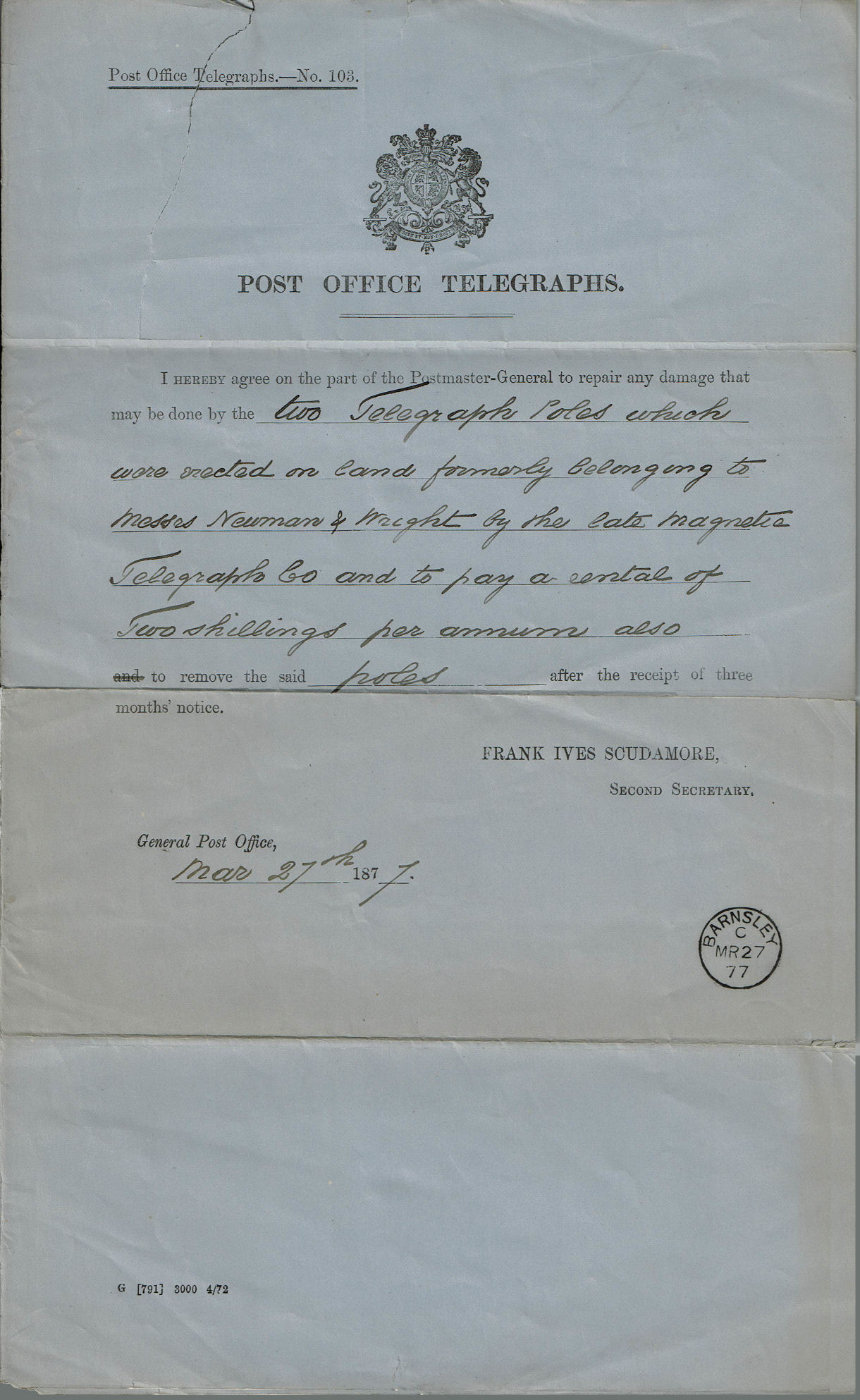
Imprint at the bottom "G [791] 3000 4/72" implying 3000 printed April 1872. Image (2 scans re-joined) courtesy of Edward Coombes.
O.H.M.S. Letter authenticated by F. Braid (Postmaster & Surveyor), used 22 March 1892 in Glasgow, reminding about £147 and 5s for rental of a Private Line (No. 40) due soon.
A subsequent receipt for that amount can be seen above.
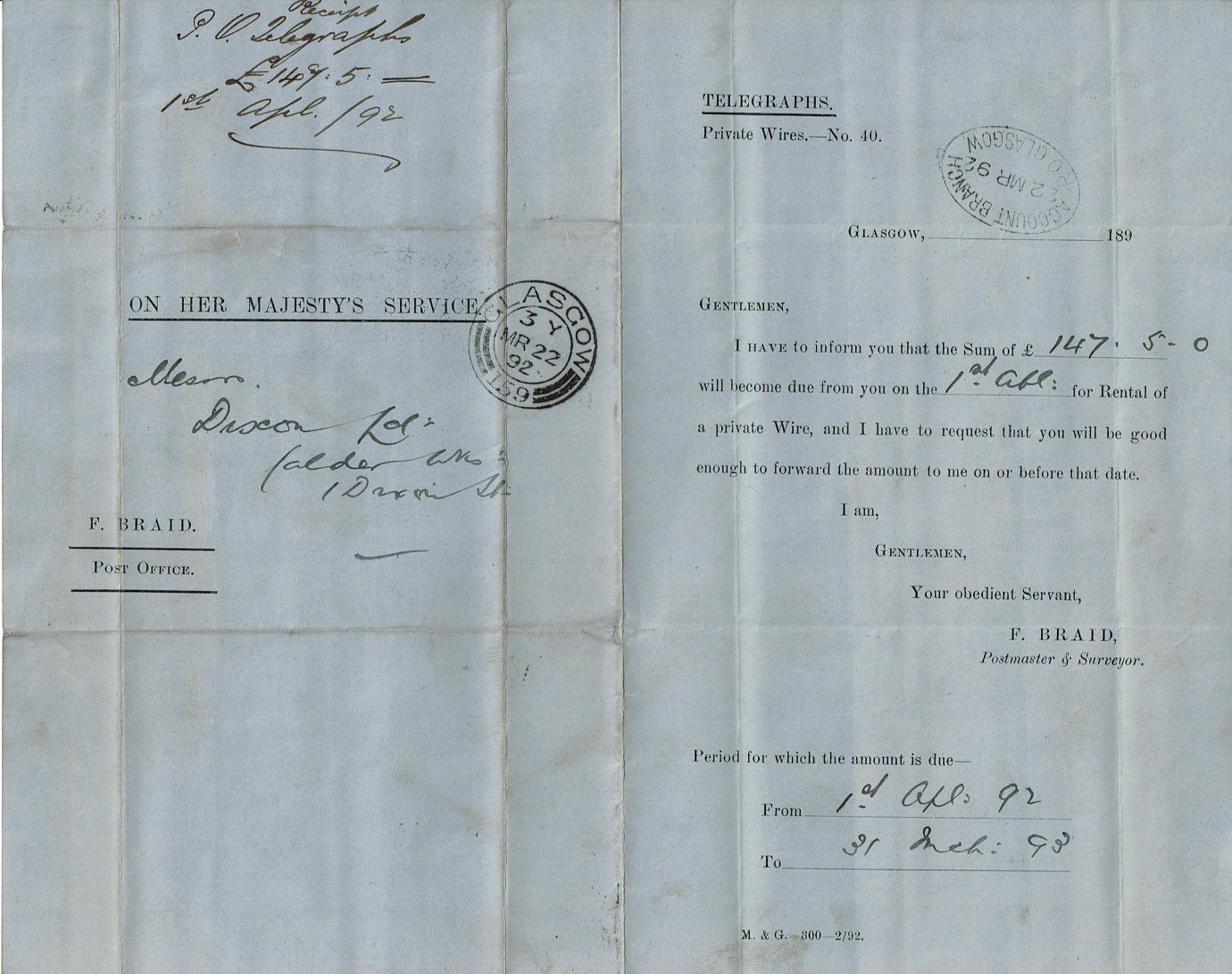
Imprint at the bottom "M. & G. - 300 — 2/92." implying 300 printed February 1892. Image courtesy of Edward Coombes.
Last updated 13th. March 2024
©Copyright Steve Panting 2012/13/14/15/16/17/18/19/20/21/22/23/24 except where stated.
Permission is hereby granted to copy material for which the copyright is owned by myself, on condition that any data is not altered and this website is given credit.